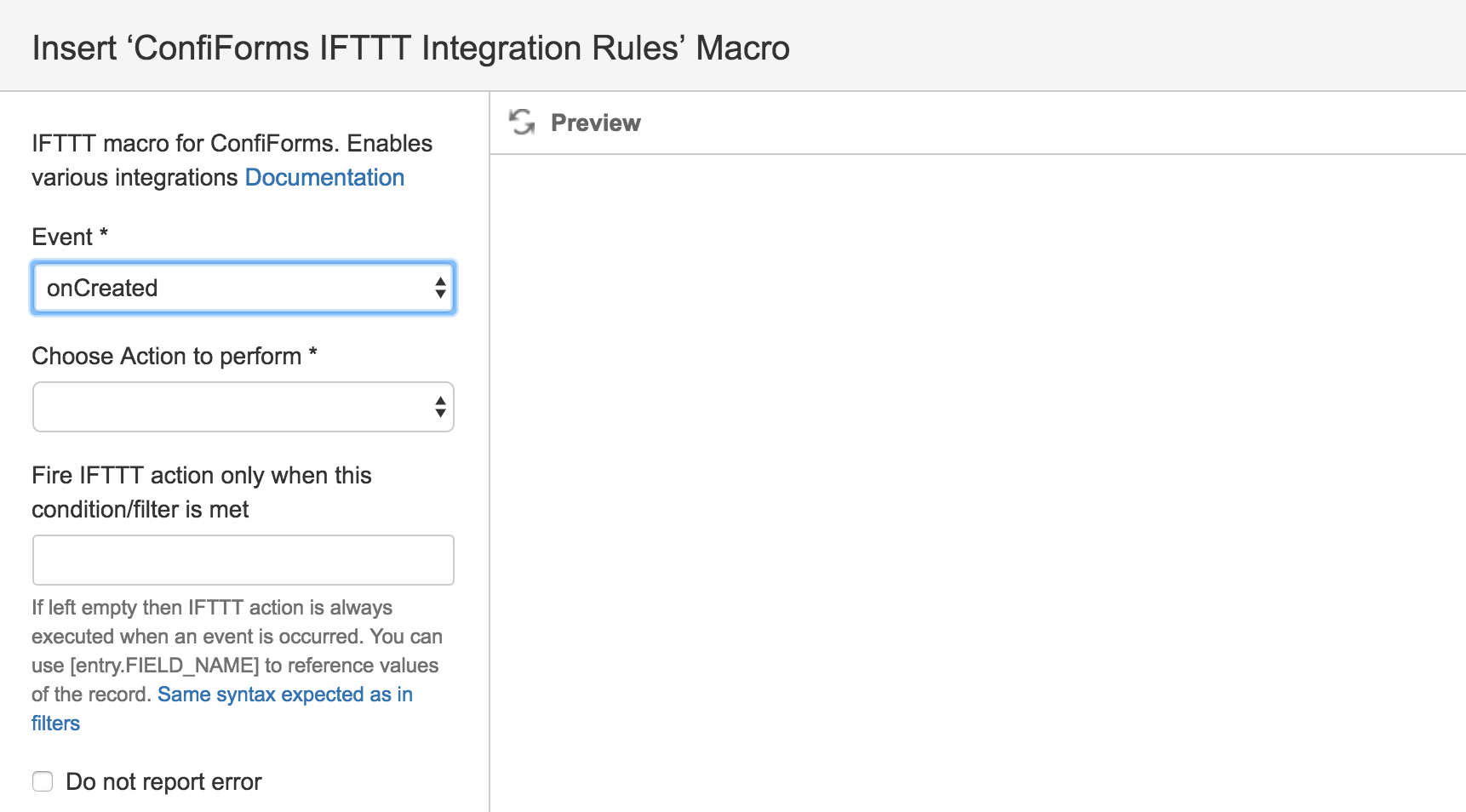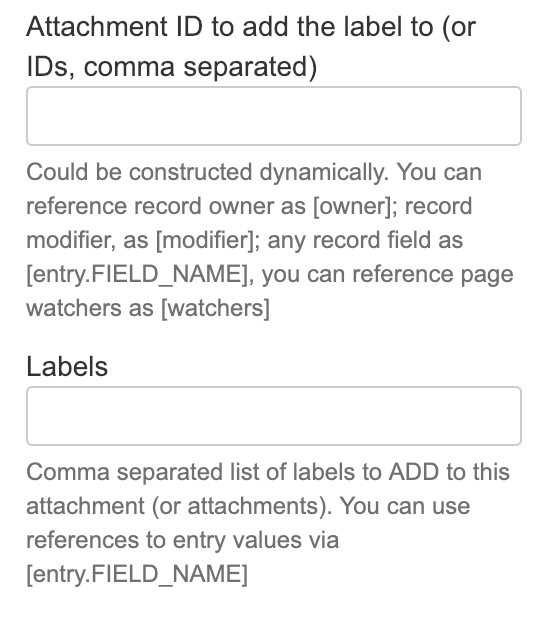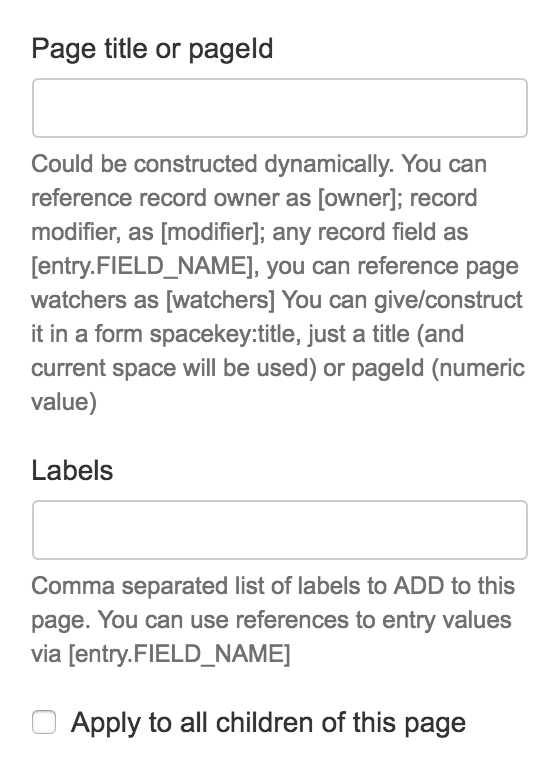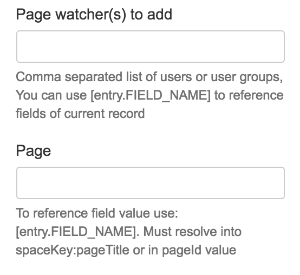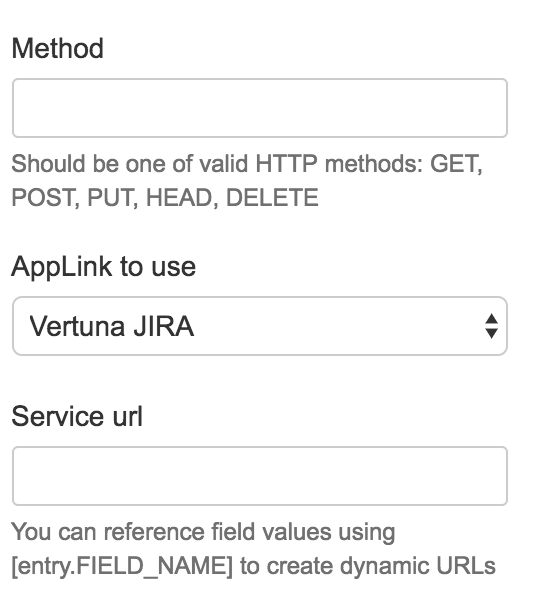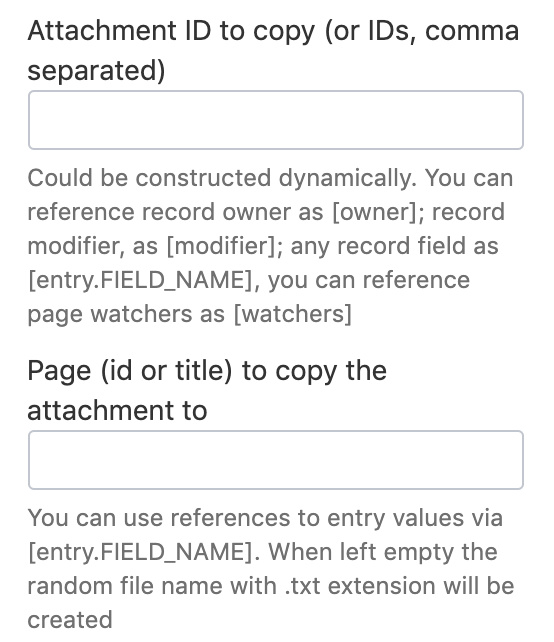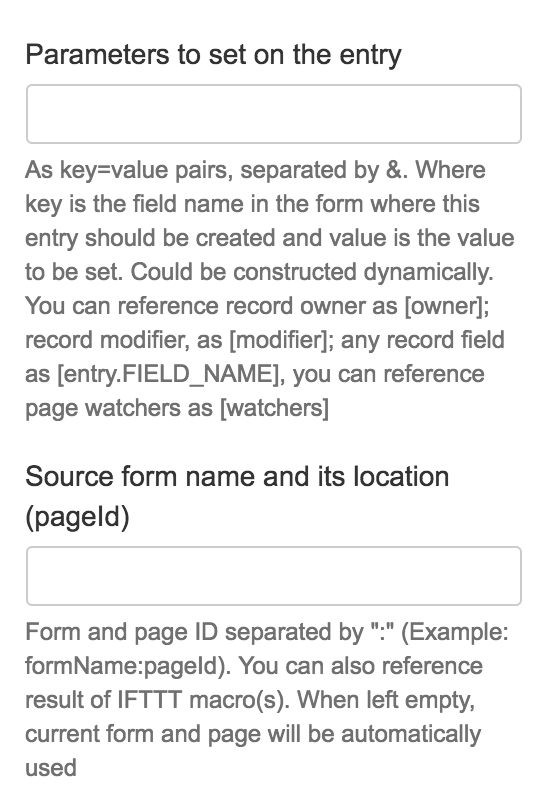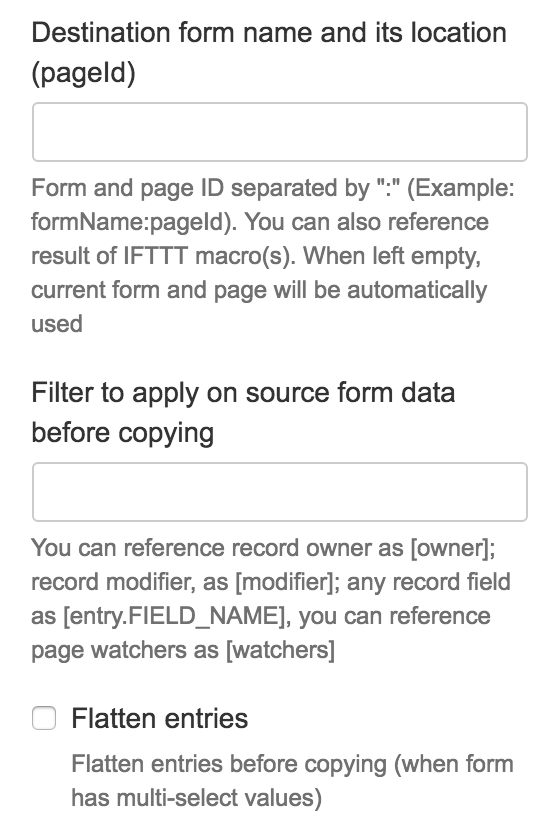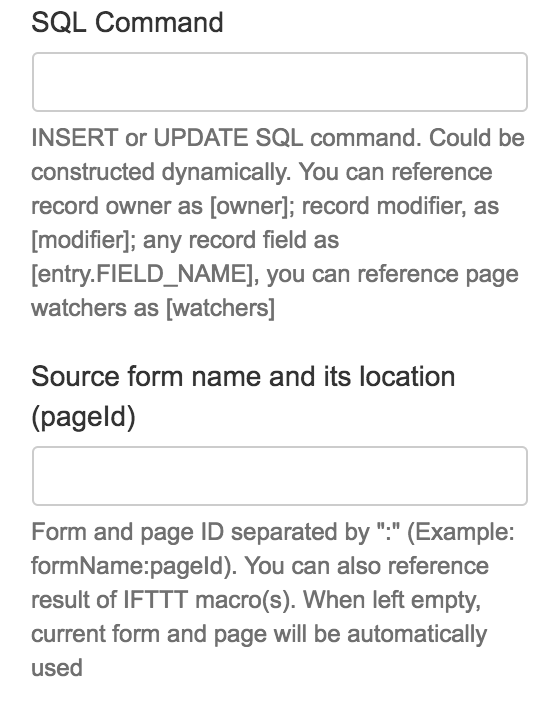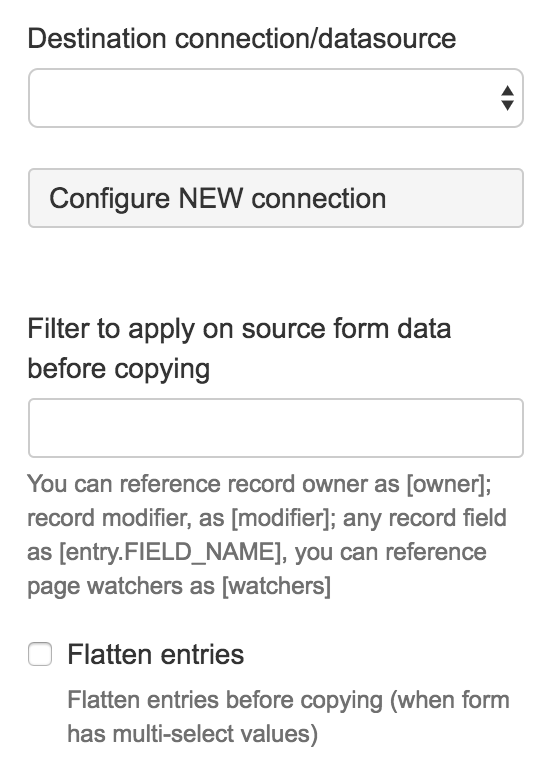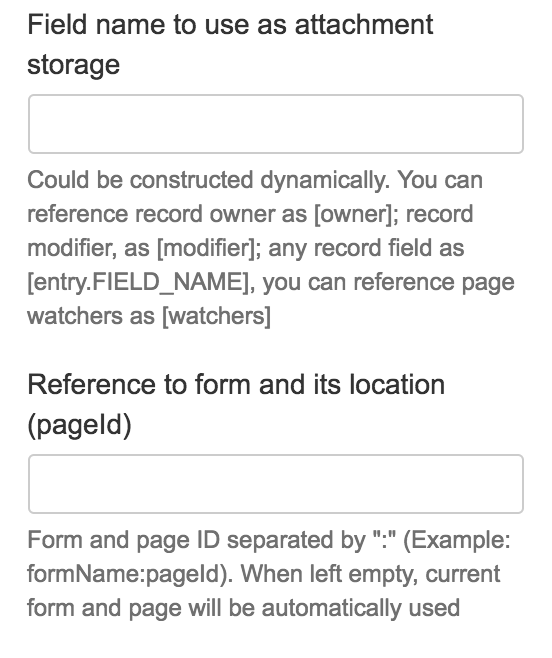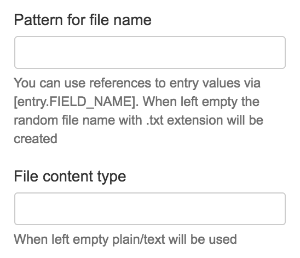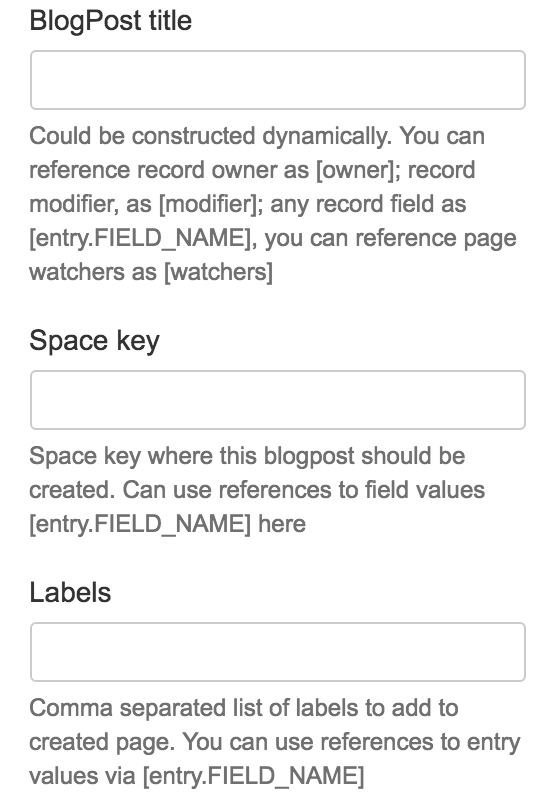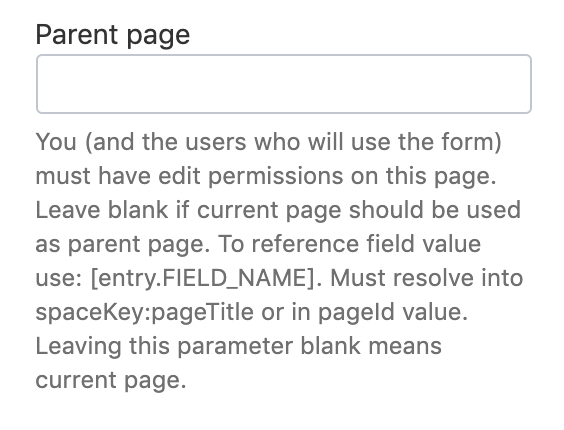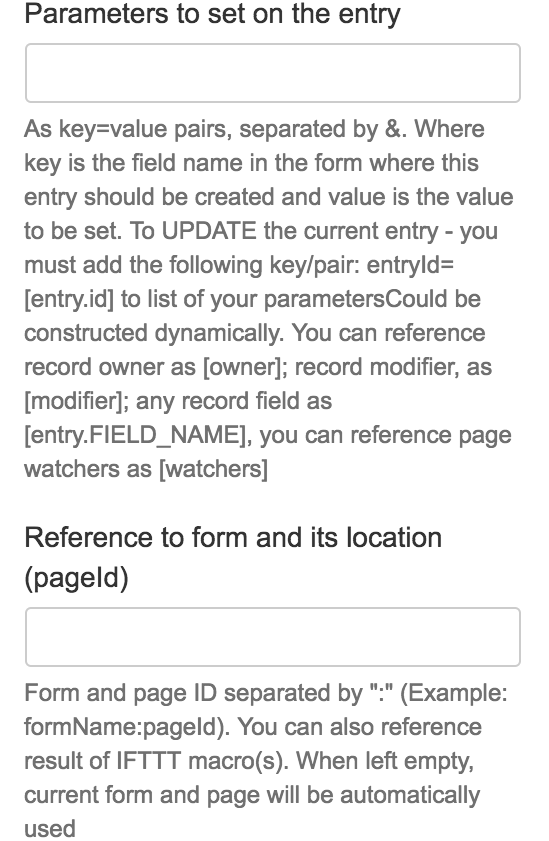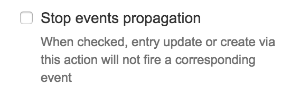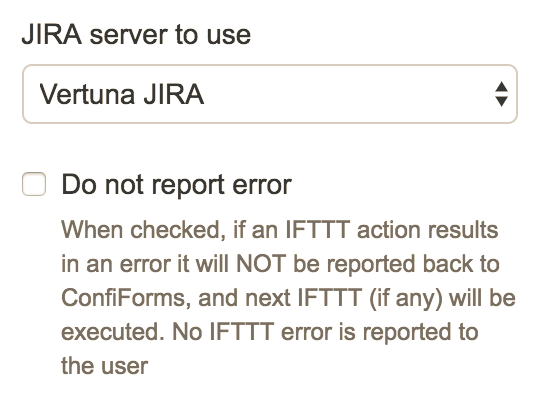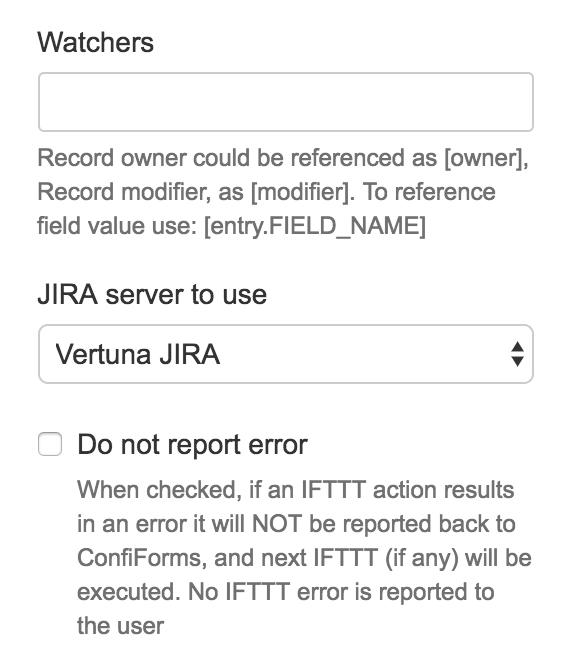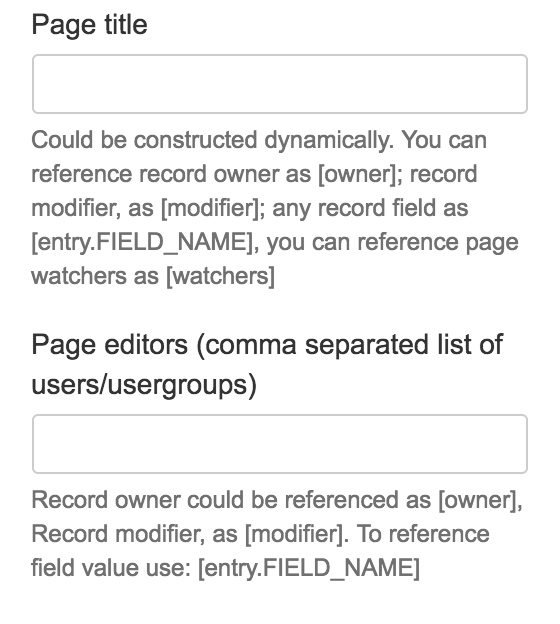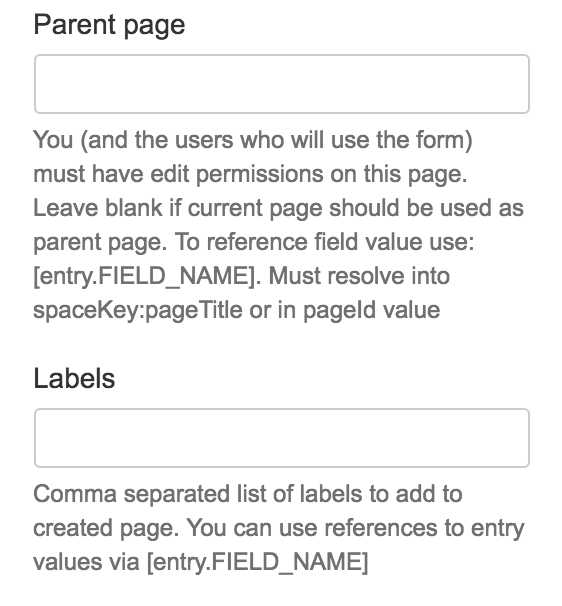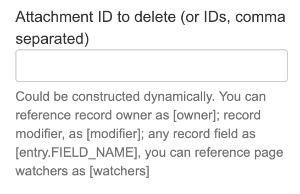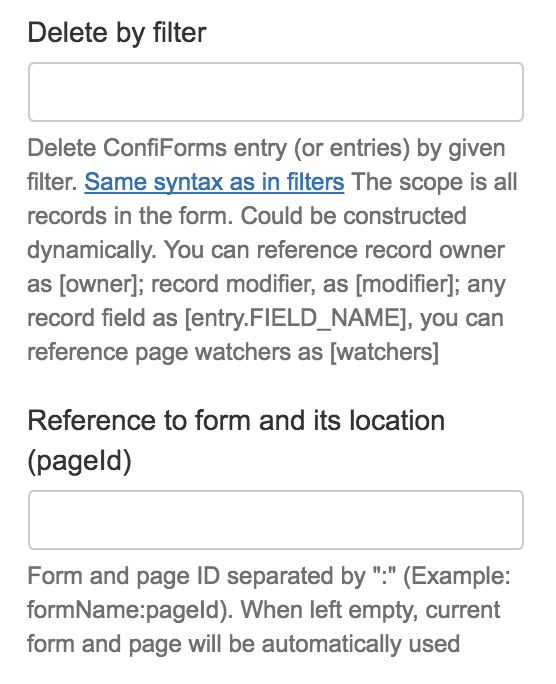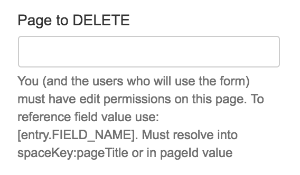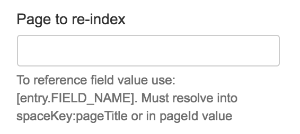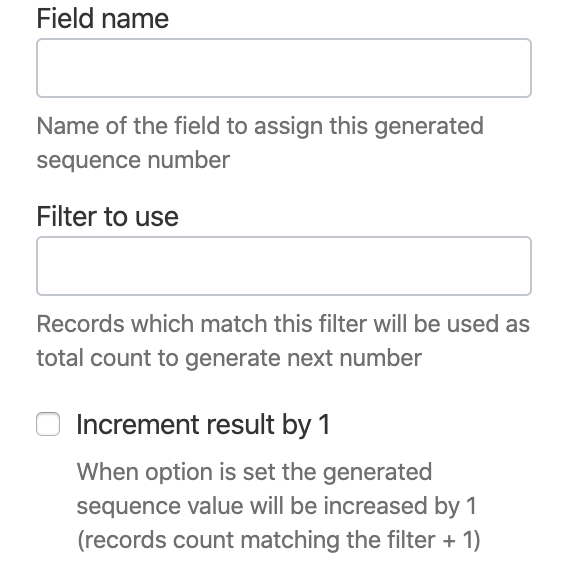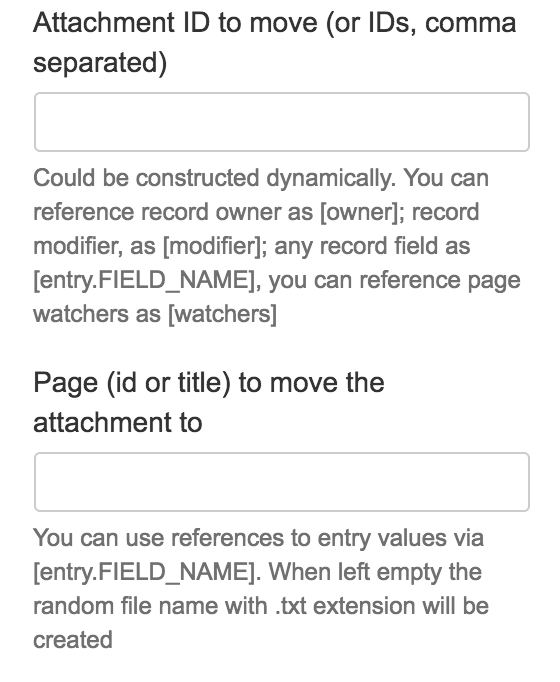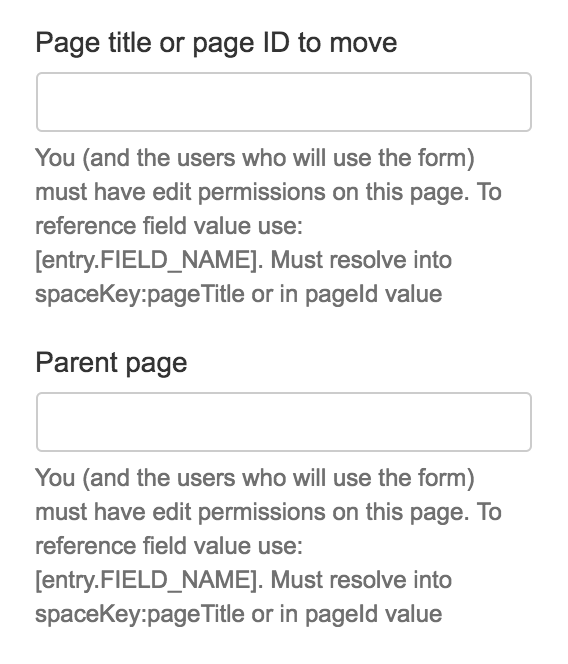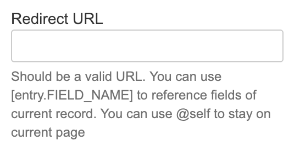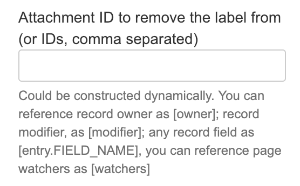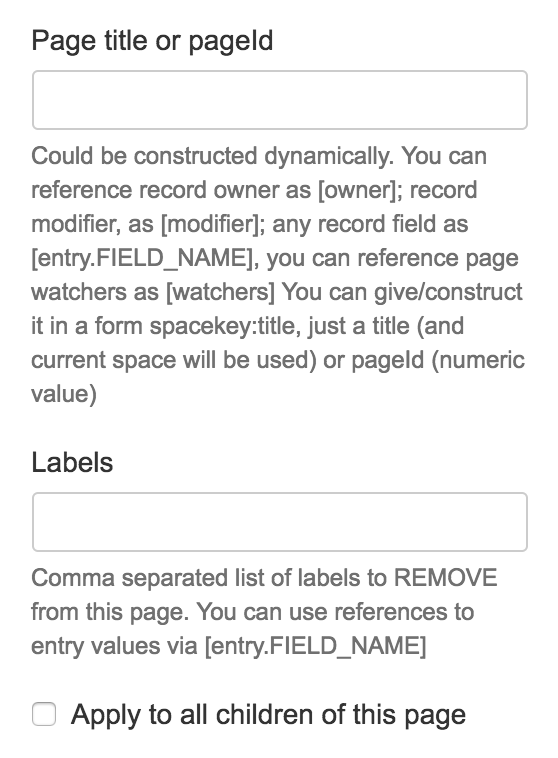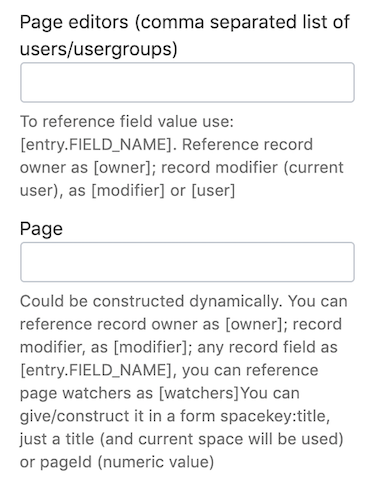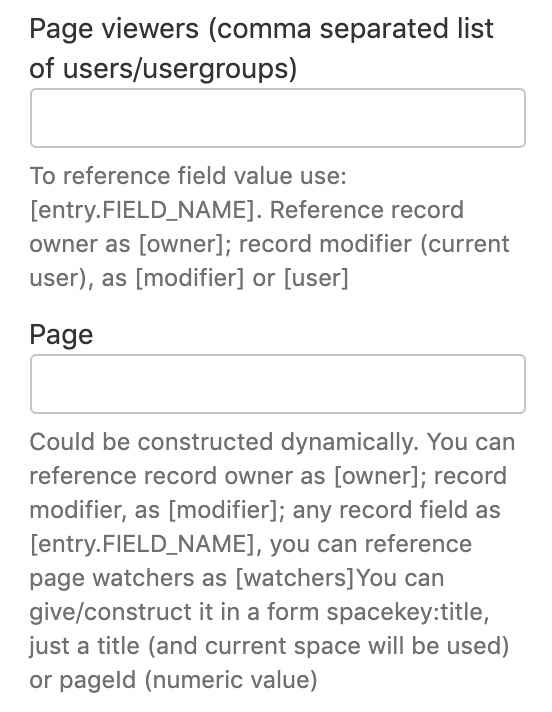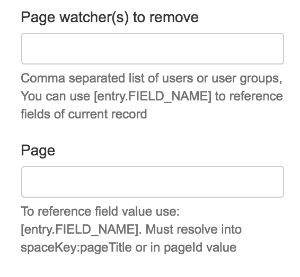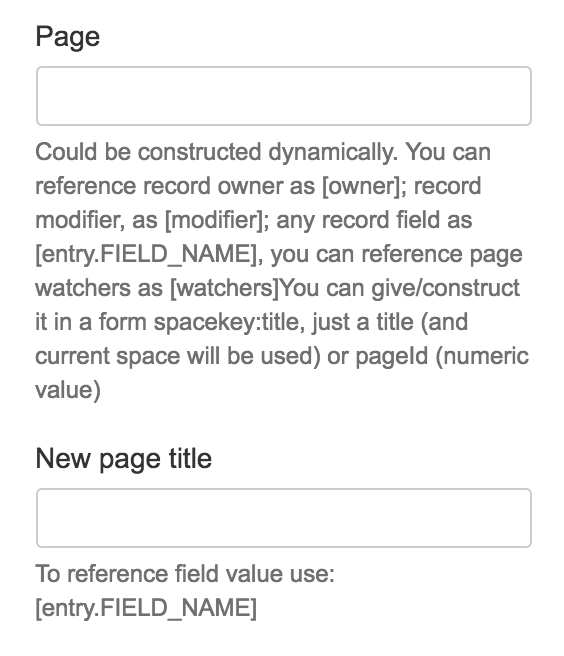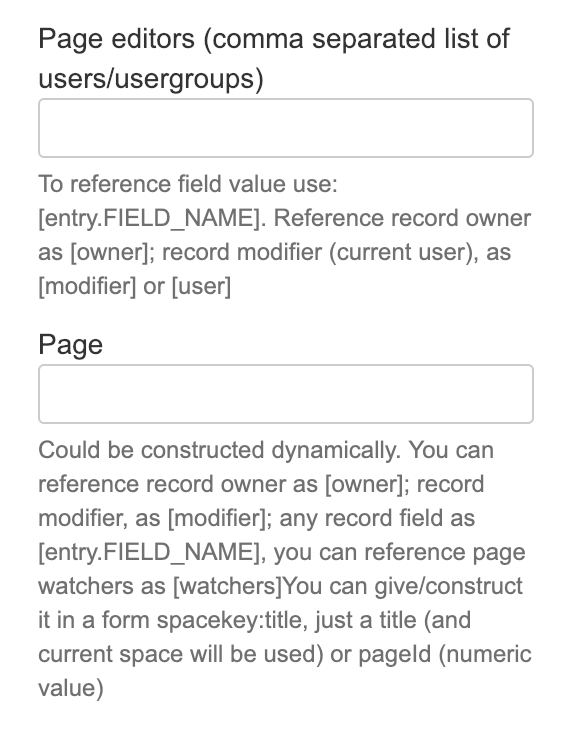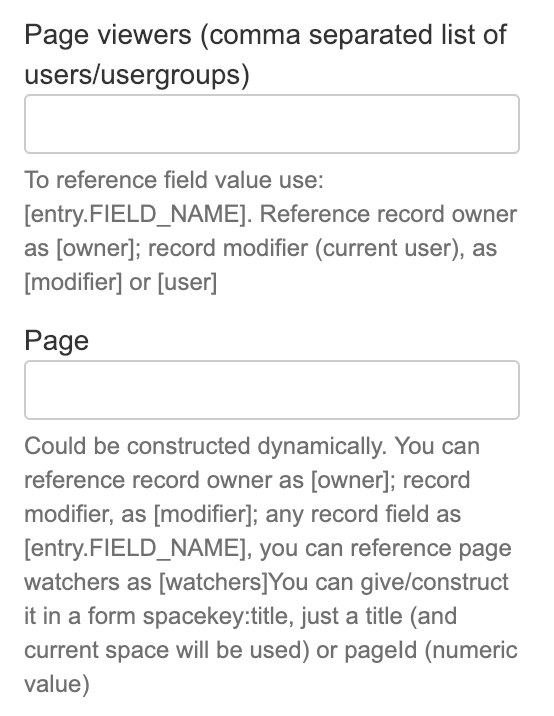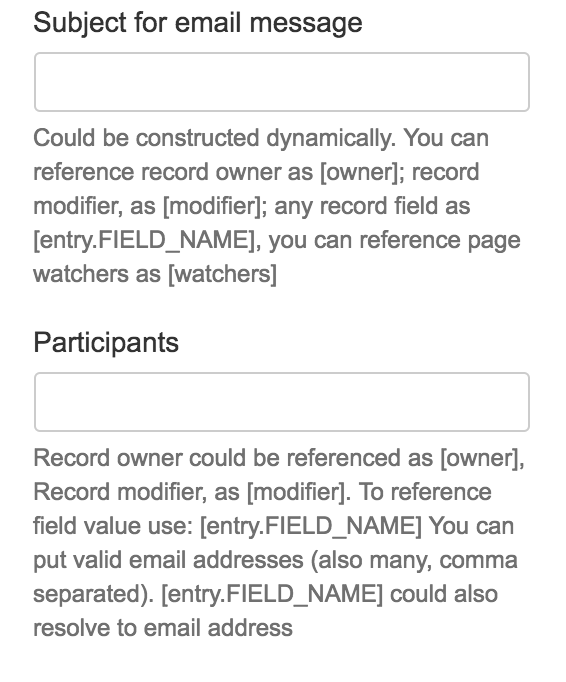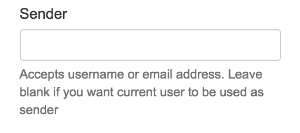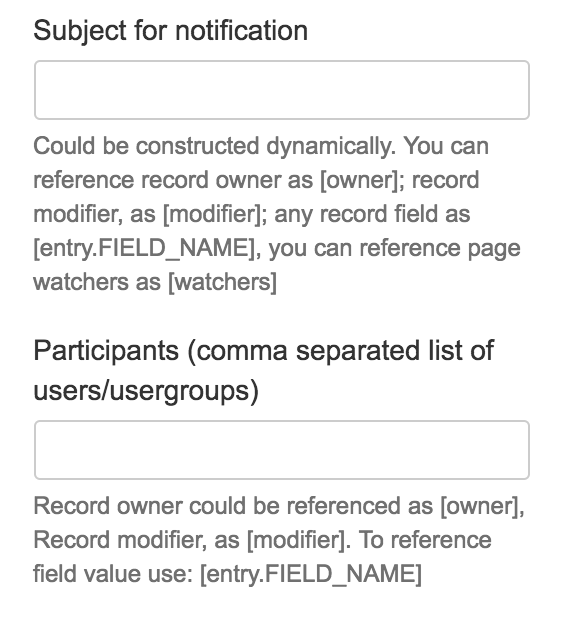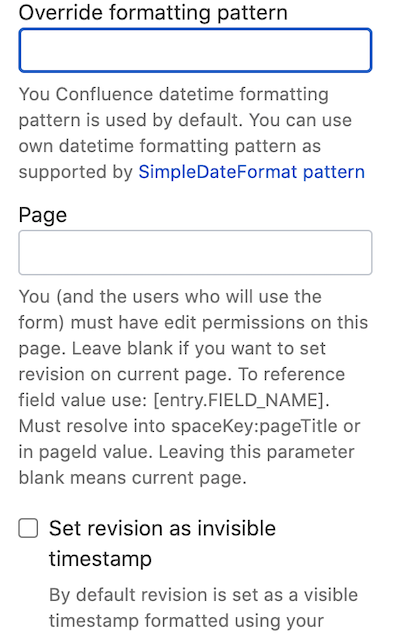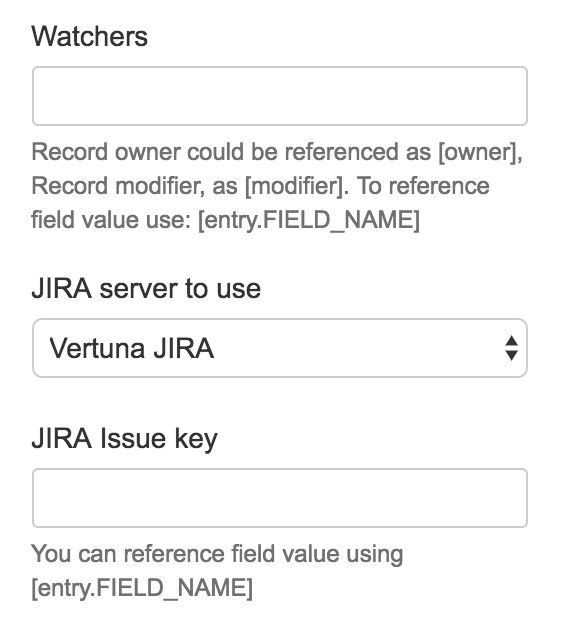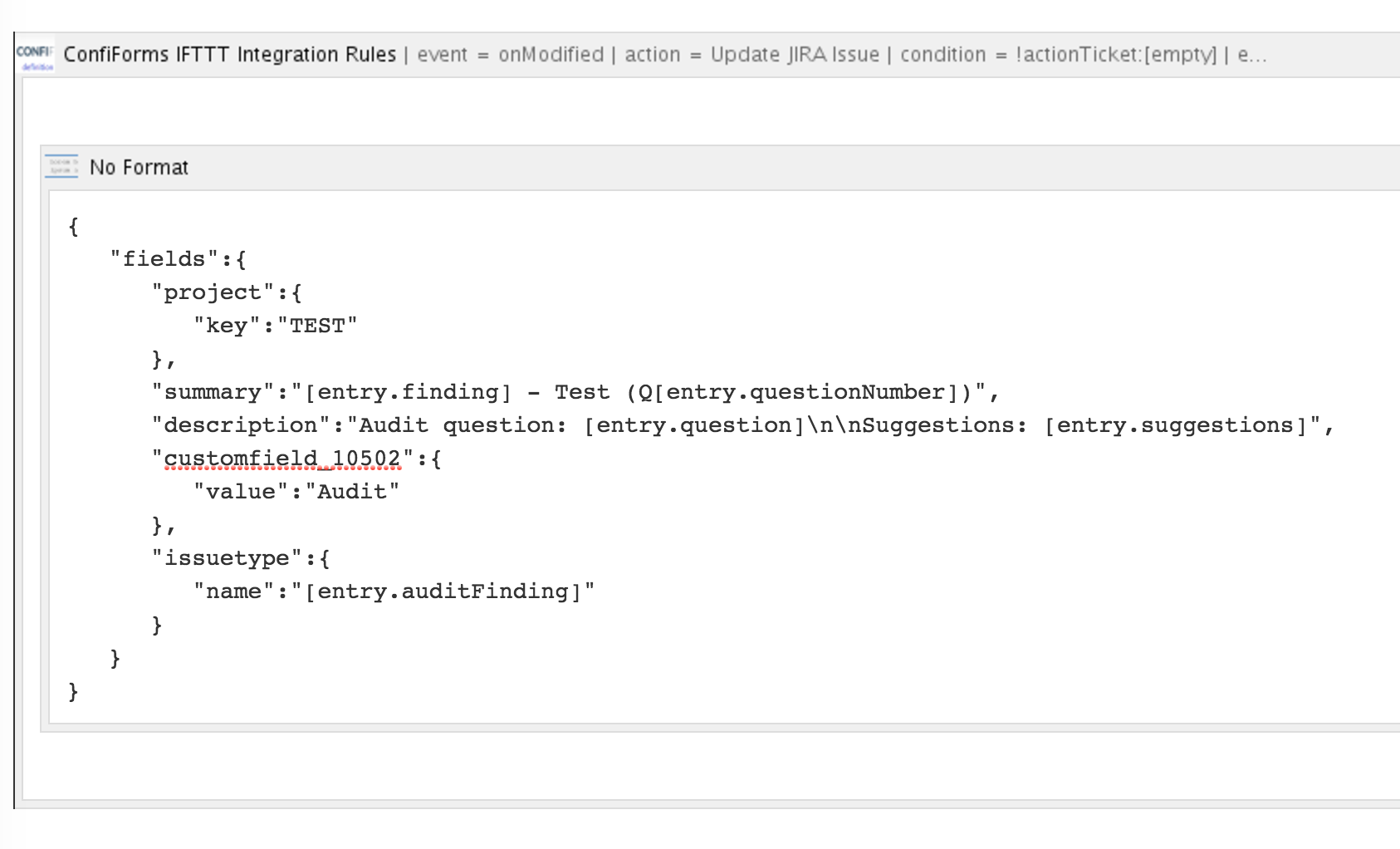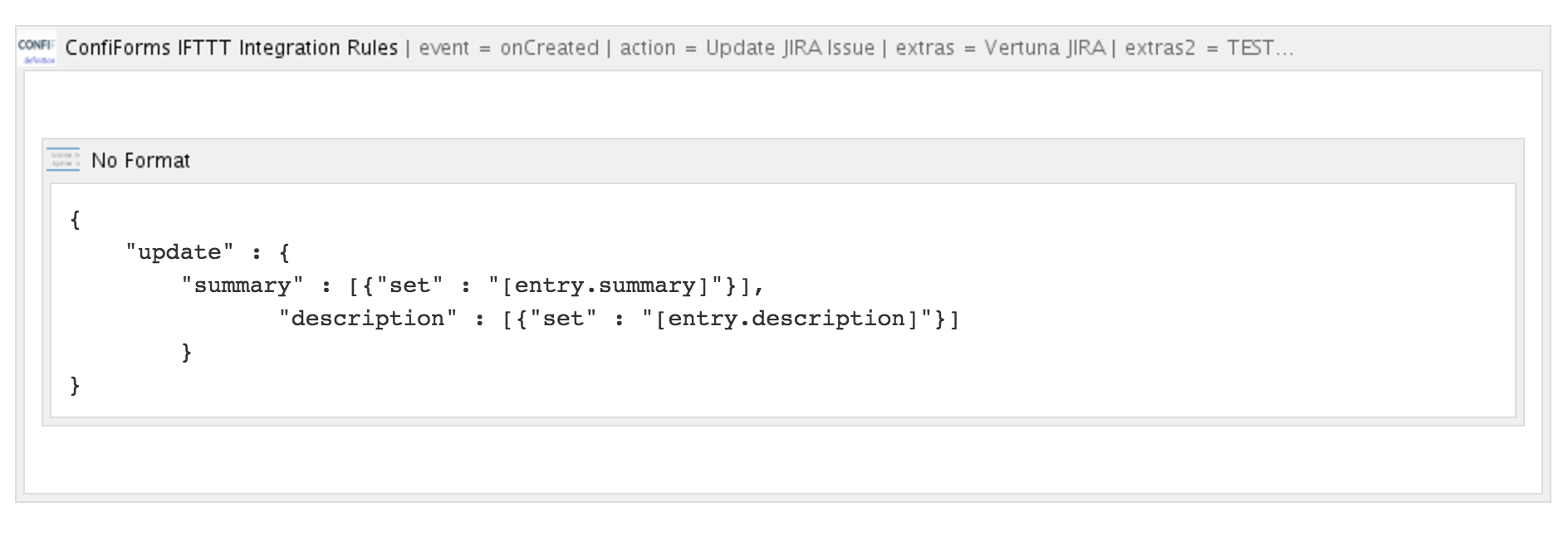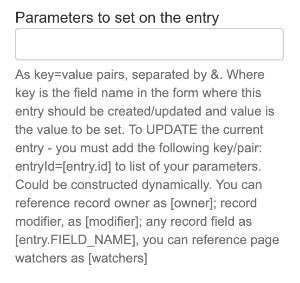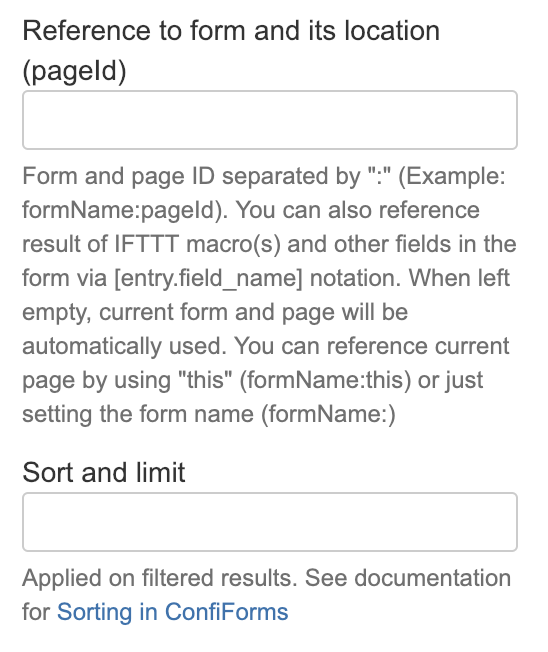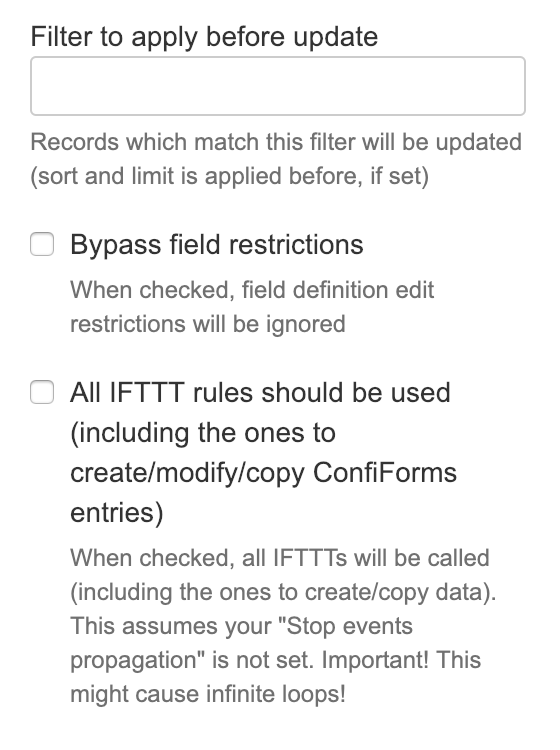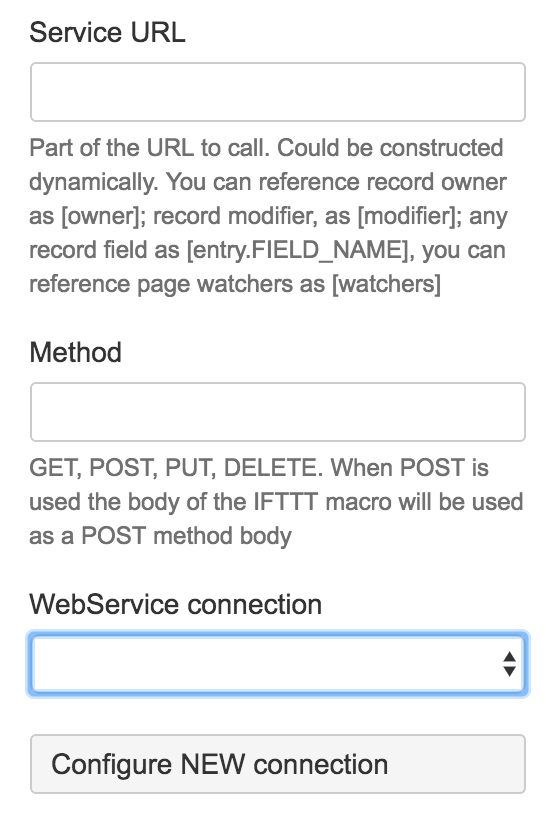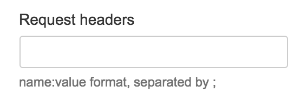This is the documentation for ConfiForms Server/Data Center app
However, this might also work for ConfiForms cloud and in most cases it does. But please see this page to understand the differences between server and cloud versions of the ConfiForms app.
ConfiForms IFTTT macro is a powerful tool which helps you to built integrations with other systems: to send emails, to create issues in Jira, to build workflows in Confluence, to organise templates and rules. And also to create various types of cool things around ConfiForms and Confluence.
Important note: IFTTT operations in ConfiForms are NOT TRANSACTIONAL, this means that the ConfiForms record save operation and the following after that IFTTT actions will be executed in own transactions. Failure of IFTTT action will NOT result in save operation rollback and the record still will be created
All the IFTTT integration operations are not transactional and executed in own scope, independently from ConfiForms internal operations
ConfiForms IFTTT macro is a part of ConfiForms Form definition and must be placed inside the ConfiForms Form macro body. You can place as many ConfiForms IFTTT macros as you want. Each macro has an event it is binded to. There are 4 types of events in ConfiForms:
- onCreated - fires AFTER the record is created
- onModified - fires AFTER the record has been modified
- onDeleted - fires AFTER the record has been deleted
- onError - fires in case if any of the previously executed IFTTT rules failed / resulted in an error
You can define the "condition", to limit the scope when action is fired. Meaning that you can define to execute an action only when certain condition is met.
Conditions macro parameter expects a filter, more about filters could be found here: ConfiForms Filters
At the moment ConfiForms IFTTT macro has 38 action types to choose from.
Each action has different set of parameters to set. In most cases you can use references to your entry fields via [entry.FIELD_NAME] in macro parameters, so these will be replaced with actual values.
Important
The execution order for actions is the same as you put them inside the ConfiForms Form macro body (obviously, filtered by event type). IFTTT execution also supports referencing of results for previous execution: Advanced integrations with IFTTT macros with ConfiForms
Below, you can find a list of integrations scenarios the macro can support and it's configuration details
Actions list
There are 38 different actions supported by IFTTT out-of-the-box (some actions are very generic, so the integration scenarios number is a lot bigger)
Each IFTTT action has own parameters, but the following parameters are supported by all actions
When specified (in the docs below, for an action) - a macro body is used as a template, otherwise leave it empty
| Parameter name | Description |
|---|---|
| Event | Type of event in ConfiForms this IFTTT action should be fired on
|
| Action to perform | One of the actions to perform. See the list above |
| Do not report error | A checkbox field to disable error reporting and continue with the workflow even if current macro has resulted in an error |
| Custom name for the action result | This is used in advanced techniques, when you want to use the result of the IFTTT in next IFTTT or want to save the result of some IFTTT or some part of the result back into a ConfiForms record. See below the result types and the contents stored in the result for each IFTTT action. A result (depending on the action type) is stored in the context in the variable prefixed by "iftttResult_" And is accessible using the Velocity notation via ${iftttResult_RESULTNAME}
or (see Velocity templates syntax for more on "!" operator)
$!{iftttResult_RESULTNAME}
Same can be archived with
[iftttResult_RESULTNAME]
since ConfiForms version 2.11
Where "RESULTNAME" is the value given in this macro parameter. Some results hold rich objects. See "Result type" section for exact IFTTT action below |
Add Attachment Label | ||||||||||||||||||||||||||||||||||||||||||||||||||||||||||||||||||||||||||||||||||||||||||||||||||||||||||||||||||||||||||||||||||||||||||||||||||||||||||||||||||||||||||||||||||||||||||||||||||||||||||||||||||||||||||||||||||||||||||||||||||||||||||||||||||||||||||||||||||||||||||||||||||||||||||||||||||||||||||||||||||||||||||||||||||||||||||||||||||||||||||||||||||||||||||||||||||||||||||||||||||||||||||||||||||||||||||||||||||||||||||||||||||||||||||||||||||||||||||||||||||||||||||||||||||||||||||||||||||||||||||||||||||||||||||||||||||||||||||||||||||||||||||||||||||
|---|---|---|---|---|---|---|---|---|---|---|---|---|---|---|---|---|---|---|---|---|---|---|---|---|---|---|---|---|---|---|---|---|---|---|---|---|---|---|---|---|---|---|---|---|---|---|---|---|---|---|---|---|---|---|---|---|---|---|---|---|---|---|---|---|---|---|---|---|---|---|---|---|---|---|---|---|---|---|---|---|---|---|---|---|---|---|---|---|---|---|---|---|---|---|---|---|---|---|---|---|---|---|---|---|---|---|---|---|---|---|---|---|---|---|---|---|---|---|---|---|---|---|---|---|---|---|---|---|---|---|---|---|---|---|---|---|---|---|---|---|---|---|---|---|---|---|---|---|---|---|---|---|---|---|---|---|---|---|---|---|---|---|---|---|---|---|---|---|---|---|---|---|---|---|---|---|---|---|---|---|---|---|---|---|---|---|---|---|---|---|---|---|---|---|---|---|---|---|---|---|---|---|---|---|---|---|---|---|---|---|---|---|---|---|---|---|---|---|---|---|---|---|---|---|---|---|---|---|---|---|---|---|---|---|---|---|---|---|---|---|---|---|---|---|---|---|---|---|---|---|---|---|---|---|---|---|---|---|---|---|---|---|---|---|---|---|---|---|---|---|---|---|---|---|---|---|---|---|---|---|---|---|---|---|---|---|---|---|---|---|---|---|---|---|---|---|---|---|---|---|---|---|---|---|---|---|---|---|---|---|---|---|---|---|---|---|---|---|---|---|---|---|---|---|---|---|---|---|---|---|---|---|---|---|---|---|---|---|---|---|---|---|---|---|---|---|---|---|---|---|---|---|---|---|---|---|---|---|---|---|---|---|---|---|---|---|---|---|---|---|---|---|---|---|---|---|---|---|---|---|---|---|---|---|---|---|---|---|---|---|---|---|---|---|---|---|---|---|---|---|---|---|---|---|---|---|---|---|---|---|---|---|---|---|---|---|---|---|---|---|---|---|---|---|---|---|---|---|---|---|---|---|---|---|---|---|---|---|---|---|---|---|---|---|---|---|---|---|---|---|---|---|---|---|---|---|---|---|---|---|---|---|---|---|---|---|---|---|---|---|---|---|---|---|---|---|---|---|---|---|---|---|---|---|---|---|---|---|---|---|---|---|---|---|---|---|---|---|---|---|---|---|---|---|---|---|---|---|---|---|---|---|---|---|---|---|---|---|---|---|---|---|---|---|---|---|---|---|---|---|---|---|---|---|---|---|---|---|---|---|---|---|---|---|---|---|---|---|---|---|---|---|---|---|---|---|---|---|---|---|---|---|---|---|---|---|---|---|---|---|---|---|---|---|---|---|---|---|
| Add a label or labels to attachment | ||||||||||||||||||||||||||||||||||||||||||||||||||||||||||||||||||||||||||||||||||||||||||||||||||||||||||||||||||||||||||||||||||||||||||||||||||||||||||||||||||||||||||||||||||||||||||||||||||||||||||||||||||||||||||||||||||||||||||||||||||||||||||||||||||||||||||||||||||||||||||||||||||||||||||||||||||||||||||||||||||||||||||||||||||||||||||||||||||||||||||||||||||||||||||||||||||||||||||||||||||||||||||||||||||||||||||||||||||||||||||||||||||||||||||||||||||||||||||||||||||||||||||||||||||||||||||||||||||||||||||||||||||||||||||||||||||||||||||||||||||||||||||||||||||
| Result type: | NO RESULT | |||||||||||||||||||||||||||||||||||||||||||||||||||||||||||||||||||||||||||||||||||||||||||||||||||||||||||||||||||||||||||||||||||||||||||||||||||||||||||||||||||||||||||||||||||||||||||||||||||||||||||||||||||||||||||||||||||||||||||||||||||||||||||||||||||||||||||||||||||||||||||||||||||||||||||||||||||||||||||||||||||||||||||||||||||||||||||||||||||||||||||||||||||||||||||||||||||||||||||||||||||||||||||||||||||||||||||||||||||||||||||||||||||||||||||||||||||||||||||||||||||||||||||||||||||||||||||||||||||||||||||||||||||||||||||||||||||||||||||||||||||||||||||||||||
Add Page Label | ||||||||||||||||||||||||||||||||||||||||||||||||||||||||||||||||||||||||||||||||||||||||||||||||||||||||||||||||||||||||||||||||||||||||||||||||||||||||||||||||||||||||||||||||||||||||||||||||||||||||||||||||||||||||||||||||||||||||||||||||||||||||||||||||||||||||||||||||||||||||||||||||||||||||||||||||||||||||||||||||||||||||||||||||||||||||||||||||||||||||||||||||||||||||||||||||||||||||||||||||||||||||||||||||||||||||||||||||||||||||||||||||||||||||||||||||||||||||||||||||||||||||||||||||||||||||||||||||||||||||||||||||||||||||||||||||||||||||||||||||||||||||||||||||||
Adds label to a page, you can apply a label (or labels) to page sub-pages as well | ||||||||||||||||||||||||||||||||||||||||||||||||||||||||||||||||||||||||||||||||||||||||||||||||||||||||||||||||||||||||||||||||||||||||||||||||||||||||||||||||||||||||||||||||||||||||||||||||||||||||||||||||||||||||||||||||||||||||||||||||||||||||||||||||||||||||||||||||||||||||||||||||||||||||||||||||||||||||||||||||||||||||||||||||||||||||||||||||||||||||||||||||||||||||||||||||||||||||||||||||||||||||||||||||||||||||||||||||||||||||||||||||||||||||||||||||||||||||||||||||||||||||||||||||||||||||||||||||||||||||||||||||||||||||||||||||||||||||||||||||||||||||||||||||||
| Result type: | NO RESULT | |||||||||||||||||||||||||||||||||||||||||||||||||||||||||||||||||||||||||||||||||||||||||||||||||||||||||||||||||||||||||||||||||||||||||||||||||||||||||||||||||||||||||||||||||||||||||||||||||||||||||||||||||||||||||||||||||||||||||||||||||||||||||||||||||||||||||||||||||||||||||||||||||||||||||||||||||||||||||||||||||||||||||||||||||||||||||||||||||||||||||||||||||||||||||||||||||||||||||||||||||||||||||||||||||||||||||||||||||||||||||||||||||||||||||||||||||||||||||||||||||||||||||||||||||||||||||||||||||||||||||||||||||||||||||||||||||||||||||||||||||||||||||||||||||
Add Page Watcher | ||||||||||||||||||||||||||||||||||||||||||||||||||||||||||||||||||||||||||||||||||||||||||||||||||||||||||||||||||||||||||||||||||||||||||||||||||||||||||||||||||||||||||||||||||||||||||||||||||||||||||||||||||||||||||||||||||||||||||||||||||||||||||||||||||||||||||||||||||||||||||||||||||||||||||||||||||||||||||||||||||||||||||||||||||||||||||||||||||||||||||||||||||||||||||||||||||||||||||||||||||||||||||||||||||||||||||||||||||||||||||||||||||||||||||||||||||||||||||||||||||||||||||||||||||||||||||||||||||||||||||||||||||||||||||||||||||||||||||||||||||||||||||||||||||
| Adds a user or group of users as a page watcher | ||||||||||||||||||||||||||||||||||||||||||||||||||||||||||||||||||||||||||||||||||||||||||||||||||||||||||||||||||||||||||||||||||||||||||||||||||||||||||||||||||||||||||||||||||||||||||||||||||||||||||||||||||||||||||||||||||||||||||||||||||||||||||||||||||||||||||||||||||||||||||||||||||||||||||||||||||||||||||||||||||||||||||||||||||||||||||||||||||||||||||||||||||||||||||||||||||||||||||||||||||||||||||||||||||||||||||||||||||||||||||||||||||||||||||||||||||||||||||||||||||||||||||||||||||||||||||||||||||||||||||||||||||||||||||||||||||||||||||||||||||||||||||||||||||
| Result type: | Page object (page where the watcher's were added) Depending on the IFTTT result name you can access all of the properties available from Page object. For example (when result name is MYRESULT) ${iftttResult_MYRESULT.id}
${iftttResult_MYRESULT.spaceKey}
${iftttResult_MYRESULT.displayTitle}
Same can be archived with
[iftttResult_RESULTNAME.id]
[iftttResult_RESULTNAME.spaceKey]
[iftttResult_RESULTNAME.displayTitle]
since ConfiForms version 2.11
Any other property, which Page object provide (any "get" method) | |||||||||||||||||||||||||||||||||||||||||||||||||||||||||||||||||||||||||||||||||||||||||||||||||||||||||||||||||||||||||||||||||||||||||||||||||||||||||||||||||||||||||||||||||||||||||||||||||||||||||||||||||||||||||||||||||||||||||||||||||||||||||||||||||||||||||||||||||||||||||||||||||||||||||||||||||||||||||||||||||||||||||||||||||||||||||||||||||||||||||||||||||||||||||||||||||||||||||||||||||||||||||||||||||||||||||||||||||||||||||||||||||||||||||||||||||||||||||||||||||||||||||||||||||||||||||||||||||||||||||||||||||||||||||||||||||||||||||||||||||||||||||||||||||
Applink Service | ||||||||||||||||||||||||||||||||||||||||||||||||||||||||||||||||||||||||||||||||||||||||||||||||||||||||||||||||||||||||||||||||||||||||||||||||||||||||||||||||||||||||||||||||||||||||||||||||||||||||||||||||||||||||||||||||||||||||||||||||||||||||||||||||||||||||||||||||||||||||||||||||||||||||||||||||||||||||||||||||||||||||||||||||||||||||||||||||||||||||||||||||||||||||||||||||||||||||||||||||||||||||||||||||||||||||||||||||||||||||||||||||||||||||||||||||||||||||||||||||||||||||||||||||||||||||||||||||||||||||||||||||||||||||||||||||||||||||||||||||||||||||||||||||||
Sends a request to configured Application link service A user specifies which HTTP method to use, which URL service to execute (url must be given as "relative" url, this means it is "concatenated" with the base url in your applink service) More about Application links in Confluence could be found here: https://confluence.atlassian.com/display/APPLINKS/Application+Links+Documentation | ||||||||||||||||||||||||||||||||||||||||||||||||||||||||||||||||||||||||||||||||||||||||||||||||||||||||||||||||||||||||||||||||||||||||||||||||||||||||||||||||||||||||||||||||||||||||||||||||||||||||||||||||||||||||||||||||||||||||||||||||||||||||||||||||||||||||||||||||||||||||||||||||||||||||||||||||||||||||||||||||||||||||||||||||||||||||||||||||||||||||||||||||||||||||||||||||||||||||||||||||||||||||||||||||||||||||||||||||||||||||||||||||||||||||||||||||||||||||||||||||||||||||||||||||||||||||||||||||||||||||||||||||||||||||||||||||||||||||||||||||||||||||||||||||||
| Result type: | Response returned from a request to a service is returned and stored as result If response is a JSON then you can apply Virtual functions to work on a JSON object Please note that virtual functions could be applied only on ConfiForms fields, not the IFTTT result directly. This means you will need to save the response to some ConfiForms field temporarily in order to apply the functions and convert the response to JSON. | |||||||||||||||||||||||||||||||||||||||||||||||||||||||||||||||||||||||||||||||||||||||||||||||||||||||||||||||||||||||||||||||||||||||||||||||||||||||||||||||||||||||||||||||||||||||||||||||||||||||||||||||||||||||||||||||||||||||||||||||||||||||||||||||||||||||||||||||||||||||||||||||||||||||||||||||||||||||||||||||||||||||||||||||||||||||||||||||||||||||||||||||||||||||||||||||||||||||||||||||||||||||||||||||||||||||||||||||||||||||||||||||||||||||||||||||||||||||||||||||||||||||||||||||||||||||||||||||||||||||||||||||||||||||||||||||||||||||||||||||||||||||||||||||||
Audit | ||||||||||||||||||||||||||||||||||||||||||||||||||||||||||||||||||||||||||||||||||||||||||||||||||||||||||||||||||||||||||||||||||||||||||||||||||||||||||||||||||||||||||||||||||||||||||||||||||||||||||||||||||||||||||||||||||||||||||||||||||||||||||||||||||||||||||||||||||||||||||||||||||||||||||||||||||||||||||||||||||||||||||||||||||||||||||||||||||||||||||||||||||||||||||||||||||||||||||||||||||||||||||||||||||||||||||||||||||||||||||||||||||||||||||||||||||||||||||||||||||||||||||||||||||||||||||||||||||||||||||||||||||||||||||||||||||||||||||||||||||||||||||||||||||
| Automatic audit for your form. Audit form with <form_name>_log is created for you automatically, with a field referencing your <form_name> | ||||||||||||||||||||||||||||||||||||||||||||||||||||||||||||||||||||||||||||||||||||||||||||||||||||||||||||||||||||||||||||||||||||||||||||||||||||||||||||||||||||||||||||||||||||||||||||||||||||||||||||||||||||||||||||||||||||||||||||||||||||||||||||||||||||||||||||||||||||||||||||||||||||||||||||||||||||||||||||||||||||||||||||||||||||||||||||||||||||||||||||||||||||||||||||||||||||||||||||||||||||||||||||||||||||||||||||||||||||||||||||||||||||||||||||||||||||||||||||||||||||||||||||||||||||||||||||||||||||||||||||||||||||||||||||||||||||||||||||||||||||||||||||||||||
| Result type: | NO RESULT | |||||||||||||||||||||||||||||||||||||||||||||||||||||||||||||||||||||||||||||||||||||||||||||||||||||||||||||||||||||||||||||||||||||||||||||||||||||||||||||||||||||||||||||||||||||||||||||||||||||||||||||||||||||||||||||||||||||||||||||||||||||||||||||||||||||||||||||||||||||||||||||||||||||||||||||||||||||||||||||||||||||||||||||||||||||||||||||||||||||||||||||||||||||||||||||||||||||||||||||||||||||||||||||||||||||||||||||||||||||||||||||||||||||||||||||||||||||||||||||||||||||||||||||||||||||||||||||||||||||||||||||||||||||||||||||||||||||||||||||||||||||||||||||||||
Copy Attachment | ||||||||||||||||||||||||||||||||||||||||||||||||||||||||||||||||||||||||||||||||||||||||||||||||||||||||||||||||||||||||||||||||||||||||||||||||||||||||||||||||||||||||||||||||||||||||||||||||||||||||||||||||||||||||||||||||||||||||||||||||||||||||||||||||||||||||||||||||||||||||||||||||||||||||||||||||||||||||||||||||||||||||||||||||||||||||||||||||||||||||||||||||||||||||||||||||||||||||||||||||||||||||||||||||||||||||||||||||||||||||||||||||||||||||||||||||||||||||||||||||||||||||||||||||||||||||||||||||||||||||||||||||||||||||||||||||||||||||||||||||||||||||||||||||||
| Copies attachment from one page to another. In contrast to "Move Attachment" action, the copy of an attachment created. Original attachment stays untouched | ||||||||||||||||||||||||||||||||||||||||||||||||||||||||||||||||||||||||||||||||||||||||||||||||||||||||||||||||||||||||||||||||||||||||||||||||||||||||||||||||||||||||||||||||||||||||||||||||||||||||||||||||||||||||||||||||||||||||||||||||||||||||||||||||||||||||||||||||||||||||||||||||||||||||||||||||||||||||||||||||||||||||||||||||||||||||||||||||||||||||||||||||||||||||||||||||||||||||||||||||||||||||||||||||||||||||||||||||||||||||||||||||||||||||||||||||||||||||||||||||||||||||||||||||||||||||||||||||||||||||||||||||||||||||||||||||||||||||||||||||||||||||||||||||||
| Result type: | NO RESULT | |||||||||||||||||||||||||||||||||||||||||||||||||||||||||||||||||||||||||||||||||||||||||||||||||||||||||||||||||||||||||||||||||||||||||||||||||||||||||||||||||||||||||||||||||||||||||||||||||||||||||||||||||||||||||||||||||||||||||||||||||||||||||||||||||||||||||||||||||||||||||||||||||||||||||||||||||||||||||||||||||||||||||||||||||||||||||||||||||||||||||||||||||||||||||||||||||||||||||||||||||||||||||||||||||||||||||||||||||||||||||||||||||||||||||||||||||||||||||||||||||||||||||||||||||||||||||||||||||||||||||||||||||||||||||||||||||||||||||||||||||||||||||||||||||
Copy ConfiForms Data | ||||||||||||||||||||||||||||||||||||||||||||||||||||||||||||||||||||||||||||||||||||||||||||||||||||||||||||||||||||||||||||||||||||||||||||||||||||||||||||||||||||||||||||||||||||||||||||||||||||||||||||||||||||||||||||||||||||||||||||||||||||||||||||||||||||||||||||||||||||||||||||||||||||||||||||||||||||||||||||||||||||||||||||||||||||||||||||||||||||||||||||||||||||||||||||||||||||||||||||||||||||||||||||||||||||||||||||||||||||||||||||||||||||||||||||||||||||||||||||||||||||||||||||||||||||||||||||||||||||||||||||||||||||||||||||||||||||||||||||||||||||||||||||||||||
Copies data from one ConfiForms form to another, can have custom mapping for fields and have a filter applied before copying the data Also, it can "flatten" the multi-select values to copy the data to a new form in an "expanded" view Please note that if you leave the filter empty then ALL the records from a source form will be copied to a destination form. To copy just one, current record, you will need to apply the following filter id:[entry.id] It is important to note that this action never fires any other "Create ConfiForms Entry", "Delete ConfiForms Entry" or "Copy ConfiForms Data" for the entry created | ||||||||||||||||||||||||||||||||||||||||||||||||||||||||||||||||||||||||||||||||||||||||||||||||||||||||||||||||||||||||||||||||||||||||||||||||||||||||||||||||||||||||||||||||||||||||||||||||||||||||||||||||||||||||||||||||||||||||||||||||||||||||||||||||||||||||||||||||||||||||||||||||||||||||||||||||||||||||||||||||||||||||||||||||||||||||||||||||||||||||||||||||||||||||||||||||||||||||||||||||||||||||||||||||||||||||||||||||||||||||||||||||||||||||||||||||||||||||||||||||||||||||||||||||||||||||||||||||||||||||||||||||||||||||||||||||||||||||||||||||||||||||||||||||||
| Result type: | Last created (copied) record as object. This means that you can access any property available in ConfiForms record. Please note that the values accessed using the Velocity notation (${}) return "raw" (internal) values. More on this Accessing field values and properties | |||||||||||||||||||||||||||||||||||||||||||||||||||||||||||||||||||||||||||||||||||||||||||||||||||||||||||||||||||||||||||||||||||||||||||||||||||||||||||||||||||||||||||||||||||||||||||||||||||||||||||||||||||||||||||||||||||||||||||||||||||||||||||||||||||||||||||||||||||||||||||||||||||||||||||||||||||||||||||||||||||||||||||||||||||||||||||||||||||||||||||||||||||||||||||||||||||||||||||||||||||||||||||||||||||||||||||||||||||||||||||||||||||||||||||||||||||||||||||||||||||||||||||||||||||||||||||||||||||||||||||||||||||||||||||||||||||||||||||||||||||||||||||||||||
Copy ConfiForms Data to DB | ||||||||||||||||||||||||||||||||||||||||||||||||||||||||||||||||||||||||||||||||||||||||||||||||||||||||||||||||||||||||||||||||||||||||||||||||||||||||||||||||||||||||||||||||||||||||||||||||||||||||||||||||||||||||||||||||||||||||||||||||||||||||||||||||||||||||||||||||||||||||||||||||||||||||||||||||||||||||||||||||||||||||||||||||||||||||||||||||||||||||||||||||||||||||||||||||||||||||||||||||||||||||||||||||||||||||||||||||||||||||||||||||||||||||||||||||||||||||||||||||||||||||||||||||||||||||||||||||||||||||||||||||||||||||||||||||||||||||||||||||||||||||||||||||||
Executes a SQL statement you specify on your database (on the database connection you have configured) You must specify a valid SQL statement - either INSERT or UPDATE Similar to "Copy ConfiForms Data" action you can filter records on original form before copying, as well as "flatten" records in order to have multi-value fields as separate rows (if necessary) ConfiForms uses JDBC driver to connect to your database. See more on Some guidelines on using database fields in ConfiForms and Working with database fields in ConfiForms | ||||||||||||||||||||||||||||||||||||||||||||||||||||||||||||||||||||||||||||||||||||||||||||||||||||||||||||||||||||||||||||||||||||||||||||||||||||||||||||||||||||||||||||||||||||||||||||||||||||||||||||||||||||||||||||||||||||||||||||||||||||||||||||||||||||||||||||||||||||||||||||||||||||||||||||||||||||||||||||||||||||||||||||||||||||||||||||||||||||||||||||||||||||||||||||||||||||||||||||||||||||||||||||||||||||||||||||||||||||||||||||||||||||||||||||||||||||||||||||||||||||||||||||||||||||||||||||||||||||||||||||||||||||||||||||||||||||||||||||||||||||||||||||||||||
| Result type: | NO RESULT | |||||||||||||||||||||||||||||||||||||||||||||||||||||||||||||||||||||||||||||||||||||||||||||||||||||||||||||||||||||||||||||||||||||||||||||||||||||||||||||||||||||||||||||||||||||||||||||||||||||||||||||||||||||||||||||||||||||||||||||||||||||||||||||||||||||||||||||||||||||||||||||||||||||||||||||||||||||||||||||||||||||||||||||||||||||||||||||||||||||||||||||||||||||||||||||||||||||||||||||||||||||||||||||||||||||||||||||||||||||||||||||||||||||||||||||||||||||||||||||||||||||||||||||||||||||||||||||||||||||||||||||||||||||||||||||||||||||||||||||||||||||||||||||||||
Create Attachment | ||||||||||||||||||||||||||||||||||||||||||||||||||||||||||||||||||||||||||||||||||||||||||||||||||||||||||||||||||||||||||||||||||||||||||||||||||||||||||||||||||||||||||||||||||||||||||||||||||||||||||||||||||||||||||||||||||||||||||||||||||||||||||||||||||||||||||||||||||||||||||||||||||||||||||||||||||||||||||||||||||||||||||||||||||||||||||||||||||||||||||||||||||||||||||||||||||||||||||||||||||||||||||||||||||||||||||||||||||||||||||||||||||||||||||||||||||||||||||||||||||||||||||||||||||||||||||||||||||||||||||||||||||||||||||||||||||||||||||||||||||||||||||||||||||
Creates a file, based on the content you specify in macro body and uploads it as attachment. You need to specify field name to use to store the reference to a created attachment - ConfiForms field of type "File" is the preferred field type to store this | ||||||||||||||||||||||||||||||||||||||||||||||||||||||||||||||||||||||||||||||||||||||||||||||||||||||||||||||||||||||||||||||||||||||||||||||||||||||||||||||||||||||||||||||||||||||||||||||||||||||||||||||||||||||||||||||||||||||||||||||||||||||||||||||||||||||||||||||||||||||||||||||||||||||||||||||||||||||||||||||||||||||||||||||||||||||||||||||||||||||||||||||||||||||||||||||||||||||||||||||||||||||||||||||||||||||||||||||||||||||||||||||||||||||||||||||||||||||||||||||||||||||||||||||||||||||||||||||||||||||||||||||||||||||||||||||||||||||||||||||||||||||||||||||||||
| Macro body: |
Template / content to use to generate the contents | |||||||||||||||||||||||||||||||||||||||||||||||||||||||||||||||||||||||||||||||||||||||||||||||||||||||||||||||||||||||||||||||||||||||||||||||||||||||||||||||||||||||||||||||||||||||||||||||||||||||||||||||||||||||||||||||||||||||||||||||||||||||||||||||||||||||||||||||||||||||||||||||||||||||||||||||||||||||||||||||||||||||||||||||||||||||||||||||||||||||||||||||||||||||||||||||||||||||||||||||||||||||||||||||||||||||||||||||||||||||||||||||||||||||||||||||||||||||||||||||||||||||||||||||||||||||||||||||||||||||||||||||||||||||||||||||||||||||||||||||||||||||||||||||||
| Result type: | File contents as text into the result | |||||||||||||||||||||||||||||||||||||||||||||||||||||||||||||||||||||||||||||||||||||||||||||||||||||||||||||||||||||||||||||||||||||||||||||||||||||||||||||||||||||||||||||||||||||||||||||||||||||||||||||||||||||||||||||||||||||||||||||||||||||||||||||||||||||||||||||||||||||||||||||||||||||||||||||||||||||||||||||||||||||||||||||||||||||||||||||||||||||||||||||||||||||||||||||||||||||||||||||||||||||||||||||||||||||||||||||||||||||||||||||||||||||||||||||||||||||||||||||||||||||||||||||||||||||||||||||||||||||||||||||||||||||||||||||||||||||||||||||||||||||||||||||||||
Create BlogPost | ||||||||||||||||||||||||||||||||||||||||||||||||||||||||||||||||||||||||||||||||||||||||||||||||||||||||||||||||||||||||||||||||||||||||||||||||||||||||||||||||||||||||||||||||||||||||||||||||||||||||||||||||||||||||||||||||||||||||||||||||||||||||||||||||||||||||||||||||||||||||||||||||||||||||||||||||||||||||||||||||||||||||||||||||||||||||||||||||||||||||||||||||||||||||||||||||||||||||||||||||||||||||||||||||||||||||||||||||||||||||||||||||||||||||||||||||||||||||||||||||||||||||||||||||||||||||||||||||||||||||||||||||||||||||||||||||||||||||||||||||||||||||||||||||||
Creates blog post based on the contents in macro body and the title given. Blog post will be created in a Confluence space specified. You can apply labels to a created blog post | ||||||||||||||||||||||||||||||||||||||||||||||||||||||||||||||||||||||||||||||||||||||||||||||||||||||||||||||||||||||||||||||||||||||||||||||||||||||||||||||||||||||||||||||||||||||||||||||||||||||||||||||||||||||||||||||||||||||||||||||||||||||||||||||||||||||||||||||||||||||||||||||||||||||||||||||||||||||||||||||||||||||||||||||||||||||||||||||||||||||||||||||||||||||||||||||||||||||||||||||||||||||||||||||||||||||||||||||||||||||||||||||||||||||||||||||||||||||||||||||||||||||||||||||||||||||||||||||||||||||||||||||||||||||||||||||||||||||||||||||||||||||||||||||||||
| Macro body: |
Template / content to use to generate the contents IFTTT macro body evaluates as Velocity template
Macro body is evaluated as Velocity Template! This allows you to use #if #end constructions around JSON mapping parts. Field values are stored in Velocity templates under field names! This means that you can access fields via ${somefield} For example, to check if the value presents in field "someField" #if(${somefield})
#end
For multi-value holding fields and for the single choice fields, like dropdowns, radio group fields, etc the field is always present in the context and has the value, so you cannot check it with #if(${somefield})
#end
as it will always be evaluated to true, INSTEAD you can check if it has any values --- check if field has no values
#if(${somefield.isEmpty()})
#end
--- check if the field is NOT empty and has values
#if(!${somefield.isEmpty()})
#end
Single choice field --- get id
#if(${somefield.id})
#end
--- get label
#if(${somefield.label})
#end
Checking if multi-value field has certain label or id --- check if field has label (stored in values)
#if(${somefield.hasLabel("some_label")})
#end
--- check if field has id (stored in values)
#if(${somefield.hasId("some_id")})
#end
Also, there is standard set of objects inside the context context.put("entry", entry); <- ConfiForms Entry (raw)
context.put("user", user); <- Confluence user object
context.put("page", contentObject); <- AbstractPage object
Since ConfiForms version 1.49.3 there are additional objects in the context: context.put("generalUtil", new com.atlassian.confluence.util.GeneralUtil());
context.put("res", ServletActionContext.getResponse());
context.put("req", ServletActionContext.getRequest());
context.put("action", com.atlassian.confluence.renderer.radeox.macros.MacroUtils.getConfluenceActionSupport());
Since ConfiForms version 2.27.3 context.put("null", new NullTool()); // helper tool to check for nulls https://cwiki.apache.org/confluence/display/velocity/NullTool
context.put("esc", new EscapeTool()); // helper tool to escape values https://velocity.apache.org/tools/2.0/apidocs/org/apache/velocity/tools/generic/EscapeTool.html
context.put("list", new ListTool()); // helper tool to work on lists https://velocity.apache.org/tools/2.0/apidocs/org/apache/velocity/tools/generic/ListTool.html
context.put("iter", new IteratorTool()); // helper tool to work on lists https://velocity.apache.org/tools/2.0/apidocs/org/apache/velocity/tools/generic/IteratorTool.html
See Apache velocity tools for detailed documentation on these helper classes Since ConfiForms version 3.10.0 New class that allows you to query other forms for data right inside your Velocity template Available under "dataLoader" and allows you to query other forms.
Very similar to what is available in the context when you develop Confluence user macros: https://confluence.atlassian.com/doc/writing-user-macros-4485.html https://developer.atlassian.com/server/confluence/confluence-objects-accessible-from-velocity/ which you can reference as any other variable in Velocity using velocity syntax, for example: ${page.id} to reference page id of current pageAlso, a helpful link from apache ---- copied from Apache https://wiki.apache.org/velocity/CheckingForNull Q: I want to check for null, something like this: #if ($car.fuel == null) A: There are several approaches. Select the one most suitable depending on what you really want to do. (Thanks, everybody, for all the feedback on the user list.) See also: Bugzilla #20999, Bugzilla #27741, VelocityNullSupport. Approach 1: Use the fact that null is evaluated as a false conditional. (cf. http://velocity.apache.org/engine/devel/user-guide.html#Conditionals) #if( ! $car.fuel )
Approach 2: Use the fact that null is evaluated as an empty string in quiet references. (cf. http://velocity.apache.org/engine/devel/user-guide.html#quietreferencenotation) #if( "$!car.fuel" == "" )
BTW, just checking for empty can be achieved by: #if( "$car.fuel" == "" ) Approach 3: Combine Approach 1 and 2. This will check for null and null only. #if ((! $car.fuel) && ("$!car.fuel" == ""))
Approach 4: Use a Tool that can check for null (NullTool,ViewNullTool). #if( $null.isNull($car.fuel) )
In ConfiForms version 2.15.3+ we have extended NullTool to have 2 more convenient methods (isNullOrEmpty and isNotNullOrEmpty) to check if the value is null or empty isNull isNullOrEmpty isNotNull | |||||||||||||||||||||||||||||||||||||||||||||||||||||||||||||||||||||||||||||||||||||||||||||||||||||||||||||||||||||||||||||||||||||||||||||||||||||||||||||||||||||||||||||||||||||||||||||||||||||||||||||||||||||||||||||||||||||||||||||||||||||||||||||||||||||||||||||||||||||||||||||||||||||||||||||||||||||||||||||||||||||||||||||||||||||||||||||||||||||||||||||||||||||||||||||||||||||||||||||||||||||||||||||||||||||||||||||||||||||||||||||||||||||||||||||||||||||||||||||||||||||||||||||||||||||||||||||||||||||||||||||||||||||||||||||||||||||||||||||||||||||||||||||||||
| Result type: | Created Blog Post - complete object, as https://docs.atlassian.com/confluence/5.8.9/com/atlassian/confluence/pages/BlogPost.html Example: ${iftttResult_MYRESULT.id}
${iftttResult_MYRESULT.displayTitle}
other properties from BlogPost object
Same can be archived with
[iftttResult_MYRESULT.id]
[iftttResult_MYRESULT.spaceKey]
[iftttResult_MYRESULT.displayTitle]
since ConfiForms version 2.11
(if result was named "MYRESULT") | |||||||||||||||||||||||||||||||||||||||||||||||||||||||||||||||||||||||||||||||||||||||||||||||||||||||||||||||||||||||||||||||||||||||||||||||||||||||||||||||||||||||||||||||||||||||||||||||||||||||||||||||||||||||||||||||||||||||||||||||||||||||||||||||||||||||||||||||||||||||||||||||||||||||||||||||||||||||||||||||||||||||||||||||||||||||||||||||||||||||||||||||||||||||||||||||||||||||||||||||||||||||||||||||||||||||||||||||||||||||||||||||||||||||||||||||||||||||||||||||||||||||||||||||||||||||||||||||||||||||||||||||||||||||||||||||||||||||||||||||||||||||||||||||||
Create Comment | ||||||||||||||||||||||||||||||||||||||||||||||||||||||||||||||||||||||||||||||||||||||||||||||||||||||||||||||||||||||||||||||||||||||||||||||||||||||||||||||||||||||||||||||||||||||||||||||||||||||||||||||||||||||||||||||||||||||||||||||||||||||||||||||||||||||||||||||||||||||||||||||||||||||||||||||||||||||||||||||||||||||||||||||||||||||||||||||||||||||||||||||||||||||||||||||||||||||||||||||||||||||||||||||||||||||||||||||||||||||||||||||||||||||||||||||||||||||||||||||||||||||||||||||||||||||||||||||||||||||||||||||||||||||||||||||||||||||||||||||||||||||||||||||||||
| Creates page comment. Comment contents will be take from IFTTT macro body | ||||||||||||||||||||||||||||||||||||||||||||||||||||||||||||||||||||||||||||||||||||||||||||||||||||||||||||||||||||||||||||||||||||||||||||||||||||||||||||||||||||||||||||||||||||||||||||||||||||||||||||||||||||||||||||||||||||||||||||||||||||||||||||||||||||||||||||||||||||||||||||||||||||||||||||||||||||||||||||||||||||||||||||||||||||||||||||||||||||||||||||||||||||||||||||||||||||||||||||||||||||||||||||||||||||||||||||||||||||||||||||||||||||||||||||||||||||||||||||||||||||||||||||||||||||||||||||||||||||||||||||||||||||||||||||||||||||||||||||||||||||||||||||||||||
| Macro body: | Macro body is used as comment template
Template / content to use to generate the contents IFTTT macro body evaluates as Velocity template
Macro body is evaluated as Velocity Template! This allows you to use #if #end constructions around JSON mapping parts. Field values are stored in Velocity templates under field names! This means that you can access fields via ${somefield} For example, to check if the value presents in field "someField" #if(${somefield})
#end
For multi-value holding fields and for the single choice fields, like dropdowns, radio group fields, etc the field is always present in the context and has the value, so you cannot check it with #if(${somefield})
#end
as it will always be evaluated to true, INSTEAD you can check if it has any values --- check if field has no values
#if(${somefield.isEmpty()})
#end
--- check if the field is NOT empty and has values
#if(!${somefield.isEmpty()})
#end
Single choice field --- get id
#if(${somefield.id})
#end
--- get label
#if(${somefield.label})
#end
Checking if multi-value field has certain label or id --- check if field has label (stored in values)
#if(${somefield.hasLabel("some_label")})
#end
--- check if field has id (stored in values)
#if(${somefield.hasId("some_id")})
#end
Also, there is standard set of objects inside the context context.put("entry", entry); <- ConfiForms Entry (raw)
context.put("user", user); <- Confluence user object
context.put("page", contentObject); <- AbstractPage object
Since ConfiForms version 1.49.3 there are additional objects in the context: context.put("generalUtil", new com.atlassian.confluence.util.GeneralUtil());
context.put("res", ServletActionContext.getResponse());
context.put("req", ServletActionContext.getRequest());
context.put("action", com.atlassian.confluence.renderer.radeox.macros.MacroUtils.getConfluenceActionSupport());
Since ConfiForms version 2.27.3 context.put("null", new NullTool()); // helper tool to check for nulls https://cwiki.apache.org/confluence/display/velocity/NullTool
context.put("esc", new EscapeTool()); // helper tool to escape values https://velocity.apache.org/tools/2.0/apidocs/org/apache/velocity/tools/generic/EscapeTool.html
context.put("list", new ListTool()); // helper tool to work on lists https://velocity.apache.org/tools/2.0/apidocs/org/apache/velocity/tools/generic/ListTool.html
context.put("iter", new IteratorTool()); // helper tool to work on lists https://velocity.apache.org/tools/2.0/apidocs/org/apache/velocity/tools/generic/IteratorTool.html
See Apache velocity tools for detailed documentation on these helper classes Since ConfiForms version 3.10.0 New class that allows you to query other forms for data right inside your Velocity template Available under "dataLoader" and allows you to query other forms.
Very similar to what is available in the context when you develop Confluence user macros: https://confluence.atlassian.com/doc/writing-user-macros-4485.html https://developer.atlassian.com/server/confluence/confluence-objects-accessible-from-velocity/ which you can reference as any other variable in Velocity using velocity syntax, for example: ${page.id} to reference page id of current pageAlso, a helpful link from apache ---- copied from Apache https://wiki.apache.org/velocity/CheckingForNull Q: I want to check for null, something like this: #if ($car.fuel == null) A: There are several approaches. Select the one most suitable depending on what you really want to do. (Thanks, everybody, for all the feedback on the user list.) See also: Bugzilla #20999, Bugzilla #27741, VelocityNullSupport. Approach 1: Use the fact that null is evaluated as a false conditional. (cf. http://velocity.apache.org/engine/devel/user-guide.html#Conditionals) #if( ! $car.fuel )
Approach 2: Use the fact that null is evaluated as an empty string in quiet references. (cf. http://velocity.apache.org/engine/devel/user-guide.html#quietreferencenotation) #if( "$!car.fuel" == "" )
BTW, just checking for empty can be achieved by: #if( "$car.fuel" == "" ) Approach 3: Combine Approach 1 and 2. This will check for null and null only. #if ((! $car.fuel) && ("$!car.fuel" == ""))
Approach 4: Use a Tool that can check for null (NullTool,ViewNullTool). #if( $null.isNull($car.fuel) )
In ConfiForms version 2.15.3+ we have extended NullTool to have 2 more convenient methods (isNullOrEmpty and isNotNullOrEmpty) to check if the value is null or empty isNull isNullOrEmpty isNotNull | |||||||||||||||||||||||||||||||||||||||||||||||||||||||||||||||||||||||||||||||||||||||||||||||||||||||||||||||||||||||||||||||||||||||||||||||||||||||||||||||||||||||||||||||||||||||||||||||||||||||||||||||||||||||||||||||||||||||||||||||||||||||||||||||||||||||||||||||||||||||||||||||||||||||||||||||||||||||||||||||||||||||||||||||||||||||||||||||||||||||||||||||||||||||||||||||||||||||||||||||||||||||||||||||||||||||||||||||||||||||||||||||||||||||||||||||||||||||||||||||||||||||||||||||||||||||||||||||||||||||||||||||||||||||||||||||||||||||||||||||||||||||||||||||||
| Result type: | Created comment - complete object properties https://docs.atlassian.com/atlassian-confluence/6.0.1/com/atlassian/confluence/pages/Comment.html | |||||||||||||||||||||||||||||||||||||||||||||||||||||||||||||||||||||||||||||||||||||||||||||||||||||||||||||||||||||||||||||||||||||||||||||||||||||||||||||||||||||||||||||||||||||||||||||||||||||||||||||||||||||||||||||||||||||||||||||||||||||||||||||||||||||||||||||||||||||||||||||||||||||||||||||||||||||||||||||||||||||||||||||||||||||||||||||||||||||||||||||||||||||||||||||||||||||||||||||||||||||||||||||||||||||||||||||||||||||||||||||||||||||||||||||||||||||||||||||||||||||||||||||||||||||||||||||||||||||||||||||||||||||||||||||||||||||||||||||||||||||||||||||||||
Create (Update) ConfiForms Entry | ||||||||||||||||||||||||||||||||||||||||||||||||||||||||||||||||||||||||||||||||||||||||||||||||||||||||||||||||||||||||||||||||||||||||||||||||||||||||||||||||||||||||||||||||||||||||||||||||||||||||||||||||||||||||||||||||||||||||||||||||||||||||||||||||||||||||||||||||||||||||||||||||||||||||||||||||||||||||||||||||||||||||||||||||||||||||||||||||||||||||||||||||||||||||||||||||||||||||||||||||||||||||||||||||||||||||||||||||||||||||||||||||||||||||||||||||||||||||||||||||||||||||||||||||||||||||||||||||||||||||||||||||||||||||||||||||||||||||||||||||||||||||||||||||||
Creates (or updates) ConfiForms Entry in the specified form It is important to note that this action never fires any other "Create ConfiForms Entry", "Delete ConfiForms Entry" or "Copy ConfiForms Data" for the entry created Additionally, you can stop the propagation of the "create/update" events completely. To update the current ConfiForms record leave the "Reference to form and it's location" empty and in parameters to set specify: entryId=[entry.id] To target the current record | ||||||||||||||||||||||||||||||||||||||||||||||||||||||||||||||||||||||||||||||||||||||||||||||||||||||||||||||||||||||||||||||||||||||||||||||||||||||||||||||||||||||||||||||||||||||||||||||||||||||||||||||||||||||||||||||||||||||||||||||||||||||||||||||||||||||||||||||||||||||||||||||||||||||||||||||||||||||||||||||||||||||||||||||||||||||||||||||||||||||||||||||||||||||||||||||||||||||||||||||||||||||||||||||||||||||||||||||||||||||||||||||||||||||||||||||||||||||||||||||||||||||||||||||||||||||||||||||||||||||||||||||||||||||||||||||||||||||||||||||||||||||||||||||||||
| Result type: | Created entry object, same as in Copy ConfiForms Data ${iftttResult_MYRESULT.somefield}
Same can be archived with
[iftttResult_MYRESULT.somefield]
since ConfiForms version 2.11
Where "somefield" is the name of the field in ConfiForms form | |||||||||||||||||||||||||||||||||||||||||||||||||||||||||||||||||||||||||||||||||||||||||||||||||||||||||||||||||||||||||||||||||||||||||||||||||||||||||||||||||||||||||||||||||||||||||||||||||||||||||||||||||||||||||||||||||||||||||||||||||||||||||||||||||||||||||||||||||||||||||||||||||||||||||||||||||||||||||||||||||||||||||||||||||||||||||||||||||||||||||||||||||||||||||||||||||||||||||||||||||||||||||||||||||||||||||||||||||||||||||||||||||||||||||||||||||||||||||||||||||||||||||||||||||||||||||||||||||||||||||||||||||||||||||||||||||||||||||||||||||||||||||||||||||
| More details/examples: | This action helps you to create different types of update rules for your ConfiForms entries. You can create an audit for all changes, you can update entries in other forms or entries in the same form based on chosen criteria Same action type is used for creating new entries and updating existing and the parameter to indicate that is "entryId" So, to create record you will specify: someparam=[entry.somefield]&anotherparam=[entry.another] But to update existing record you will need to have something like this: entryId=[entry.id]&someparam=[entry.somefield]&anotherparam=[entry.another] You can also set constant values, does not have to be a reference to some field value someparam=MY CONSTANT&anotherparam=[entry.another] The above example will set "someparam" to constant value of "MY CONSTANT" and "anotherparam" will be set to a value found on the field named "another" Important bit which is often forgotten is to specify which form and where it is located (form name and pageId), the last parameter in the macro. If this is not specified then nothing is executed, as ConfiForms does not know where this action to be applied Other tutorials: | |||||||||||||||||||||||||||||||||||||||||||||||||||||||||||||||||||||||||||||||||||||||||||||||||||||||||||||||||||||||||||||||||||||||||||||||||||||||||||||||||||||||||||||||||||||||||||||||||||||||||||||||||||||||||||||||||||||||||||||||||||||||||||||||||||||||||||||||||||||||||||||||||||||||||||||||||||||||||||||||||||||||||||||||||||||||||||||||||||||||||||||||||||||||||||||||||||||||||||||||||||||||||||||||||||||||||||||||||||||||||||||||||||||||||||||||||||||||||||||||||||||||||||||||||||||||||||||||||||||||||||||||||||||||||||||||||||||||||||||||||||||||||||||||||
Create Insight Object | ||||||||||||||||||||||||||||||||||||||||||||||||||||||||||||||||||||||||||||||||||||||||||||||||||||||||||||||||||||||||||||||||||||||||||||||||||||||||||||||||||||||||||||||||||||||||||||||||||||||||||||||||||||||||||||||||||||||||||||||||||||||||||||||||||||||||||||||||||||||||||||||||||||||||||||||||||||||||||||||||||||||||||||||||||||||||||||||||||||||||||||||||||||||||||||||||||||||||||||||||||||||||||||||||||||||||||||||||||||||||||||||||||||||||||||||||||||||||||||||||||||||||||||||||||||||||||||||||||||||||||||||||||||||||||||||||||||||||||||||||||||||||||||||||||
Creates Insight object based on the JSON mapping given See Creating Jira issue from Confluence with ConfiForms for a tutorial on Creating JIRA issues, the concept behind creating Insight objects is identical IFTTT macro body evaluates as Velocity template
Macro body is evaluated as Velocity Template! This allows you to use #if #end constructions around JSON mapping parts. Field values are stored in Velocity templates under field names! This means that you can access fields via ${somefield} For example, to check if the value presents in field "someField" #if(${somefield})
#end
For multi-value holding fields and for the single choice fields, like dropdowns, radio group fields, etc the field is always present in the context and has the value, so you cannot check it with #if(${somefield})
#end
as it will always be evaluated to true, INSTEAD you can check if it has any values --- check if field has no values
#if(${somefield.isEmpty()})
#end
--- check if the field is NOT empty and has values
#if(!${somefield.isEmpty()})
#end
Single choice field --- get id
#if(${somefield.id})
#end
--- get label
#if(${somefield.label})
#end
Checking if multi-value field has certain label or id --- check if field has label (stored in values)
#if(${somefield.hasLabel("some_label")})
#end
--- check if field has id (stored in values)
#if(${somefield.hasId("some_id")})
#end
Also, there is standard set of objects inside the context context.put("entry", entry); <- ConfiForms Entry (raw)
context.put("user", user); <- Confluence user object
context.put("page", contentObject); <- AbstractPage object
Since ConfiForms version 1.49.3 there are additional objects in the context: context.put("generalUtil", new com.atlassian.confluence.util.GeneralUtil());
context.put("res", ServletActionContext.getResponse());
context.put("req", ServletActionContext.getRequest());
context.put("action", com.atlassian.confluence.renderer.radeox.macros.MacroUtils.getConfluenceActionSupport());
Since ConfiForms version 2.27.3 context.put("null", new NullTool()); // helper tool to check for nulls https://cwiki.apache.org/confluence/display/velocity/NullTool
context.put("esc", new EscapeTool()); // helper tool to escape values https://velocity.apache.org/tools/2.0/apidocs/org/apache/velocity/tools/generic/EscapeTool.html
context.put("list", new ListTool()); // helper tool to work on lists https://velocity.apache.org/tools/2.0/apidocs/org/apache/velocity/tools/generic/ListTool.html
context.put("iter", new IteratorTool()); // helper tool to work on lists https://velocity.apache.org/tools/2.0/apidocs/org/apache/velocity/tools/generic/IteratorTool.html
See Apache velocity tools for detailed documentation on these helper classes Since ConfiForms version 3.10.0 New class that allows you to query other forms for data right inside your Velocity template Available under "dataLoader" and allows you to query other forms.
Very similar to what is available in the context when you develop Confluence user macros: https://confluence.atlassian.com/doc/writing-user-macros-4485.html https://developer.atlassian.com/server/confluence/confluence-objects-accessible-from-velocity/ which you can reference as any other variable in Velocity using velocity syntax, for example: ${page.id} to reference page id of current pageAlso, a helpful link from apache ---- copied from Apache https://wiki.apache.org/velocity/CheckingForNull Q: I want to check for null, something like this: #if ($car.fuel == null) A: There are several approaches. Select the one most suitable depending on what you really want to do. (Thanks, everybody, for all the feedback on the user list.) See also: Bugzilla #20999, Bugzilla #27741, VelocityNullSupport. Approach 1: Use the fact that null is evaluated as a false conditional. (cf. http://velocity.apache.org/engine/devel/user-guide.html#Conditionals) #if( ! $car.fuel )
Approach 2: Use the fact that null is evaluated as an empty string in quiet references. (cf. http://velocity.apache.org/engine/devel/user-guide.html#quietreferencenotation) #if( "$!car.fuel" == "" )
BTW, just checking for empty can be achieved by: #if( "$car.fuel" == "" ) Approach 3: Combine Approach 1 and 2. This will check for null and null only. #if ((! $car.fuel) && ("$!car.fuel" == ""))
Approach 4: Use a Tool that can check for null (NullTool,ViewNullTool). #if( $null.isNull($car.fuel) )
In ConfiForms version 2.15.3+ we have extended NullTool to have 2 more convenient methods (isNullOrEmpty and isNotNullOrEmpty) to check if the value is null or empty isNull isNullOrEmpty isNotNull | ||||||||||||||||||||||||||||||||||||||||||||||||||||||||||||||||||||||||||||||||||||||||||||||||||||||||||||||||||||||||||||||||||||||||||||||||||||||||||||||||||||||||||||||||||||||||||||||||||||||||||||||||||||||||||||||||||||||||||||||||||||||||||||||||||||||||||||||||||||||||||||||||||||||||||||||||||||||||||||||||||||||||||||||||||||||||||||||||||||||||||||||||||||||||||||||||||||||||||||||||||||||||||||||||||||||||||||||||||||||||||||||||||||||||||||||||||||||||||||||||||||||||||||||||||||||||||||||||||||||||||||||||||||||||||||||||||||||||||||||||||||||||||||||||||
| Macro body: | JSON mapping wrapped in "No Format" or in "Code" macro to have a raw text JSON mapping should be of structure specified in Insight REST API https://documentation.riada.se/display/ICV50/Version+1.0+documentation /rest/insight/1.0/object/create service in particular | |||||||||||||||||||||||||||||||||||||||||||||||||||||||||||||||||||||||||||||||||||||||||||||||||||||||||||||||||||||||||||||||||||||||||||||||||||||||||||||||||||||||||||||||||||||||||||||||||||||||||||||||||||||||||||||||||||||||||||||||||||||||||||||||||||||||||||||||||||||||||||||||||||||||||||||||||||||||||||||||||||||||||||||||||||||||||||||||||||||||||||||||||||||||||||||||||||||||||||||||||||||||||||||||||||||||||||||||||||||||||||||||||||||||||||||||||||||||||||||||||||||||||||||||||||||||||||||||||||||||||||||||||||||||||||||||||||||||||||||||||||||||||||||||||
| Result type: | Created Object ID as text ${iftttResult_MYRESULT}
or (see Velocity templates syntax for more on "!" operator)
$!{iftttResult_MYRESULT}
Same can be archived with
[iftttResult_MYRESULT]
since ConfiForms version 2.11
(if result was named "MYRESULT") If IFTTT macro is set to ignore errors (execute in silent mode, then there might be NO RESULT in the variable, so accessing it with "!", like $!{iftttResult_MYRESULT} is safer) | |||||||||||||||||||||||||||||||||||||||||||||||||||||||||||||||||||||||||||||||||||||||||||||||||||||||||||||||||||||||||||||||||||||||||||||||||||||||||||||||||||||||||||||||||||||||||||||||||||||||||||||||||||||||||||||||||||||||||||||||||||||||||||||||||||||||||||||||||||||||||||||||||||||||||||||||||||||||||||||||||||||||||||||||||||||||||||||||||||||||||||||||||||||||||||||||||||||||||||||||||||||||||||||||||||||||||||||||||||||||||||||||||||||||||||||||||||||||||||||||||||||||||||||||||||||||||||||||||||||||||||||||||||||||||||||||||||||||||||||||||||||||||||||||||
| More details / examples: | You can create Insight Objects from ConfiForms entries. However, this is a bit technical to setup as the integration is done through the JSON document you will need to prepare. See tutorial below for more details and examples. Important: you must have a correctly configured Application link to JIRA Also, there are some helpers to help you with preparing correct JSON, see Virtual functions Tutorials:
| |||||||||||||||||||||||||||||||||||||||||||||||||||||||||||||||||||||||||||||||||||||||||||||||||||||||||||||||||||||||||||||||||||||||||||||||||||||||||||||||||||||||||||||||||||||||||||||||||||||||||||||||||||||||||||||||||||||||||||||||||||||||||||||||||||||||||||||||||||||||||||||||||||||||||||||||||||||||||||||||||||||||||||||||||||||||||||||||||||||||||||||||||||||||||||||||||||||||||||||||||||||||||||||||||||||||||||||||||||||||||||||||||||||||||||||||||||||||||||||||||||||||||||||||||||||||||||||||||||||||||||||||||||||||||||||||||||||||||||||||||||||||||||||||||
Create Jira Issue | ||||||||||||||||||||||||||||||||||||||||||||||||||||||||||||||||||||||||||||||||||||||||||||||||||||||||||||||||||||||||||||||||||||||||||||||||||||||||||||||||||||||||||||||||||||||||||||||||||||||||||||||||||||||||||||||||||||||||||||||||||||||||||||||||||||||||||||||||||||||||||||||||||||||||||||||||||||||||||||||||||||||||||||||||||||||||||||||||||||||||||||||||||||||||||||||||||||||||||||||||||||||||||||||||||||||||||||||||||||||||||||||||||||||||||||||||||||||||||||||||||||||||||||||||||||||||||||||||||||||||||||||||||||||||||||||||||||||||||||||||||||||||||||||||||
Creates JIRA issue based on the JSON mapping given See Creating Jira issue from Confluence with ConfiForms You can add users as watchers to created JIRA issue. Must be a valid user (list of users) given When you want to add an attachment to JIRA issue from ConfiForms file field - you will need to place the "ConfiForms Field" macro inside the ConfiForms IFTTT macro body. This way, you will tell ConfiForms, in addition to issue creation, to upload the file to JIRA. You can upload multiple files, just by placing additional ConfiForms Field macros referencing other file fields into the macro body IFTTT macro body evaluates as Velocity template
Macro body is evaluated as Velocity Template! This allows you to use #if #end constructions around JSON mapping parts. Field values are stored in Velocity templates under field names! This means that you can access fields via ${somefield} For example, to check if the value presents in field "someField" #if(${somefield})
#end
For multi-value holding fields and for the single choice fields, like dropdowns, radio group fields, etc the field is always present in the context and has the value, so you cannot check it with #if(${somefield})
#end
as it will always be evaluated to true, INSTEAD you can check if it has any values --- check if field has no values
#if(${somefield.isEmpty()})
#end
--- check if the field is NOT empty and has values
#if(!${somefield.isEmpty()})
#end
Single choice field --- get id
#if(${somefield.id})
#end
--- get label
#if(${somefield.label})
#end
Checking if multi-value field has certain label or id --- check if field has label (stored in values)
#if(${somefield.hasLabel("some_label")})
#end
--- check if field has id (stored in values)
#if(${somefield.hasId("some_id")})
#end
Also, there is standard set of objects inside the context context.put("entry", entry); <- ConfiForms Entry (raw)
context.put("user", user); <- Confluence user object
context.put("page", contentObject); <- AbstractPage object
Since ConfiForms version 1.49.3 there are additional objects in the context: context.put("generalUtil", new com.atlassian.confluence.util.GeneralUtil());
context.put("res", ServletActionContext.getResponse());
context.put("req", ServletActionContext.getRequest());
context.put("action", com.atlassian.confluence.renderer.radeox.macros.MacroUtils.getConfluenceActionSupport());
Since ConfiForms version 2.27.3 context.put("null", new NullTool()); // helper tool to check for nulls https://cwiki.apache.org/confluence/display/velocity/NullTool
context.put("esc", new EscapeTool()); // helper tool to escape values https://velocity.apache.org/tools/2.0/apidocs/org/apache/velocity/tools/generic/EscapeTool.html
context.put("list", new ListTool()); // helper tool to work on lists https://velocity.apache.org/tools/2.0/apidocs/org/apache/velocity/tools/generic/ListTool.html
context.put("iter", new IteratorTool()); // helper tool to work on lists https://velocity.apache.org/tools/2.0/apidocs/org/apache/velocity/tools/generic/IteratorTool.html
See Apache velocity tools for detailed documentation on these helper classes Since ConfiForms version 3.10.0 New class that allows you to query other forms for data right inside your Velocity template Available under "dataLoader" and allows you to query other forms.
Very similar to what is available in the context when you develop Confluence user macros: https://confluence.atlassian.com/doc/writing-user-macros-4485.html https://developer.atlassian.com/server/confluence/confluence-objects-accessible-from-velocity/ which you can reference as any other variable in Velocity using velocity syntax, for example: ${page.id} to reference page id of current pageAlso, a helpful link from apache ---- copied from Apache https://wiki.apache.org/velocity/CheckingForNull Q: I want to check for null, something like this: #if ($car.fuel == null) A: There are several approaches. Select the one most suitable depending on what you really want to do. (Thanks, everybody, for all the feedback on the user list.) See also: Bugzilla #20999, Bugzilla #27741, VelocityNullSupport. Approach 1: Use the fact that null is evaluated as a false conditional. (cf. http://velocity.apache.org/engine/devel/user-guide.html#Conditionals) #if( ! $car.fuel )
Approach 2: Use the fact that null is evaluated as an empty string in quiet references. (cf. http://velocity.apache.org/engine/devel/user-guide.html#quietreferencenotation) #if( "$!car.fuel" == "" )
BTW, just checking for empty can be achieved by: #if( "$car.fuel" == "" ) Approach 3: Combine Approach 1 and 2. This will check for null and null only. #if ((! $car.fuel) && ("$!car.fuel" == ""))
Approach 4: Use a Tool that can check for null (NullTool,ViewNullTool). #if( $null.isNull($car.fuel) )
In ConfiForms version 2.15.3+ we have extended NullTool to have 2 more convenient methods (isNullOrEmpty and isNotNullOrEmpty) to check if the value is null or empty isNull isNullOrEmpty isNotNull | ||||||||||||||||||||||||||||||||||||||||||||||||||||||||||||||||||||||||||||||||||||||||||||||||||||||||||||||||||||||||||||||||||||||||||||||||||||||||||||||||||||||||||||||||||||||||||||||||||||||||||||||||||||||||||||||||||||||||||||||||||||||||||||||||||||||||||||||||||||||||||||||||||||||||||||||||||||||||||||||||||||||||||||||||||||||||||||||||||||||||||||||||||||||||||||||||||||||||||||||||||||||||||||||||||||||||||||||||||||||||||||||||||||||||||||||||||||||||||||||||||||||||||||||||||||||||||||||||||||||||||||||||||||||||||||||||||||||||||||||||||||||||||||||||||
| Macro body: | JSON mapping wrapped in "No Format" or in "Code" macro to have a raw text JSON mapping should be of structure specified in JIRA REST API - https://developer.atlassian.com/jiradev/jira-apis/jira-rest-apis/jira-rest-api-tutorials/jira-rest-api-example-create-issue | |||||||||||||||||||||||||||||||||||||||||||||||||||||||||||||||||||||||||||||||||||||||||||||||||||||||||||||||||||||||||||||||||||||||||||||||||||||||||||||||||||||||||||||||||||||||||||||||||||||||||||||||||||||||||||||||||||||||||||||||||||||||||||||||||||||||||||||||||||||||||||||||||||||||||||||||||||||||||||||||||||||||||||||||||||||||||||||||||||||||||||||||||||||||||||||||||||||||||||||||||||||||||||||||||||||||||||||||||||||||||||||||||||||||||||||||||||||||||||||||||||||||||||||||||||||||||||||||||||||||||||||||||||||||||||||||||||||||||||||||||||||||||||||||||
| Result type: | Created issue KEY as text ${iftttResult_MYRESULT}
or (see Velocity templates syntax for more on "!" operator)
$!{iftttResult_MYRESULT}
Same can be archived with
[iftttResult_MYRESULT]
since ConfiForms version 2.11
(if result was named "MYRESULT") If IFTTT macro is set to ignore errors (execute in silent mode, then there might be NO RESULT in the variable, so accessing it with "!", like $!{iftttResult_MYRESULT} is safer) | |||||||||||||||||||||||||||||||||||||||||||||||||||||||||||||||||||||||||||||||||||||||||||||||||||||||||||||||||||||||||||||||||||||||||||||||||||||||||||||||||||||||||||||||||||||||||||||||||||||||||||||||||||||||||||||||||||||||||||||||||||||||||||||||||||||||||||||||||||||||||||||||||||||||||||||||||||||||||||||||||||||||||||||||||||||||||||||||||||||||||||||||||||||||||||||||||||||||||||||||||||||||||||||||||||||||||||||||||||||||||||||||||||||||||||||||||||||||||||||||||||||||||||||||||||||||||||||||||||||||||||||||||||||||||||||||||||||||||||||||||||||||||||||||||
| More details / examples: | You can create JIRA issues from ConfiForms entries. However, this is a bit technical to setup as the integration is done through the JSON document you will need to prepare. See tutorial below for more details and examples. Important: you must have a correctly configured Application link to JIRA Also, there are some helpers to help you with preparing correct JSON, see Virtual functions This action type supports uploading files to created JIRA ticket, an example is also available in the same tutorial. Important to note that currently this action selects a primary app link to JIRA, if you have more than 1 JIRA connected then you will be able to create JIRA issues only in your primary JIRA (the one set as primary in your application links) Tutorials:
| |||||||||||||||||||||||||||||||||||||||||||||||||||||||||||||||||||||||||||||||||||||||||||||||||||||||||||||||||||||||||||||||||||||||||||||||||||||||||||||||||||||||||||||||||||||||||||||||||||||||||||||||||||||||||||||||||||||||||||||||||||||||||||||||||||||||||||||||||||||||||||||||||||||||||||||||||||||||||||||||||||||||||||||||||||||||||||||||||||||||||||||||||||||||||||||||||||||||||||||||||||||||||||||||||||||||||||||||||||||||||||||||||||||||||||||||||||||||||||||||||||||||||||||||||||||||||||||||||||||||||||||||||||||||||||||||||||||||||||||||||||||||||||||||||
Create Page | ||||||||||||||||||||||||||||||||||||||||||||||||||||||||||||||||||||||||||||||||||||||||||||||||||||||||||||||||||||||||||||||||||||||||||||||||||||||||||||||||||||||||||||||||||||||||||||||||||||||||||||||||||||||||||||||||||||||||||||||||||||||||||||||||||||||||||||||||||||||||||||||||||||||||||||||||||||||||||||||||||||||||||||||||||||||||||||||||||||||||||||||||||||||||||||||||||||||||||||||||||||||||||||||||||||||||||||||||||||||||||||||||||||||||||||||||||||||||||||||||||||||||||||||||||||||||||||||||||||||||||||||||||||||||||||||||||||||||||||||||||||||||||||||||||
Creates Confluence page based on the template given (in macro body) See Creating links in original ConfiForms entry to just created page Using ConfiForms app as template engine to create pages in Confluence In Confluence the page title should be unique within a Confluence space. ConfiForms will create a new version of the page if the page with given title already exists in the Confluence space specified Important to note is that if you put ConfiForms Field macros inside the IFTTT macro body and this macros will be WITHOUT a "view" macro around them, then a ListView macro with a filter set to current record is created as a wrapper for ALL the content in the IFTTT macro body. If you want to avoid "auto-wrapping" then you need to make sure that all ConfiForms Field macros you put are within the "view" macro (TableView, ListView, CardView, etc) In contrast, when you use [entry.fieldname] notations then there is no need to wrap anything in views macros. But in this case the data is static data copied (not referenced) there from ConfiForms All references (like [entry.filed_name]) inside the IFTTT macro body to ConfiForms fields are evaluated against the current record. If you have an IFTTT action to create a page with ConfiForms Form and it should have filters or field rules which in the created page should look like [entry.fieldname] you will need to wrap these into a virtual function asEntryRef(REF_TO_ENTRY) See if the function is available for ConfiForms CLOUD - CLOUD Important! Function names and field names are CASE SENSITIVE. It is very important to follow the correct letter casing as per documentation In order to make it easier to integrate with other external systems, such as JIRA, for example, or transform values as you like and need we have implemented so called "virtual" functions, what you can call on field values. Usage:
Useful, when you try to prepare a JSON or some other format when used together with IFTTT macro to enable integrations with other systems Functions support chaining ! That means you can apply function on a result of the previous function as much as you like See also Accessing field values and properties . You can use complex properties in your filters. For example filtering dropdown fields by values and by labels, filtering page type fields by page metadata fields, filtering user fields by, for example - email property CORE - means the function is available since ConfiForms version 1.x
If entry value is null or could not be formatted according to rules then value is returned as-is See also Accessing field values and properties . You can use complex properties in your filters. For example filtering dropdown fields by values and by labels, filtering page type fields by page metadata fields, filtering user fields by, for example - email property It is important to understand that it is totally possible to combine virtual functions WITH field properties and to chain functions! IFTTT macro body evaluates as Velocity template
Macro body is evaluated as Velocity Template! This allows you to use #if #end constructions around JSON mapping parts. Field values are stored in Velocity templates under field names! This means that you can access fields via ${somefield} For example, to check if the value presents in field "someField" #if(${somefield})
#end
For multi-value holding fields and for the single choice fields, like dropdowns, radio group fields, etc the field is always present in the context and has the value, so you cannot check it with #if(${somefield})
#end
as it will always be evaluated to true, INSTEAD you can check if it has any values --- check if field has no values
#if(${somefield.isEmpty()})
#end
--- check if the field is NOT empty and has values
#if(!${somefield.isEmpty()})
#end
Single choice field --- get id
#if(${somefield.id})
#end
--- get label
#if(${somefield.label})
#end
Checking if multi-value field has certain label or id --- check if field has label (stored in values)
#if(${somefield.hasLabel("some_label")})
#end
--- check if field has id (stored in values)
#if(${somefield.hasId("some_id")})
#end
Also, there is standard set of objects inside the context context.put("entry", entry); <- ConfiForms Entry (raw)
context.put("user", user); <- Confluence user object
context.put("page", contentObject); <- AbstractPage object
Since ConfiForms version 1.49.3 there are additional objects in the context: context.put("generalUtil", new com.atlassian.confluence.util.GeneralUtil());
context.put("res", ServletActionContext.getResponse());
context.put("req", ServletActionContext.getRequest());
context.put("action", com.atlassian.confluence.renderer.radeox.macros.MacroUtils.getConfluenceActionSupport());
Since ConfiForms version 2.27.3 context.put("null", new NullTool()); // helper tool to check for nulls https://cwiki.apache.org/confluence/display/velocity/NullTool
context.put("esc", new EscapeTool()); // helper tool to escape values https://velocity.apache.org/tools/2.0/apidocs/org/apache/velocity/tools/generic/EscapeTool.html
context.put("list", new ListTool()); // helper tool to work on lists https://velocity.apache.org/tools/2.0/apidocs/org/apache/velocity/tools/generic/ListTool.html
context.put("iter", new IteratorTool()); // helper tool to work on lists https://velocity.apache.org/tools/2.0/apidocs/org/apache/velocity/tools/generic/IteratorTool.html
See Apache velocity tools for detailed documentation on these helper classes Since ConfiForms version 3.10.0 New class that allows you to query other forms for data right inside your Velocity template Available under "dataLoader" and allows you to query other forms.
Very similar to what is available in the context when you develop Confluence user macros: https://confluence.atlassian.com/doc/writing-user-macros-4485.html https://developer.atlassian.com/server/confluence/confluence-objects-accessible-from-velocity/ which you can reference as any other variable in Velocity using velocity syntax, for example: ${page.id} to reference page id of current pageAlso, a helpful link from apache ---- copied from Apache https://wiki.apache.org/velocity/CheckingForNull Q: I want to check for null, something like this: #if ($car.fuel == null) A: There are several approaches. Select the one most suitable depending on what you really want to do. (Thanks, everybody, for all the feedback on the user list.) See also: Bugzilla #20999, Bugzilla #27741, VelocityNullSupport. Approach 1: Use the fact that null is evaluated as a false conditional. (cf. http://velocity.apache.org/engine/devel/user-guide.html#Conditionals) #if( ! $car.fuel )
Approach 2: Use the fact that null is evaluated as an empty string in quiet references. (cf. http://velocity.apache.org/engine/devel/user-guide.html#quietreferencenotation) #if( "$!car.fuel" == "" )
BTW, just checking for empty can be achieved by: #if( "$car.fuel" == "" ) Approach 3: Combine Approach 1 and 2. This will check for null and null only. #if ((! $car.fuel) && ("$!car.fuel" == ""))
Approach 4: Use a Tool that can check for null (NullTool,ViewNullTool). #if( $null.isNull($car.fuel) )
In ConfiForms version 2.15.3+ we have extended NullTool to have 2 more convenient methods (isNullOrEmpty and isNotNullOrEmpty) to check if the value is null or empty isNull isNullOrEmpty isNotNull | ||||||||||||||||||||||||||||||||||||||||||||||||||||||||||||||||||||||||||||||||||||||||||||||||||||||||||||||||||||||||||||||||||||||||||||||||||||||||||||||||||||||||||||||||||||||||||||||||||||||||||||||||||||||||||||||||||||||||||||||||||||||||||||||||||||||||||||||||||||||||||||||||||||||||||||||||||||||||||||||||||||||||||||||||||||||||||||||||||||||||||||||||||||||||||||||||||||||||||||||||||||||||||||||||||||||||||||||||||||||||||||||||||||||||||||||||||||||||||||||||||||||||||||||||||||||||||||||||||||||||||||||||||||||||||||||||||||||||||||||||||||||||||||||||||
| Macro body: |
Template / content to use to generate the contents IFTTT macro body evaluates as Velocity template
Macro body is evaluated as Velocity Template! This allows you to use #if #end constructions around JSON mapping parts. Field values are stored in Velocity templates under field names! This means that you can access fields via ${somefield} For example, to check if the value presents in field "someField" #if(${somefield})
#end
For multi-value holding fields and for the single choice fields, like dropdowns, radio group fields, etc the field is always present in the context and has the value, so you cannot check it with #if(${somefield})
#end
as it will always be evaluated to true, INSTEAD you can check if it has any values --- check if field has no values
#if(${somefield.isEmpty()})
#end
--- check if the field is NOT empty and has values
#if(!${somefield.isEmpty()})
#end
Single choice field --- get id
#if(${somefield.id})
#end
--- get label
#if(${somefield.label})
#end
Checking if multi-value field has certain label or id --- check if field has label (stored in values)
#if(${somefield.hasLabel("some_label")})
#end
--- check if field has id (stored in values)
#if(${somefield.hasId("some_id")})
#end
Also, there is standard set of objects inside the context context.put("entry", entry); <- ConfiForms Entry (raw)
context.put("user", user); <- Confluence user object
context.put("page", contentObject); <- AbstractPage object
Since ConfiForms version 1.49.3 there are additional objects in the context: context.put("generalUtil", new com.atlassian.confluence.util.GeneralUtil());
context.put("res", ServletActionContext.getResponse());
context.put("req", ServletActionContext.getRequest());
context.put("action", com.atlassian.confluence.renderer.radeox.macros.MacroUtils.getConfluenceActionSupport());
Since ConfiForms version 2.27.3 context.put("null", new NullTool()); // helper tool to check for nulls https://cwiki.apache.org/confluence/display/velocity/NullTool
context.put("esc", new EscapeTool()); // helper tool to escape values https://velocity.apache.org/tools/2.0/apidocs/org/apache/velocity/tools/generic/EscapeTool.html
context.put("list", new ListTool()); // helper tool to work on lists https://velocity.apache.org/tools/2.0/apidocs/org/apache/velocity/tools/generic/ListTool.html
context.put("iter", new IteratorTool()); // helper tool to work on lists https://velocity.apache.org/tools/2.0/apidocs/org/apache/velocity/tools/generic/IteratorTool.html
See Apache velocity tools for detailed documentation on these helper classes Since ConfiForms version 3.10.0 New class that allows you to query other forms for data right inside your Velocity template Available under "dataLoader" and allows you to query other forms.
Very similar to what is available in the context when you develop Confluence user macros: https://confluence.atlassian.com/doc/writing-user-macros-4485.html https://developer.atlassian.com/server/confluence/confluence-objects-accessible-from-velocity/ which you can reference as any other variable in Velocity using velocity syntax, for example: ${page.id} to reference page id of current pageAlso, a helpful link from apache ---- copied from Apache https://wiki.apache.org/velocity/CheckingForNull Q: I want to check for null, something like this: #if ($car.fuel == null) A: There are several approaches. Select the one most suitable depending on what you really want to do. (Thanks, everybody, for all the feedback on the user list.) See also: Bugzilla #20999, Bugzilla #27741, VelocityNullSupport. Approach 1: Use the fact that null is evaluated as a false conditional. (cf. http://velocity.apache.org/engine/devel/user-guide.html#Conditionals) #if( ! $car.fuel )
Approach 2: Use the fact that null is evaluated as an empty string in quiet references. (cf. http://velocity.apache.org/engine/devel/user-guide.html#quietreferencenotation) #if( "$!car.fuel" == "" )
BTW, just checking for empty can be achieved by: #if( "$car.fuel" == "" ) Approach 3: Combine Approach 1 and 2. This will check for null and null only. #if ((! $car.fuel) && ("$!car.fuel" == ""))
Approach 4: Use a Tool that can check for null (NullTool,ViewNullTool). #if( $null.isNull($car.fuel) )
In ConfiForms version 2.15.3+ we have extended NullTool to have 2 more convenient methods (isNullOrEmpty and isNotNullOrEmpty) to check if the value is null or empty isNull isNullOrEmpty isNotNull | |||||||||||||||||||||||||||||||||||||||||||||||||||||||||||||||||||||||||||||||||||||||||||||||||||||||||||||||||||||||||||||||||||||||||||||||||||||||||||||||||||||||||||||||||||||||||||||||||||||||||||||||||||||||||||||||||||||||||||||||||||||||||||||||||||||||||||||||||||||||||||||||||||||||||||||||||||||||||||||||||||||||||||||||||||||||||||||||||||||||||||||||||||||||||||||||||||||||||||||||||||||||||||||||||||||||||||||||||||||||||||||||||||||||||||||||||||||||||||||||||||||||||||||||||||||||||||||||||||||||||||||||||||||||||||||||||||||||||||||||||||||||||||||||||
| Result type: | Page object (page created) Depending on the IFTTT result name you can access all of the properties available from Page object. For example (when result name is MYRESULT) ${iftttResult_MYRESULT.id}
${iftttResult_MYRESULT.spaceKey}
${iftttResult_MYRESULT.displayTitle}
...
Same can be archived with
[iftttResult_MYRESULT.id]
[iftttResult_MYRESULT.spaceKey]
[iftttResult_MYRESULT.displayTitle]
since ConfiForms version 2.11
Any other property, which Page object provides (any "get" method) | |||||||||||||||||||||||||||||||||||||||||||||||||||||||||||||||||||||||||||||||||||||||||||||||||||||||||||||||||||||||||||||||||||||||||||||||||||||||||||||||||||||||||||||||||||||||||||||||||||||||||||||||||||||||||||||||||||||||||||||||||||||||||||||||||||||||||||||||||||||||||||||||||||||||||||||||||||||||||||||||||||||||||||||||||||||||||||||||||||||||||||||||||||||||||||||||||||||||||||||||||||||||||||||||||||||||||||||||||||||||||||||||||||||||||||||||||||||||||||||||||||||||||||||||||||||||||||||||||||||||||||||||||||||||||||||||||||||||||||||||||||||||||||||||||
| More details / examples: | You can create a page based on the template in this IFTTT macro body. You can have a template embedded or you can reference Confluence template with [template.TEMPLATE_NAME] Templates can reference field values using
You can set your own root page (also dynamically based on the values in your entries, as usual... by referencing via [entry.FIELD_NAME]), you can enable custom permissions on newly created pages Additional tutorials:
IFTTT macro body evaluates as Velocity template
Macro body is evaluated as Velocity Template! This allows you to use #if #end constructions around JSON mapping parts. Field values are stored in Velocity templates under field names! This means that you can access fields via ${somefield} For example, to check if the value presents in field "someField" #if(${somefield})
#end
For multi-value holding fields and for the single choice fields, like dropdowns, radio group fields, etc the field is always present in the context and has the value, so you cannot check it with #if(${somefield})
#end
as it will always be evaluated to true, INSTEAD you can check if it has any values --- check if field has no values
#if(${somefield.isEmpty()})
#end
--- check if the field is NOT empty and has values
#if(!${somefield.isEmpty()})
#end
Single choice field --- get id
#if(${somefield.id})
#end
--- get label
#if(${somefield.label})
#end
Checking if multi-value field has certain label or id --- check if field has label (stored in values)
#if(${somefield.hasLabel("some_label")})
#end
--- check if field has id (stored in values)
#if(${somefield.hasId("some_id")})
#end
Also, there is standard set of objects inside the context context.put("entry", entry); <- ConfiForms Entry (raw)
context.put("user", user); <- Confluence user object
context.put("page", contentObject); <- AbstractPage object
Since ConfiForms version 1.49.3 there are additional objects in the context: context.put("generalUtil", new com.atlassian.confluence.util.GeneralUtil());
context.put("res", ServletActionContext.getResponse());
context.put("req", ServletActionContext.getRequest());
context.put("action", com.atlassian.confluence.renderer.radeox.macros.MacroUtils.getConfluenceActionSupport());
Since ConfiForms version 2.27.3 context.put("null", new NullTool()); // helper tool to check for nulls https://cwiki.apache.org/confluence/display/velocity/NullTool
context.put("esc", new EscapeTool()); // helper tool to escape values https://velocity.apache.org/tools/2.0/apidocs/org/apache/velocity/tools/generic/EscapeTool.html
context.put("list", new ListTool()); // helper tool to work on lists https://velocity.apache.org/tools/2.0/apidocs/org/apache/velocity/tools/generic/ListTool.html
context.put("iter", new IteratorTool()); // helper tool to work on lists https://velocity.apache.org/tools/2.0/apidocs/org/apache/velocity/tools/generic/IteratorTool.html
See Apache velocity tools for detailed documentation on these helper classes Since ConfiForms version 3.10.0 New class that allows you to query other forms for data right inside your Velocity template Available under "dataLoader" and allows you to query other forms.
Very similar to what is available in the context when you develop Confluence user macros: https://confluence.atlassian.com/doc/writing-user-macros-4485.html https://developer.atlassian.com/server/confluence/confluence-objects-accessible-from-velocity/ which you can reference as any other variable in Velocity using velocity syntax, for example: ${page.id} to reference page id of current pageAlso, a helpful link from apache ---- copied from Apache https://wiki.apache.org/velocity/CheckingForNull Q: I want to check for null, something like this: #if ($car.fuel == null) A: There are several approaches. Select the one most suitable depending on what you really want to do. (Thanks, everybody, for all the feedback on the user list.) See also: Bugzilla #20999, Bugzilla #27741, VelocityNullSupport. Approach 1: Use the fact that null is evaluated as a false conditional. (cf. http://velocity.apache.org/engine/devel/user-guide.html#Conditionals) #if( ! $car.fuel )
Approach 2: Use the fact that null is evaluated as an empty string in quiet references. (cf. http://velocity.apache.org/engine/devel/user-guide.html#quietreferencenotation) #if( "$!car.fuel" == "" )
BTW, just checking for empty can be achieved by: #if( "$car.fuel" == "" ) Approach 3: Combine Approach 1 and 2. This will check for null and null only. #if ((! $car.fuel) && ("$!car.fuel" == ""))
Approach 4: Use a Tool that can check for null (NullTool,ViewNullTool). #if( $null.isNull($car.fuel) )
In ConfiForms version 2.15.3+ we have extended NullTool to have 2 more convenient methods (isNullOrEmpty and isNotNullOrEmpty) to check if the value is null or empty isNull isNullOrEmpty isNotNull | |||||||||||||||||||||||||||||||||||||||||||||||||||||||||||||||||||||||||||||||||||||||||||||||||||||||||||||||||||||||||||||||||||||||||||||||||||||||||||||||||||||||||||||||||||||||||||||||||||||||||||||||||||||||||||||||||||||||||||||||||||||||||||||||||||||||||||||||||||||||||||||||||||||||||||||||||||||||||||||||||||||||||||||||||||||||||||||||||||||||||||||||||||||||||||||||||||||||||||||||||||||||||||||||||||||||||||||||||||||||||||||||||||||||||||||||||||||||||||||||||||||||||||||||||||||||||||||||||||||||||||||||||||||||||||||||||||||||||||||||||||||||||||||||||
Delete Attachment | ||||||||||||||||||||||||||||||||||||||||||||||||||||||||||||||||||||||||||||||||||||||||||||||||||||||||||||||||||||||||||||||||||||||||||||||||||||||||||||||||||||||||||||||||||||||||||||||||||||||||||||||||||||||||||||||||||||||||||||||||||||||||||||||||||||||||||||||||||||||||||||||||||||||||||||||||||||||||||||||||||||||||||||||||||||||||||||||||||||||||||||||||||||||||||||||||||||||||||||||||||||||||||||||||||||||||||||||||||||||||||||||||||||||||||||||||||||||||||||||||||||||||||||||||||||||||||||||||||||||||||||||||||||||||||||||||||||||||||||||||||||||||||||||||||
| Deletes attachments from Confluence. A user must have enough permissions to delete attachments | ||||||||||||||||||||||||||||||||||||||||||||||||||||||||||||||||||||||||||||||||||||||||||||||||||||||||||||||||||||||||||||||||||||||||||||||||||||||||||||||||||||||||||||||||||||||||||||||||||||||||||||||||||||||||||||||||||||||||||||||||||||||||||||||||||||||||||||||||||||||||||||||||||||||||||||||||||||||||||||||||||||||||||||||||||||||||||||||||||||||||||||||||||||||||||||||||||||||||||||||||||||||||||||||||||||||||||||||||||||||||||||||||||||||||||||||||||||||||||||||||||||||||||||||||||||||||||||||||||||||||||||||||||||||||||||||||||||||||||||||||||||||||||||||||||
| Result type: | NO RESULT | |||||||||||||||||||||||||||||||||||||||||||||||||||||||||||||||||||||||||||||||||||||||||||||||||||||||||||||||||||||||||||||||||||||||||||||||||||||||||||||||||||||||||||||||||||||||||||||||||||||||||||||||||||||||||||||||||||||||||||||||||||||||||||||||||||||||||||||||||||||||||||||||||||||||||||||||||||||||||||||||||||||||||||||||||||||||||||||||||||||||||||||||||||||||||||||||||||||||||||||||||||||||||||||||||||||||||||||||||||||||||||||||||||||||||||||||||||||||||||||||||||||||||||||||||||||||||||||||||||||||||||||||||||||||||||||||||||||||||||||||||||||||||||||||||
Delete ConfiForms Entry | ||||||||||||||||||||||||||||||||||||||||||||||||||||||||||||||||||||||||||||||||||||||||||||||||||||||||||||||||||||||||||||||||||||||||||||||||||||||||||||||||||||||||||||||||||||||||||||||||||||||||||||||||||||||||||||||||||||||||||||||||||||||||||||||||||||||||||||||||||||||||||||||||||||||||||||||||||||||||||||||||||||||||||||||||||||||||||||||||||||||||||||||||||||||||||||||||||||||||||||||||||||||||||||||||||||||||||||||||||||||||||||||||||||||||||||||||||||||||||||||||||||||||||||||||||||||||||||||||||||||||||||||||||||||||||||||||||||||||||||||||||||||||||||||||||
Deletes the ConfiForms entries by a given filter You can automatically delete entries, and this is done by specifying a filter. When you want to delete just a record created then the filter is by id: id:[entry.id] Important difference (between Creating and Deleting actions) here is the name of the field used to reference entry ID. In filters you need to specify it as "id" and in field parameters you will need to use "entryId" So, deleting entries happens by filter, more about filters ConfiForms Filters You will need also to specify explicitly which form to use and where it is located (pageId). See last parameter in Macro editor for ConfiForms IFTTT macro for this action type Tutorials: | ||||||||||||||||||||||||||||||||||||||||||||||||||||||||||||||||||||||||||||||||||||||||||||||||||||||||||||||||||||||||||||||||||||||||||||||||||||||||||||||||||||||||||||||||||||||||||||||||||||||||||||||||||||||||||||||||||||||||||||||||||||||||||||||||||||||||||||||||||||||||||||||||||||||||||||||||||||||||||||||||||||||||||||||||||||||||||||||||||||||||||||||||||||||||||||||||||||||||||||||||||||||||||||||||||||||||||||||||||||||||||||||||||||||||||||||||||||||||||||||||||||||||||||||||||||||||||||||||||||||||||||||||||||||||||||||||||||||||||||||||||||||||||||||||||
| Result type: | NO RESULT | |||||||||||||||||||||||||||||||||||||||||||||||||||||||||||||||||||||||||||||||||||||||||||||||||||||||||||||||||||||||||||||||||||||||||||||||||||||||||||||||||||||||||||||||||||||||||||||||||||||||||||||||||||||||||||||||||||||||||||||||||||||||||||||||||||||||||||||||||||||||||||||||||||||||||||||||||||||||||||||||||||||||||||||||||||||||||||||||||||||||||||||||||||||||||||||||||||||||||||||||||||||||||||||||||||||||||||||||||||||||||||||||||||||||||||||||||||||||||||||||||||||||||||||||||||||||||||||||||||||||||||||||||||||||||||||||||||||||||||||||||||||||||||||||||
Delete Page | ||||||||||||||||||||||||||||||||||||||||||||||||||||||||||||||||||||||||||||||||||||||||||||||||||||||||||||||||||||||||||||||||||||||||||||||||||||||||||||||||||||||||||||||||||||||||||||||||||||||||||||||||||||||||||||||||||||||||||||||||||||||||||||||||||||||||||||||||||||||||||||||||||||||||||||||||||||||||||||||||||||||||||||||||||||||||||||||||||||||||||||||||||||||||||||||||||||||||||||||||||||||||||||||||||||||||||||||||||||||||||||||||||||||||||||||||||||||||||||||||||||||||||||||||||||||||||||||||||||||||||||||||||||||||||||||||||||||||||||||||||||||||||||||||||
Deletes the page in Confluence A user must have enough permissions to delete the page | ||||||||||||||||||||||||||||||||||||||||||||||||||||||||||||||||||||||||||||||||||||||||||||||||||||||||||||||||||||||||||||||||||||||||||||||||||||||||||||||||||||||||||||||||||||||||||||||||||||||||||||||||||||||||||||||||||||||||||||||||||||||||||||||||||||||||||||||||||||||||||||||||||||||||||||||||||||||||||||||||||||||||||||||||||||||||||||||||||||||||||||||||||||||||||||||||||||||||||||||||||||||||||||||||||||||||||||||||||||||||||||||||||||||||||||||||||||||||||||||||||||||||||||||||||||||||||||||||||||||||||||||||||||||||||||||||||||||||||||||||||||||||||||||||||
| Result type: | Page object to be deleted Depending on the IFTTT result name you can access all of the properties available from Page object. For example (when result name is MYRESULT) ${iftttResult_MYRESULT.id}
${iftttResult_MYRESULT.spaceKey}
${iftttResult_MYRESULT.displayTitle}
...
Same can be archived with
[iftttResult_MYRESULT.id]
[iftttResult_MYRESULT.spaceKey]
[iftttResult_MYRESULT.displayTitle]
since ConfiForms version 2.11
Any other property, which Page object provides (any "get" method) | |||||||||||||||||||||||||||||||||||||||||||||||||||||||||||||||||||||||||||||||||||||||||||||||||||||||||||||||||||||||||||||||||||||||||||||||||||||||||||||||||||||||||||||||||||||||||||||||||||||||||||||||||||||||||||||||||||||||||||||||||||||||||||||||||||||||||||||||||||||||||||||||||||||||||||||||||||||||||||||||||||||||||||||||||||||||||||||||||||||||||||||||||||||||||||||||||||||||||||||||||||||||||||||||||||||||||||||||||||||||||||||||||||||||||||||||||||||||||||||||||||||||||||||||||||||||||||||||||||||||||||||||||||||||||||||||||||||||||||||||||||||||||||||||||
Force Page Re-index | ||||||||||||||||||||||||||||||||||||||||||||||||||||||||||||||||||||||||||||||||||||||||||||||||||||||||||||||||||||||||||||||||||||||||||||||||||||||||||||||||||||||||||||||||||||||||||||||||||||||||||||||||||||||||||||||||||||||||||||||||||||||||||||||||||||||||||||||||||||||||||||||||||||||||||||||||||||||||||||||||||||||||||||||||||||||||||||||||||||||||||||||||||||||||||||||||||||||||||||||||||||||||||||||||||||||||||||||||||||||||||||||||||||||||||||||||||||||||||||||||||||||||||||||||||||||||||||||||||||||||||||||||||||||||||||||||||||||||||||||||||||||||||||||||||
Forces page re-index Sometimes you want a particular page to be re-indexed when a ConfiForms entry get's created/updated or deleted. This action type helps you to achieve that. | ||||||||||||||||||||||||||||||||||||||||||||||||||||||||||||||||||||||||||||||||||||||||||||||||||||||||||||||||||||||||||||||||||||||||||||||||||||||||||||||||||||||||||||||||||||||||||||||||||||||||||||||||||||||||||||||||||||||||||||||||||||||||||||||||||||||||||||||||||||||||||||||||||||||||||||||||||||||||||||||||||||||||||||||||||||||||||||||||||||||||||||||||||||||||||||||||||||||||||||||||||||||||||||||||||||||||||||||||||||||||||||||||||||||||||||||||||||||||||||||||||||||||||||||||||||||||||||||||||||||||||||||||||||||||||||||||||||||||||||||||||||||||||||||||||
| Result type: | Resolved Page object to re-index Depending on the IFTTT result name you can access all of the properties available from Page object. For example (when result name is MYRESULT) ${iftttResult_MYRESULT.id}
${iftttResult_MYRESULT.spaceKey}
${iftttResult_MYRESULT.displayTitle}
...
Same can be archived with
[iftttResult_MYRESULT.id]
[iftttResult_MYRESULT.spaceKey]
[iftttResult_MYRESULT.displayTitle]
since ConfiForms version 2.11
Any other property, which Page object provides (any "get" method) | |||||||||||||||||||||||||||||||||||||||||||||||||||||||||||||||||||||||||||||||||||||||||||||||||||||||||||||||||||||||||||||||||||||||||||||||||||||||||||||||||||||||||||||||||||||||||||||||||||||||||||||||||||||||||||||||||||||||||||||||||||||||||||||||||||||||||||||||||||||||||||||||||||||||||||||||||||||||||||||||||||||||||||||||||||||||||||||||||||||||||||||||||||||||||||||||||||||||||||||||||||||||||||||||||||||||||||||||||||||||||||||||||||||||||||||||||||||||||||||||||||||||||||||||||||||||||||||||||||||||||||||||||||||||||||||||||||||||||||||||||||||||||||||||||
Generate Next Number | (experimental) | |||||||||||||||||||||||||||||||||||||||||||||||||||||||||||||||||||||||||||||||||||||||||||||||||||||||||||||||||||||||||||||||||||||||||||||||||||||||||||||||||||||||||||||||||||||||||||||||||||||||||||||||||||||||||||||||||||||||||||||||||||||||||||||||||||||||||||||||||||||||||||||||||||||||||||||||||||||||||||||||||||||||||||||||||||||||||||||||||||||||||||||||||||||||||||||||||||||||||||||||||||||||||||||||||||||||||||||||||||||||||||||||||||||||||||||||||||||||||||||||||||||||||||||||||||||||||||||||||||||||||||||||||||||||||||||||||||||||||||||||||||||||||||||||||
Generates (based on the filtering criteria) and sets next number on the configured field On highly concurrent systems this may generate duplicates. We are working on improving this. At the moment this is an experimental functionality See quick tutorial on this here: Using generate next number IFTTT rule and Using generate next number IFTTT rule to have sequence numbers per day | ||||||||||||||||||||||||||||||||||||||||||||||||||||||||||||||||||||||||||||||||||||||||||||||||||||||||||||||||||||||||||||||||||||||||||||||||||||||||||||||||||||||||||||||||||||||||||||||||||||||||||||||||||||||||||||||||||||||||||||||||||||||||||||||||||||||||||||||||||||||||||||||||||||||||||||||||||||||||||||||||||||||||||||||||||||||||||||||||||||||||||||||||||||||||||||||||||||||||||||||||||||||||||||||||||||||||||||||||||||||||||||||||||||||||||||||||||||||||||||||||||||||||||||||||||||||||||||||||||||||||||||||||||||||||||||||||||||||||||||||||||||||||||||||||||
| Result type: | NO RESULT | |||||||||||||||||||||||||||||||||||||||||||||||||||||||||||||||||||||||||||||||||||||||||||||||||||||||||||||||||||||||||||||||||||||||||||||||||||||||||||||||||||||||||||||||||||||||||||||||||||||||||||||||||||||||||||||||||||||||||||||||||||||||||||||||||||||||||||||||||||||||||||||||||||||||||||||||||||||||||||||||||||||||||||||||||||||||||||||||||||||||||||||||||||||||||||||||||||||||||||||||||||||||||||||||||||||||||||||||||||||||||||||||||||||||||||||||||||||||||||||||||||||||||||||||||||||||||||||||||||||||||||||||||||||||||||||||||||||||||||||||||||||||||||||||||
Move Attachment | ||||||||||||||||||||||||||||||||||||||||||||||||||||||||||||||||||||||||||||||||||||||||||||||||||||||||||||||||||||||||||||||||||||||||||||||||||||||||||||||||||||||||||||||||||||||||||||||||||||||||||||||||||||||||||||||||||||||||||||||||||||||||||||||||||||||||||||||||||||||||||||||||||||||||||||||||||||||||||||||||||||||||||||||||||||||||||||||||||||||||||||||||||||||||||||||||||||||||||||||||||||||||||||||||||||||||||||||||||||||||||||||||||||||||||||||||||||||||||||||||||||||||||||||||||||||||||||||||||||||||||||||||||||||||||||||||||||||||||||||||||||||||||||||||||
Moves attachment from one page to another You should specify the attachment ID to be moved and the page destination it should be moved to. A user must have enough permissions to attach the file to a destination page and enough permissions to read the configured attachment. Can move multiple attachments in one go, See Virtual functions for "asAttachment" function to see how | ||||||||||||||||||||||||||||||||||||||||||||||||||||||||||||||||||||||||||||||||||||||||||||||||||||||||||||||||||||||||||||||||||||||||||||||||||||||||||||||||||||||||||||||||||||||||||||||||||||||||||||||||||||||||||||||||||||||||||||||||||||||||||||||||||||||||||||||||||||||||||||||||||||||||||||||||||||||||||||||||||||||||||||||||||||||||||||||||||||||||||||||||||||||||||||||||||||||||||||||||||||||||||||||||||||||||||||||||||||||||||||||||||||||||||||||||||||||||||||||||||||||||||||||||||||||||||||||||||||||||||||||||||||||||||||||||||||||||||||||||||||||||||||||||||
| Result type: | NO RESULT | |||||||||||||||||||||||||||||||||||||||||||||||||||||||||||||||||||||||||||||||||||||||||||||||||||||||||||||||||||||||||||||||||||||||||||||||||||||||||||||||||||||||||||||||||||||||||||||||||||||||||||||||||||||||||||||||||||||||||||||||||||||||||||||||||||||||||||||||||||||||||||||||||||||||||||||||||||||||||||||||||||||||||||||||||||||||||||||||||||||||||||||||||||||||||||||||||||||||||||||||||||||||||||||||||||||||||||||||||||||||||||||||||||||||||||||||||||||||||||||||||||||||||||||||||||||||||||||||||||||||||||||||||||||||||||||||||||||||||||||||||||||||||||||||||
Move Page | ||||||||||||||||||||||||||||||||||||||||||||||||||||||||||||||||||||||||||||||||||||||||||||||||||||||||||||||||||||||||||||||||||||||||||||||||||||||||||||||||||||||||||||||||||||||||||||||||||||||||||||||||||||||||||||||||||||||||||||||||||||||||||||||||||||||||||||||||||||||||||||||||||||||||||||||||||||||||||||||||||||||||||||||||||||||||||||||||||||||||||||||||||||||||||||||||||||||||||||||||||||||||||||||||||||||||||||||||||||||||||||||||||||||||||||||||||||||||||||||||||||||||||||||||||||||||||||||||||||||||||||||||||||||||||||||||||||||||||||||||||||||||||||||||||
Moves page from one location to another A user performing an operation should have enough permissions (to move the page from source location to destination location) | ||||||||||||||||||||||||||||||||||||||||||||||||||||||||||||||||||||||||||||||||||||||||||||||||||||||||||||||||||||||||||||||||||||||||||||||||||||||||||||||||||||||||||||||||||||||||||||||||||||||||||||||||||||||||||||||||||||||||||||||||||||||||||||||||||||||||||||||||||||||||||||||||||||||||||||||||||||||||||||||||||||||||||||||||||||||||||||||||||||||||||||||||||||||||||||||||||||||||||||||||||||||||||||||||||||||||||||||||||||||||||||||||||||||||||||||||||||||||||||||||||||||||||||||||||||||||||||||||||||||||||||||||||||||||||||||||||||||||||||||||||||||||||||||||||
| Result type: | Moved page as object. Any property a Page object has For example (when result name is MYRESULT) ${iftttResult_MYRESULT.id}
${iftttResult_MYRESULT.spaceKey}
${iftttResult_MYRESULT.displayTitle}
...
Same can be archived with
[iftttResult_MYRESULT.id]
[iftttResult_MYRESULT.spaceKey]
[iftttResult_MYRESULT.displayTitle]
since ConfiForms version 2.11
Any other property, which Page object provides (any "get" method) | |||||||||||||||||||||||||||||||||||||||||||||||||||||||||||||||||||||||||||||||||||||||||||||||||||||||||||||||||||||||||||||||||||||||||||||||||||||||||||||||||||||||||||||||||||||||||||||||||||||||||||||||||||||||||||||||||||||||||||||||||||||||||||||||||||||||||||||||||||||||||||||||||||||||||||||||||||||||||||||||||||||||||||||||||||||||||||||||||||||||||||||||||||||||||||||||||||||||||||||||||||||||||||||||||||||||||||||||||||||||||||||||||||||||||||||||||||||||||||||||||||||||||||||||||||||||||||||||||||||||||||||||||||||||||||||||||||||||||||||||||||||||||||||||||
Redirect to URL | ||||||||||||||||||||||||||||||||||||||||||||||||||||||||||||||||||||||||||||||||||||||||||||||||||||||||||||||||||||||||||||||||||||||||||||||||||||||||||||||||||||||||||||||||||||||||||||||||||||||||||||||||||||||||||||||||||||||||||||||||||||||||||||||||||||||||||||||||||||||||||||||||||||||||||||||||||||||||||||||||||||||||||||||||||||||||||||||||||||||||||||||||||||||||||||||||||||||||||||||||||||||||||||||||||||||||||||||||||||||||||||||||||||||||||||||||||||||||||||||||||||||||||||||||||||||||||||||||||||||||||||||||||||||||||||||||||||||||||||||||||||||||||||||||||
Redirects to given URL (server side forward if no timeout is given and if timeout is given then via JavaScript) You can give timeout in a way: url|timeout (in milliseconds) | ||||||||||||||||||||||||||||||||||||||||||||||||||||||||||||||||||||||||||||||||||||||||||||||||||||||||||||||||||||||||||||||||||||||||||||||||||||||||||||||||||||||||||||||||||||||||||||||||||||||||||||||||||||||||||||||||||||||||||||||||||||||||||||||||||||||||||||||||||||||||||||||||||||||||||||||||||||||||||||||||||||||||||||||||||||||||||||||||||||||||||||||||||||||||||||||||||||||||||||||||||||||||||||||||||||||||||||||||||||||||||||||||||||||||||||||||||||||||||||||||||||||||||||||||||||||||||||||||||||||||||||||||||||||||||||||||||||||||||||||||||||||||||||||||||
| Result type | NO RESULT | |||||||||||||||||||||||||||||||||||||||||||||||||||||||||||||||||||||||||||||||||||||||||||||||||||||||||||||||||||||||||||||||||||||||||||||||||||||||||||||||||||||||||||||||||||||||||||||||||||||||||||||||||||||||||||||||||||||||||||||||||||||||||||||||||||||||||||||||||||||||||||||||||||||||||||||||||||||||||||||||||||||||||||||||||||||||||||||||||||||||||||||||||||||||||||||||||||||||||||||||||||||||||||||||||||||||||||||||||||||||||||||||||||||||||||||||||||||||||||||||||||||||||||||||||||||||||||||||||||||||||||||||||||||||||||||||||||||||||||||||||||||||||||||||||
Remove Attachment Label | ||||||||||||||||||||||||||||||||||||||||||||||||||||||||||||||||||||||||||||||||||||||||||||||||||||||||||||||||||||||||||||||||||||||||||||||||||||||||||||||||||||||||||||||||||||||||||||||||||||||||||||||||||||||||||||||||||||||||||||||||||||||||||||||||||||||||||||||||||||||||||||||||||||||||||||||||||||||||||||||||||||||||||||||||||||||||||||||||||||||||||||||||||||||||||||||||||||||||||||||||||||||||||||||||||||||||||||||||||||||||||||||||||||||||||||||||||||||||||||||||||||||||||||||||||||||||||||||||||||||||||||||||||||||||||||||||||||||||||||||||||||||||||||||||||
| Removes a label from attachment or attachments | ||||||||||||||||||||||||||||||||||||||||||||||||||||||||||||||||||||||||||||||||||||||||||||||||||||||||||||||||||||||||||||||||||||||||||||||||||||||||||||||||||||||||||||||||||||||||||||||||||||||||||||||||||||||||||||||||||||||||||||||||||||||||||||||||||||||||||||||||||||||||||||||||||||||||||||||||||||||||||||||||||||||||||||||||||||||||||||||||||||||||||||||||||||||||||||||||||||||||||||||||||||||||||||||||||||||||||||||||||||||||||||||||||||||||||||||||||||||||||||||||||||||||||||||||||||||||||||||||||||||||||||||||||||||||||||||||||||||||||||||||||||||||||||||||||
| Result type: | NO RESULT | |||||||||||||||||||||||||||||||||||||||||||||||||||||||||||||||||||||||||||||||||||||||||||||||||||||||||||||||||||||||||||||||||||||||||||||||||||||||||||||||||||||||||||||||||||||||||||||||||||||||||||||||||||||||||||||||||||||||||||||||||||||||||||||||||||||||||||||||||||||||||||||||||||||||||||||||||||||||||||||||||||||||||||||||||||||||||||||||||||||||||||||||||||||||||||||||||||||||||||||||||||||||||||||||||||||||||||||||||||||||||||||||||||||||||||||||||||||||||||||||||||||||||||||||||||||||||||||||||||||||||||||||||||||||||||||||||||||||||||||||||||||||||||||||||
Remove Page Label | ||||||||||||||||||||||||||||||||||||||||||||||||||||||||||||||||||||||||||||||||||||||||||||||||||||||||||||||||||||||||||||||||||||||||||||||||||||||||||||||||||||||||||||||||||||||||||||||||||||||||||||||||||||||||||||||||||||||||||||||||||||||||||||||||||||||||||||||||||||||||||||||||||||||||||||||||||||||||||||||||||||||||||||||||||||||||||||||||||||||||||||||||||||||||||||||||||||||||||||||||||||||||||||||||||||||||||||||||||||||||||||||||||||||||||||||||||||||||||||||||||||||||||||||||||||||||||||||||||||||||||||||||||||||||||||||||||||||||||||||||||||||||||||||||||
| Removes page label(s). Silently ignores if a page does not have a requested label to be removed | ||||||||||||||||||||||||||||||||||||||||||||||||||||||||||||||||||||||||||||||||||||||||||||||||||||||||||||||||||||||||||||||||||||||||||||||||||||||||||||||||||||||||||||||||||||||||||||||||||||||||||||||||||||||||||||||||||||||||||||||||||||||||||||||||||||||||||||||||||||||||||||||||||||||||||||||||||||||||||||||||||||||||||||||||||||||||||||||||||||||||||||||||||||||||||||||||||||||||||||||||||||||||||||||||||||||||||||||||||||||||||||||||||||||||||||||||||||||||||||||||||||||||||||||||||||||||||||||||||||||||||||||||||||||||||||||||||||||||||||||||||||||||||||||||||
| Result type: | Page object, Any property a Page object via ${iftttResult_MYRESULT.<PAGE_OBJECT_PROPERTY>}
Same can be archived with
[iftttResult_MYRESULT.<PAGE_OBJECT_PROPERTY>]
since ConfiForms version 2.11
| |||||||||||||||||||||||||||||||||||||||||||||||||||||||||||||||||||||||||||||||||||||||||||||||||||||||||||||||||||||||||||||||||||||||||||||||||||||||||||||||||||||||||||||||||||||||||||||||||||||||||||||||||||||||||||||||||||||||||||||||||||||||||||||||||||||||||||||||||||||||||||||||||||||||||||||||||||||||||||||||||||||||||||||||||||||||||||||||||||||||||||||||||||||||||||||||||||||||||||||||||||||||||||||||||||||||||||||||||||||||||||||||||||||||||||||||||||||||||||||||||||||||||||||||||||||||||||||||||||||||||||||||||||||||||||||||||||||||||||||||||||||||||||||||||
Remove Page Edit Restrictions | ||||||||||||||||||||||||||||||||||||||||||||||||||||||||||||||||||||||||||||||||||||||||||||||||||||||||||||||||||||||||||||||||||||||||||||||||||||||||||||||||||||||||||||||||||||||||||||||||||||||||||||||||||||||||||||||||||||||||||||||||||||||||||||||||||||||||||||||||||||||||||||||||||||||||||||||||||||||||||||||||||||||||||||||||||||||||||||||||||||||||||||||||||||||||||||||||||||||||||||||||||||||||||||||||||||||||||||||||||||||||||||||||||||||||||||||||||||||||||||||||||||||||||||||||||||||||||||||||||||||||||||||||||||||||||||||||||||||||||||||||||||||||||||||||||
| Action to help you to remove page edit restrictions. It is safe to attempt to remove page restrictions for a user, even if this user has no restrictions set | ||||||||||||||||||||||||||||||||||||||||||||||||||||||||||||||||||||||||||||||||||||||||||||||||||||||||||||||||||||||||||||||||||||||||||||||||||||||||||||||||||||||||||||||||||||||||||||||||||||||||||||||||||||||||||||||||||||||||||||||||||||||||||||||||||||||||||||||||||||||||||||||||||||||||||||||||||||||||||||||||||||||||||||||||||||||||||||||||||||||||||||||||||||||||||||||||||||||||||||||||||||||||||||||||||||||||||||||||||||||||||||||||||||||||||||||||||||||||||||||||||||||||||||||||||||||||||||||||||||||||||||||||||||||||||||||||||||||||||||||||||||||||||||||||||
| Result type: | Page object, Any property a Page object via ${iftttResult_MYRESULT.<PAGE_OBJECT_PROPERTY>}
Same can be archived with
[iftttResult_MYRESULT.<PAGE_OBJECT_PROPERTY>]
since ConfiForms version 2.11
| |||||||||||||||||||||||||||||||||||||||||||||||||||||||||||||||||||||||||||||||||||||||||||||||||||||||||||||||||||||||||||||||||||||||||||||||||||||||||||||||||||||||||||||||||||||||||||||||||||||||||||||||||||||||||||||||||||||||||||||||||||||||||||||||||||||||||||||||||||||||||||||||||||||||||||||||||||||||||||||||||||||||||||||||||||||||||||||||||||||||||||||||||||||||||||||||||||||||||||||||||||||||||||||||||||||||||||||||||||||||||||||||||||||||||||||||||||||||||||||||||||||||||||||||||||||||||||||||||||||||||||||||||||||||||||||||||||||||||||||||||||||||||||||||||
Remove Page View Restrictions | ||||||||||||||||||||||||||||||||||||||||||||||||||||||||||||||||||||||||||||||||||||||||||||||||||||||||||||||||||||||||||||||||||||||||||||||||||||||||||||||||||||||||||||||||||||||||||||||||||||||||||||||||||||||||||||||||||||||||||||||||||||||||||||||||||||||||||||||||||||||||||||||||||||||||||||||||||||||||||||||||||||||||||||||||||||||||||||||||||||||||||||||||||||||||||||||||||||||||||||||||||||||||||||||||||||||||||||||||||||||||||||||||||||||||||||||||||||||||||||||||||||||||||||||||||||||||||||||||||||||||||||||||||||||||||||||||||||||||||||||||||||||||||||||||||
| Action to help you to remove page view restrictions. It is safe to attempt to remove page restrictions for a user, even if this user has no restrictions set | ||||||||||||||||||||||||||||||||||||||||||||||||||||||||||||||||||||||||||||||||||||||||||||||||||||||||||||||||||||||||||||||||||||||||||||||||||||||||||||||||||||||||||||||||||||||||||||||||||||||||||||||||||||||||||||||||||||||||||||||||||||||||||||||||||||||||||||||||||||||||||||||||||||||||||||||||||||||||||||||||||||||||||||||||||||||||||||||||||||||||||||||||||||||||||||||||||||||||||||||||||||||||||||||||||||||||||||||||||||||||||||||||||||||||||||||||||||||||||||||||||||||||||||||||||||||||||||||||||||||||||||||||||||||||||||||||||||||||||||||||||||||||||||||||||
| Result type: | Page object, Any property a Page object via ${iftttResult_MYRESULT.<PAGE_OBJECT_PROPERTY>}
Same can be archived with
[iftttResult_MYRESULT.<PAGE_OBJECT_PROPERTY>]
since ConfiForms version 2.11
| |||||||||||||||||||||||||||||||||||||||||||||||||||||||||||||||||||||||||||||||||||||||||||||||||||||||||||||||||||||||||||||||||||||||||||||||||||||||||||||||||||||||||||||||||||||||||||||||||||||||||||||||||||||||||||||||||||||||||||||||||||||||||||||||||||||||||||||||||||||||||||||||||||||||||||||||||||||||||||||||||||||||||||||||||||||||||||||||||||||||||||||||||||||||||||||||||||||||||||||||||||||||||||||||||||||||||||||||||||||||||||||||||||||||||||||||||||||||||||||||||||||||||||||||||||||||||||||||||||||||||||||||||||||||||||||||||||||||||||||||||||||||||||||||||
Remove Page Watcher | ||||||||||||||||||||||||||||||||||||||||||||||||||||||||||||||||||||||||||||||||||||||||||||||||||||||||||||||||||||||||||||||||||||||||||||||||||||||||||||||||||||||||||||||||||||||||||||||||||||||||||||||||||||||||||||||||||||||||||||||||||||||||||||||||||||||||||||||||||||||||||||||||||||||||||||||||||||||||||||||||||||||||||||||||||||||||||||||||||||||||||||||||||||||||||||||||||||||||||||||||||||||||||||||||||||||||||||||||||||||||||||||||||||||||||||||||||||||||||||||||||||||||||||||||||||||||||||||||||||||||||||||||||||||||||||||||||||||||||||||||||||||||||||||||||
Removes page watcher or watchers from the page Silently ignores if a page does not have a requested watcher to be removed. | ||||||||||||||||||||||||||||||||||||||||||||||||||||||||||||||||||||||||||||||||||||||||||||||||||||||||||||||||||||||||||||||||||||||||||||||||||||||||||||||||||||||||||||||||||||||||||||||||||||||||||||||||||||||||||||||||||||||||||||||||||||||||||||||||||||||||||||||||||||||||||||||||||||||||||||||||||||||||||||||||||||||||||||||||||||||||||||||||||||||||||||||||||||||||||||||||||||||||||||||||||||||||||||||||||||||||||||||||||||||||||||||||||||||||||||||||||||||||||||||||||||||||||||||||||||||||||||||||||||||||||||||||||||||||||||||||||||||||||||||||||||||||||||||||||
| Result type: | Page object, Any property a Page object via ${iftttResult_MYRESULT.<PAGE_OBJECT_PROPERTY>}
Same can be archived with
[iftttResult_MYRESULT.<PAGE_OBJECT_PROPERTY>]
since ConfiForms version 2.11
| |||||||||||||||||||||||||||||||||||||||||||||||||||||||||||||||||||||||||||||||||||||||||||||||||||||||||||||||||||||||||||||||||||||||||||||||||||||||||||||||||||||||||||||||||||||||||||||||||||||||||||||||||||||||||||||||||||||||||||||||||||||||||||||||||||||||||||||||||||||||||||||||||||||||||||||||||||||||||||||||||||||||||||||||||||||||||||||||||||||||||||||||||||||||||||||||||||||||||||||||||||||||||||||||||||||||||||||||||||||||||||||||||||||||||||||||||||||||||||||||||||||||||||||||||||||||||||||||||||||||||||||||||||||||||||||||||||||||||||||||||||||||||||||||||
Rename Page | ||||||||||||||||||||||||||||||||||||||||||||||||||||||||||||||||||||||||||||||||||||||||||||||||||||||||||||||||||||||||||||||||||||||||||||||||||||||||||||||||||||||||||||||||||||||||||||||||||||||||||||||||||||||||||||||||||||||||||||||||||||||||||||||||||||||||||||||||||||||||||||||||||||||||||||||||||||||||||||||||||||||||||||||||||||||||||||||||||||||||||||||||||||||||||||||||||||||||||||||||||||||||||||||||||||||||||||||||||||||||||||||||||||||||||||||||||||||||||||||||||||||||||||||||||||||||||||||||||||||||||||||||||||||||||||||||||||||||||||||||||||||||||||||||||
Renames a page A user performing an operation should have enough permissions to modify the page | ||||||||||||||||||||||||||||||||||||||||||||||||||||||||||||||||||||||||||||||||||||||||||||||||||||||||||||||||||||||||||||||||||||||||||||||||||||||||||||||||||||||||||||||||||||||||||||||||||||||||||||||||||||||||||||||||||||||||||||||||||||||||||||||||||||||||||||||||||||||||||||||||||||||||||||||||||||||||||||||||||||||||||||||||||||||||||||||||||||||||||||||||||||||||||||||||||||||||||||||||||||||||||||||||||||||||||||||||||||||||||||||||||||||||||||||||||||||||||||||||||||||||||||||||||||||||||||||||||||||||||||||||||||||||||||||||||||||||||||||||||||||||||||||||||
| Result type: | Page object, Any property a Page object via ${iftttResult_MYRESULT.<PAGE_OBJECT_PROPERTY>}
Same can be archived with
[iftttResult_MYRESULT.<PAGE_OBJECT_PROPERTY>]
since ConfiForms version 2.11
| |||||||||||||||||||||||||||||||||||||||||||||||||||||||||||||||||||||||||||||||||||||||||||||||||||||||||||||||||||||||||||||||||||||||||||||||||||||||||||||||||||||||||||||||||||||||||||||||||||||||||||||||||||||||||||||||||||||||||||||||||||||||||||||||||||||||||||||||||||||||||||||||||||||||||||||||||||||||||||||||||||||||||||||||||||||||||||||||||||||||||||||||||||||||||||||||||||||||||||||||||||||||||||||||||||||||||||||||||||||||||||||||||||||||||||||||||||||||||||||||||||||||||||||||||||||||||||||||||||||||||||||||||||||||||||||||||||||||||||||||||||||||||||||||||
Restrict Page Edit | ||||||||||||||||||||||||||||||||||||||||||||||||||||||||||||||||||||||||||||||||||||||||||||||||||||||||||||||||||||||||||||||||||||||||||||||||||||||||||||||||||||||||||||||||||||||||||||||||||||||||||||||||||||||||||||||||||||||||||||||||||||||||||||||||||||||||||||||||||||||||||||||||||||||||||||||||||||||||||||||||||||||||||||||||||||||||||||||||||||||||||||||||||||||||||||||||||||||||||||||||||||||||||||||||||||||||||||||||||||||||||||||||||||||||||||||||||||||||||||||||||||||||||||||||||||||||||||||||||||||||||||||||||||||||||||||||||||||||||||||||||||||||||||||||||
| Restricts page edit permissions to certain users / editors | ||||||||||||||||||||||||||||||||||||||||||||||||||||||||||||||||||||||||||||||||||||||||||||||||||||||||||||||||||||||||||||||||||||||||||||||||||||||||||||||||||||||||||||||||||||||||||||||||||||||||||||||||||||||||||||||||||||||||||||||||||||||||||||||||||||||||||||||||||||||||||||||||||||||||||||||||||||||||||||||||||||||||||||||||||||||||||||||||||||||||||||||||||||||||||||||||||||||||||||||||||||||||||||||||||||||||||||||||||||||||||||||||||||||||||||||||||||||||||||||||||||||||||||||||||||||||||||||||||||||||||||||||||||||||||||||||||||||||||||||||||||||||||||||||||
| Result type: | Page object, Any property a Page object via ${iftttResult_MYRESULT.<PAGE_OBJECT_PROPERTY>}
Same can be archived with
[iftttResult_MYRESULT.<PAGE_OBJECT_PROPERTY>]
since ConfiForms version 2.11
| |||||||||||||||||||||||||||||||||||||||||||||||||||||||||||||||||||||||||||||||||||||||||||||||||||||||||||||||||||||||||||||||||||||||||||||||||||||||||||||||||||||||||||||||||||||||||||||||||||||||||||||||||||||||||||||||||||||||||||||||||||||||||||||||||||||||||||||||||||||||||||||||||||||||||||||||||||||||||||||||||||||||||||||||||||||||||||||||||||||||||||||||||||||||||||||||||||||||||||||||||||||||||||||||||||||||||||||||||||||||||||||||||||||||||||||||||||||||||||||||||||||||||||||||||||||||||||||||||||||||||||||||||||||||||||||||||||||||||||||||||||||||||||||||||
Restrict Page View | ||||||||||||||||||||||||||||||||||||||||||||||||||||||||||||||||||||||||||||||||||||||||||||||||||||||||||||||||||||||||||||||||||||||||||||||||||||||||||||||||||||||||||||||||||||||||||||||||||||||||||||||||||||||||||||||||||||||||||||||||||||||||||||||||||||||||||||||||||||||||||||||||||||||||||||||||||||||||||||||||||||||||||||||||||||||||||||||||||||||||||||||||||||||||||||||||||||||||||||||||||||||||||||||||||||||||||||||||||||||||||||||||||||||||||||||||||||||||||||||||||||||||||||||||||||||||||||||||||||||||||||||||||||||||||||||||||||||||||||||||||||||||||||||||||
| Restricts page view permissions to certain users only | ||||||||||||||||||||||||||||||||||||||||||||||||||||||||||||||||||||||||||||||||||||||||||||||||||||||||||||||||||||||||||||||||||||||||||||||||||||||||||||||||||||||||||||||||||||||||||||||||||||||||||||||||||||||||||||||||||||||||||||||||||||||||||||||||||||||||||||||||||||||||||||||||||||||||||||||||||||||||||||||||||||||||||||||||||||||||||||||||||||||||||||||||||||||||||||||||||||||||||||||||||||||||||||||||||||||||||||||||||||||||||||||||||||||||||||||||||||||||||||||||||||||||||||||||||||||||||||||||||||||||||||||||||||||||||||||||||||||||||||||||||||||||||||||||||
| Result type: | Page object, Any property a Page object via ${iftttResult_MYRESULT.<PAGE_OBJECT_PROPERTY>}
Same can be archived with
[iftttResult_MYRESULT.<PAGE_OBJECT_PROPERTY>]
since ConfiForms version 2.11
| |||||||||||||||||||||||||||||||||||||||||||||||||||||||||||||||||||||||||||||||||||||||||||||||||||||||||||||||||||||||||||||||||||||||||||||||||||||||||||||||||||||||||||||||||||||||||||||||||||||||||||||||||||||||||||||||||||||||||||||||||||||||||||||||||||||||||||||||||||||||||||||||||||||||||||||||||||||||||||||||||||||||||||||||||||||||||||||||||||||||||||||||||||||||||||||||||||||||||||||||||||||||||||||||||||||||||||||||||||||||||||||||||||||||||||||||||||||||||||||||||||||||||||||||||||||||||||||||||||||||||||||||||||||||||||||||||||||||||||||||||||||||||||||||||
Render (execute) macro | ||||||||||||||||||||||||||||||||||||||||||||||||||||||||||||||||||||||||||||||||||||||||||||||||||||||||||||||||||||||||||||||||||||||||||||||||||||||||||||||||||||||||||||||||||||||||||||||||||||||||||||||||||||||||||||||||||||||||||||||||||||||||||||||||||||||||||||||||||||||||||||||||||||||||||||||||||||||||||||||||||||||||||||||||||||||||||||||||||||||||||||||||||||||||||||||||||||||||||||||||||||||||||||||||||||||||||||||||||||||||||||||||||||||||||||||||||||||||||||||||||||||||||||||||||||||||||||||||||||||||||||||||||||||||||||||||||||||||||||||||||||||||||||||||||
Renders a contents of it's body and adds the result of a render into a result chain | ||||||||||||||||||||||||||||||||||||||||||||||||||||||||||||||||||||||||||||||||||||||||||||||||||||||||||||||||||||||||||||||||||||||||||||||||||||||||||||||||||||||||||||||||||||||||||||||||||||||||||||||||||||||||||||||||||||||||||||||||||||||||||||||||||||||||||||||||||||||||||||||||||||||||||||||||||||||||||||||||||||||||||||||||||||||||||||||||||||||||||||||||||||||||||||||||||||||||||||||||||||||||||||||||||||||||||||||||||||||||||||||||||||||||||||||||||||||||||||||||||||||||||||||||||||||||||||||||||||||||||||||||||||||||||||||||||||||||||||||||||||||||||||||||||
| Result type: | What render macro renders, as string ${iftttResult_MYRESULT}
Same can be archived with
[iftttResult_MYRESULT]
since ConfiForms version 2.11
| |||||||||||||||||||||||||||||||||||||||||||||||||||||||||||||||||||||||||||||||||||||||||||||||||||||||||||||||||||||||||||||||||||||||||||||||||||||||||||||||||||||||||||||||||||||||||||||||||||||||||||||||||||||||||||||||||||||||||||||||||||||||||||||||||||||||||||||||||||||||||||||||||||||||||||||||||||||||||||||||||||||||||||||||||||||||||||||||||||||||||||||||||||||||||||||||||||||||||||||||||||||||||||||||||||||||||||||||||||||||||||||||||||||||||||||||||||||||||||||||||||||||||||||||||||||||||||||||||||||||||||||||||||||||||||||||||||||||||||||||||||||||||||||||||
Run JavaScript | ||||||||||||||||||||||||||||||||||||||||||||||||||||||||||||||||||||||||||||||||||||||||||||||||||||||||||||||||||||||||||||||||||||||||||||||||||||||||||||||||||||||||||||||||||||||||||||||||||||||||||||||||||||||||||||||||||||||||||||||||||||||||||||||||||||||||||||||||||||||||||||||||||||||||||||||||||||||||||||||||||||||||||||||||||||||||||||||||||||||||||||||||||||||||||||||||||||||||||||||||||||||||||||||||||||||||||||||||||||||||||||||||||||||||||||||||||||||||||||||||||||||||||||||||||||||||||||||||||||||||||||||||||||||||||||||||||||||||||||||||||||||||||||||||||
Executes a JavaScript snippet given in the IFTTT macro body Code snippet is executed in the "init" block <script type="text/javascript">
AJS.toInit(function() {
...
YOUR CODE WILL BE HERE
...
});
</script>
And will be executed on a page load. Administrators could restrict this in ConfiForms general settings! | ||||||||||||||||||||||||||||||||||||||||||||||||||||||||||||||||||||||||||||||||||||||||||||||||||||||||||||||||||||||||||||||||||||||||||||||||||||||||||||||||||||||||||||||||||||||||||||||||||||||||||||||||||||||||||||||||||||||||||||||||||||||||||||||||||||||||||||||||||||||||||||||||||||||||||||||||||||||||||||||||||||||||||||||||||||||||||||||||||||||||||||||||||||||||||||||||||||||||||||||||||||||||||||||||||||||||||||||||||||||||||||||||||||||||||||||||||||||||||||||||||||||||||||||||||||||||||||||||||||||||||||||||||||||||||||||||||||||||||||||||||||||||||||||||||
| Macro body: | JSON mapping wrapped in "No Format" or in "Code" macro to have a raw text
Template / content to use to generate the contents | |||||||||||||||||||||||||||||||||||||||||||||||||||||||||||||||||||||||||||||||||||||||||||||||||||||||||||||||||||||||||||||||||||||||||||||||||||||||||||||||||||||||||||||||||||||||||||||||||||||||||||||||||||||||||||||||||||||||||||||||||||||||||||||||||||||||||||||||||||||||||||||||||||||||||||||||||||||||||||||||||||||||||||||||||||||||||||||||||||||||||||||||||||||||||||||||||||||||||||||||||||||||||||||||||||||||||||||||||||||||||||||||||||||||||||||||||||||||||||||||||||||||||||||||||||||||||||||||||||||||||||||||||||||||||||||||||||||||||||||||||||||||||||||||||
| Result type: | An internal object holding a JavaScript snippet You can access script value (as text) ${iftttResult_MYRESULT.script}or${iftttResult_MYRESULT}
Same can be archived with
[iftttResult_MYRESULT]
since ConfiForms version 2.11
(when IFTTT result is called "MYRESULT") | |||||||||||||||||||||||||||||||||||||||||||||||||||||||||||||||||||||||||||||||||||||||||||||||||||||||||||||||||||||||||||||||||||||||||||||||||||||||||||||||||||||||||||||||||||||||||||||||||||||||||||||||||||||||||||||||||||||||||||||||||||||||||||||||||||||||||||||||||||||||||||||||||||||||||||||||||||||||||||||||||||||||||||||||||||||||||||||||||||||||||||||||||||||||||||||||||||||||||||||||||||||||||||||||||||||||||||||||||||||||||||||||||||||||||||||||||||||||||||||||||||||||||||||||||||||||||||||||||||||||||||||||||||||||||||||||||||||||||||||||||||||||||||||||||
Send Email | ||||||||||||||||||||||||||||||||||||||||||||||||||||||||||||||||||||||||||||||||||||||||||||||||||||||||||||||||||||||||||||||||||||||||||||||||||||||||||||||||||||||||||||||||||||||||||||||||||||||||||||||||||||||||||||||||||||||||||||||||||||||||||||||||||||||||||||||||||||||||||||||||||||||||||||||||||||||||||||||||||||||||||||||||||||||||||||||||||||||||||||||||||||||||||||||||||||||||||||||||||||||||||||||||||||||||||||||||||||||||||||||||||||||||||||||||||||||||||||||||||||||||||||||||||||||||||||||||||||||||||||||||||||||||||||||||||||||||||||||||||||||||||||||||||
Send email to a recipient or a group of recipients Each email is sent individually To add ConfiForms file field to an email as attachment - place ConfiForms Field macro into the IFTTT macro body Email server configured in your Confluence server is used for sending the emails Emails sent by ConfiForms are NOT queued and sent immediately (to avoid "bulk" message flags, and sent "individual and personal" direct messages) | ||||||||||||||||||||||||||||||||||||||||||||||||||||||||||||||||||||||||||||||||||||||||||||||||||||||||||||||||||||||||||||||||||||||||||||||||||||||||||||||||||||||||||||||||||||||||||||||||||||||||||||||||||||||||||||||||||||||||||||||||||||||||||||||||||||||||||||||||||||||||||||||||||||||||||||||||||||||||||||||||||||||||||||||||||||||||||||||||||||||||||||||||||||||||||||||||||||||||||||||||||||||||||||||||||||||||||||||||||||||||||||||||||||||||||||||||||||||||||||||||||||||||||||||||||||||||||||||||||||||||||||||||||||||||||||||||||||||||||||||||||||||||||||||||||
| Macro body: | Is the template to be used to construct an email message body See more on Sending an email with attachments from Confluence with ConfiForms app
Template / content to use to generate the contents IFTTT macro body evaluates as Velocity template
Macro body is evaluated as Velocity Template! This allows you to use #if #end constructions around JSON mapping parts. Field values are stored in Velocity templates under field names! This means that you can access fields via ${somefield} For example, to check if the value presents in field "someField" #if(${somefield})
#end
For multi-value holding fields and for the single choice fields, like dropdowns, radio group fields, etc the field is always present in the context and has the value, so you cannot check it with #if(${somefield})
#end
as it will always be evaluated to true, INSTEAD you can check if it has any values --- check if field has no values
#if(${somefield.isEmpty()})
#end
--- check if the field is NOT empty and has values
#if(!${somefield.isEmpty()})
#end
Single choice field --- get id
#if(${somefield.id})
#end
--- get label
#if(${somefield.label})
#end
Checking if multi-value field has certain label or id --- check if field has label (stored in values)
#if(${somefield.hasLabel("some_label")})
#end
--- check if field has id (stored in values)
#if(${somefield.hasId("some_id")})
#end
Also, there is standard set of objects inside the context context.put("entry", entry); <- ConfiForms Entry (raw)
context.put("user", user); <- Confluence user object
context.put("page", contentObject); <- AbstractPage object
Since ConfiForms version 1.49.3 there are additional objects in the context: context.put("generalUtil", new com.atlassian.confluence.util.GeneralUtil());
context.put("res", ServletActionContext.getResponse());
context.put("req", ServletActionContext.getRequest());
context.put("action", com.atlassian.confluence.renderer.radeox.macros.MacroUtils.getConfluenceActionSupport());
Since ConfiForms version 2.27.3 context.put("null", new NullTool()); // helper tool to check for nulls https://cwiki.apache.org/confluence/display/velocity/NullTool
context.put("esc", new EscapeTool()); // helper tool to escape values https://velocity.apache.org/tools/2.0/apidocs/org/apache/velocity/tools/generic/EscapeTool.html
context.put("list", new ListTool()); // helper tool to work on lists https://velocity.apache.org/tools/2.0/apidocs/org/apache/velocity/tools/generic/ListTool.html
context.put("iter", new IteratorTool()); // helper tool to work on lists https://velocity.apache.org/tools/2.0/apidocs/org/apache/velocity/tools/generic/IteratorTool.html
See Apache velocity tools for detailed documentation on these helper classes Since ConfiForms version 3.10.0 New class that allows you to query other forms for data right inside your Velocity template Available under "dataLoader" and allows you to query other forms.
Very similar to what is available in the context when you develop Confluence user macros: https://confluence.atlassian.com/doc/writing-user-macros-4485.html https://developer.atlassian.com/server/confluence/confluence-objects-accessible-from-velocity/ which you can reference as any other variable in Velocity using velocity syntax, for example: ${page.id} to reference page id of current pageAlso, a helpful link from apache ---- copied from Apache https://wiki.apache.org/velocity/CheckingForNull Q: I want to check for null, something like this: #if ($car.fuel == null) A: There are several approaches. Select the one most suitable depending on what you really want to do. (Thanks, everybody, for all the feedback on the user list.) See also: Bugzilla #20999, Bugzilla #27741, VelocityNullSupport. Approach 1: Use the fact that null is evaluated as a false conditional. (cf. http://velocity.apache.org/engine/devel/user-guide.html#Conditionals) #if( ! $car.fuel )
Approach 2: Use the fact that null is evaluated as an empty string in quiet references. (cf. http://velocity.apache.org/engine/devel/user-guide.html#quietreferencenotation) #if( "$!car.fuel" == "" )
BTW, just checking for empty can be achieved by: #if( "$car.fuel" == "" ) Approach 3: Combine Approach 1 and 2. This will check for null and null only. #if ((! $car.fuel) && ("$!car.fuel" == ""))
Approach 4: Use a Tool that can check for null (NullTool,ViewNullTool). #if( $null.isNull($car.fuel) )
In ConfiForms version 2.15.3+ we have extended NullTool to have 2 more convenient methods (isNullOrEmpty and isNotNullOrEmpty) to check if the value is null or empty isNull isNullOrEmpty isNotNull | |||||||||||||||||||||||||||||||||||||||||||||||||||||||||||||||||||||||||||||||||||||||||||||||||||||||||||||||||||||||||||||||||||||||||||||||||||||||||||||||||||||||||||||||||||||||||||||||||||||||||||||||||||||||||||||||||||||||||||||||||||||||||||||||||||||||||||||||||||||||||||||||||||||||||||||||||||||||||||||||||||||||||||||||||||||||||||||||||||||||||||||||||||||||||||||||||||||||||||||||||||||||||||||||||||||||||||||||||||||||||||||||||||||||||||||||||||||||||||||||||||||||||||||||||||||||||||||||||||||||||||||||||||||||||||||||||||||||||||||||||||||||||||||||||
| Result type: | NO RESULT (for versions of ConfiForms prior to 1.39.2) FROM VERSION 1.39.2 The following properties are supported from version 1.39.2 subject body recipientsCount This means, you can access it with ${iftttResult_MYRESULT.subject}
${iftttResult_MYRESULT.body}
${iftttResult_MYRESULT.recipientsCount}
Same can be archived with
[iftttResult_MYRESULT.subject]
[iftttResult_MYRESULT.body]
[iftttResult_MYRESULT.recipientsCount]
since ConfiForms version 2.11
| |||||||||||||||||||||||||||||||||||||||||||||||||||||||||||||||||||||||||||||||||||||||||||||||||||||||||||||||||||||||||||||||||||||||||||||||||||||||||||||||||||||||||||||||||||||||||||||||||||||||||||||||||||||||||||||||||||||||||||||||||||||||||||||||||||||||||||||||||||||||||||||||||||||||||||||||||||||||||||||||||||||||||||||||||||||||||||||||||||||||||||||||||||||||||||||||||||||||||||||||||||||||||||||||||||||||||||||||||||||||||||||||||||||||||||||||||||||||||||||||||||||||||||||||||||||||||||||||||||||||||||||||||||||||||||||||||||||||||||||||||||||||||||||||||
| More details / examples: | There is a number of tutorials on using this action type:
| |||||||||||||||||||||||||||||||||||||||||||||||||||||||||||||||||||||||||||||||||||||||||||||||||||||||||||||||||||||||||||||||||||||||||||||||||||||||||||||||||||||||||||||||||||||||||||||||||||||||||||||||||||||||||||||||||||||||||||||||||||||||||||||||||||||||||||||||||||||||||||||||||||||||||||||||||||||||||||||||||||||||||||||||||||||||||||||||||||||||||||||||||||||||||||||||||||||||||||||||||||||||||||||||||||||||||||||||||||||||||||||||||||||||||||||||||||||||||||||||||||||||||||||||||||||||||||||||||||||||||||||||||||||||||||||||||||||||||||||||||||||||||||||||||
Send Notification | ||||||||||||||||||||||||||||||||||||||||||||||||||||||||||||||||||||||||||||||||||||||||||||||||||||||||||||||||||||||||||||||||||||||||||||||||||||||||||||||||||||||||||||||||||||||||||||||||||||||||||||||||||||||||||||||||||||||||||||||||||||||||||||||||||||||||||||||||||||||||||||||||||||||||||||||||||||||||||||||||||||||||||||||||||||||||||||||||||||||||||||||||||||||||||||||||||||||||||||||||||||||||||||||||||||||||||||||||||||||||||||||||||||||||||||||||||||||||||||||||||||||||||||||||||||||||||||||||||||||||||||||||||||||||||||||||||||||||||||||||||||||||||||||||||
Sends internal notification to a user (or users) in Confluence Notification will appear in the top-right corner. The message body is configured using the ConfiForms macro body This action type send internal Confluence notification to the user specified, the notification will be visible in the "workbox", in the right top corner of Confluence toolbar. Sending this type of notifications is very similar to Sending email, the difference is only in where the notification ends up. And what you can use for notification message body (defined through the ConfiForms IFTTT macro body) - free to use Confluence formatting macros, as they are correctly shown inside the Confluence notifications workbox. Confluence Notification could be sent only to a registered user (email notification can be sent to any external email address, unless your email server does not support that) IFTTT macro body evaluates as Velocity template
Macro body is evaluated as Velocity Template! This allows you to use #if #end constructions around JSON mapping parts. Field values are stored in Velocity templates under field names! This means that you can access fields via ${somefield} For example, to check if the value presents in field "someField" #if(${somefield})
#end
For multi-value holding fields and for the single choice fields, like dropdowns, radio group fields, etc the field is always present in the context and has the value, so you cannot check it with #if(${somefield})
#end
as it will always be evaluated to true, INSTEAD you can check if it has any values --- check if field has no values
#if(${somefield.isEmpty()})
#end
--- check if the field is NOT empty and has values
#if(!${somefield.isEmpty()})
#end
Single choice field --- get id
#if(${somefield.id})
#end
--- get label
#if(${somefield.label})
#end
Checking if multi-value field has certain label or id --- check if field has label (stored in values)
#if(${somefield.hasLabel("some_label")})
#end
--- check if field has id (stored in values)
#if(${somefield.hasId("some_id")})
#end
Also, there is standard set of objects inside the context context.put("entry", entry); <- ConfiForms Entry (raw)
context.put("user", user); <- Confluence user object
context.put("page", contentObject); <- AbstractPage object
Since ConfiForms version 1.49.3 there are additional objects in the context: context.put("generalUtil", new com.atlassian.confluence.util.GeneralUtil());
context.put("res", ServletActionContext.getResponse());
context.put("req", ServletActionContext.getRequest());
context.put("action", com.atlassian.confluence.renderer.radeox.macros.MacroUtils.getConfluenceActionSupport());
Since ConfiForms version 2.27.3 context.put("null", new NullTool()); // helper tool to check for nulls https://cwiki.apache.org/confluence/display/velocity/NullTool
context.put("esc", new EscapeTool()); // helper tool to escape values https://velocity.apache.org/tools/2.0/apidocs/org/apache/velocity/tools/generic/EscapeTool.html
context.put("list", new ListTool()); // helper tool to work on lists https://velocity.apache.org/tools/2.0/apidocs/org/apache/velocity/tools/generic/ListTool.html
context.put("iter", new IteratorTool()); // helper tool to work on lists https://velocity.apache.org/tools/2.0/apidocs/org/apache/velocity/tools/generic/IteratorTool.html
See Apache velocity tools for detailed documentation on these helper classes Since ConfiForms version 3.10.0 New class that allows you to query other forms for data right inside your Velocity template Available under "dataLoader" and allows you to query other forms.
Very similar to what is available in the context when you develop Confluence user macros: https://confluence.atlassian.com/doc/writing-user-macros-4485.html https://developer.atlassian.com/server/confluence/confluence-objects-accessible-from-velocity/ which you can reference as any other variable in Velocity using velocity syntax, for example: ${page.id} to reference page id of current pageAlso, a helpful link from apache ---- copied from Apache https://wiki.apache.org/velocity/CheckingForNull Q: I want to check for null, something like this: #if ($car.fuel == null) A: There are several approaches. Select the one most suitable depending on what you really want to do. (Thanks, everybody, for all the feedback on the user list.) See also: Bugzilla #20999, Bugzilla #27741, VelocityNullSupport. Approach 1: Use the fact that null is evaluated as a false conditional. (cf. http://velocity.apache.org/engine/devel/user-guide.html#Conditionals) #if( ! $car.fuel )
Approach 2: Use the fact that null is evaluated as an empty string in quiet references. (cf. http://velocity.apache.org/engine/devel/user-guide.html#quietreferencenotation) #if( "$!car.fuel" == "" )
BTW, just checking for empty can be achieved by: #if( "$car.fuel" == "" ) Approach 3: Combine Approach 1 and 2. This will check for null and null only. #if ((! $car.fuel) && ("$!car.fuel" == ""))
Approach 4: Use a Tool that can check for null (NullTool,ViewNullTool). #if( $null.isNull($car.fuel) )
In ConfiForms version 2.15.3+ we have extended NullTool to have 2 more convenient methods (isNullOrEmpty and isNotNullOrEmpty) to check if the value is null or empty isNull isNullOrEmpty isNotNull | ||||||||||||||||||||||||||||||||||||||||||||||||||||||||||||||||||||||||||||||||||||||||||||||||||||||||||||||||||||||||||||||||||||||||||||||||||||||||||||||||||||||||||||||||||||||||||||||||||||||||||||||||||||||||||||||||||||||||||||||||||||||||||||||||||||||||||||||||||||||||||||||||||||||||||||||||||||||||||||||||||||||||||||||||||||||||||||||||||||||||||||||||||||||||||||||||||||||||||||||||||||||||||||||||||||||||||||||||||||||||||||||||||||||||||||||||||||||||||||||||||||||||||||||||||||||||||||||||||||||||||||||||||||||||||||||||||||||||||||||||||||||||||||||||||
| Macro body: |
Template / content to use to generate the contents IFTTT macro body evaluates as Velocity template
Macro body is evaluated as Velocity Template! This allows you to use #if #end constructions around JSON mapping parts. Field values are stored in Velocity templates under field names! This means that you can access fields via ${somefield} For example, to check if the value presents in field "someField" #if(${somefield})
#end
For multi-value holding fields and for the single choice fields, like dropdowns, radio group fields, etc the field is always present in the context and has the value, so you cannot check it with #if(${somefield})
#end
as it will always be evaluated to true, INSTEAD you can check if it has any values --- check if field has no values
#if(${somefield.isEmpty()})
#end
--- check if the field is NOT empty and has values
#if(!${somefield.isEmpty()})
#end
Single choice field --- get id
#if(${somefield.id})
#end
--- get label
#if(${somefield.label})
#end
Checking if multi-value field has certain label or id --- check if field has label (stored in values)
#if(${somefield.hasLabel("some_label")})
#end
--- check if field has id (stored in values)
#if(${somefield.hasId("some_id")})
#end
Also, there is standard set of objects inside the context context.put("entry", entry); <- ConfiForms Entry (raw)
context.put("user", user); <- Confluence user object
context.put("page", contentObject); <- AbstractPage object
Since ConfiForms version 1.49.3 there are additional objects in the context: context.put("generalUtil", new com.atlassian.confluence.util.GeneralUtil());
context.put("res", ServletActionContext.getResponse());
context.put("req", ServletActionContext.getRequest());
context.put("action", com.atlassian.confluence.renderer.radeox.macros.MacroUtils.getConfluenceActionSupport());
Since ConfiForms version 2.27.3 context.put("null", new NullTool()); // helper tool to check for nulls https://cwiki.apache.org/confluence/display/velocity/NullTool
context.put("esc", new EscapeTool()); // helper tool to escape values https://velocity.apache.org/tools/2.0/apidocs/org/apache/velocity/tools/generic/EscapeTool.html
context.put("list", new ListTool()); // helper tool to work on lists https://velocity.apache.org/tools/2.0/apidocs/org/apache/velocity/tools/generic/ListTool.html
context.put("iter", new IteratorTool()); // helper tool to work on lists https://velocity.apache.org/tools/2.0/apidocs/org/apache/velocity/tools/generic/IteratorTool.html
See Apache velocity tools for detailed documentation on these helper classes Since ConfiForms version 3.10.0 New class that allows you to query other forms for data right inside your Velocity template Available under "dataLoader" and allows you to query other forms.
Very similar to what is available in the context when you develop Confluence user macros: https://confluence.atlassian.com/doc/writing-user-macros-4485.html https://developer.atlassian.com/server/confluence/confluence-objects-accessible-from-velocity/ which you can reference as any other variable in Velocity using velocity syntax, for example: ${page.id} to reference page id of current pageAlso, a helpful link from apache ---- copied from Apache https://wiki.apache.org/velocity/CheckingForNull Q: I want to check for null, something like this: #if ($car.fuel == null) A: There are several approaches. Select the one most suitable depending on what you really want to do. (Thanks, everybody, for all the feedback on the user list.) See also: Bugzilla #20999, Bugzilla #27741, VelocityNullSupport. Approach 1: Use the fact that null is evaluated as a false conditional. (cf. http://velocity.apache.org/engine/devel/user-guide.html#Conditionals) #if( ! $car.fuel )
Approach 2: Use the fact that null is evaluated as an empty string in quiet references. (cf. http://velocity.apache.org/engine/devel/user-guide.html#quietreferencenotation) #if( "$!car.fuel" == "" )
BTW, just checking for empty can be achieved by: #if( "$car.fuel" == "" ) Approach 3: Combine Approach 1 and 2. This will check for null and null only. #if ((! $car.fuel) && ("$!car.fuel" == ""))
Approach 4: Use a Tool that can check for null (NullTool,ViewNullTool). #if( $null.isNull($car.fuel) )
In ConfiForms version 2.15.3+ we have extended NullTool to have 2 more convenient methods (isNullOrEmpty and isNotNullOrEmpty) to check if the value is null or empty isNull isNullOrEmpty isNotNull | |||||||||||||||||||||||||||||||||||||||||||||||||||||||||||||||||||||||||||||||||||||||||||||||||||||||||||||||||||||||||||||||||||||||||||||||||||||||||||||||||||||||||||||||||||||||||||||||||||||||||||||||||||||||||||||||||||||||||||||||||||||||||||||||||||||||||||||||||||||||||||||||||||||||||||||||||||||||||||||||||||||||||||||||||||||||||||||||||||||||||||||||||||||||||||||||||||||||||||||||||||||||||||||||||||||||||||||||||||||||||||||||||||||||||||||||||||||||||||||||||||||||||||||||||||||||||||||||||||||||||||||||||||||||||||||||||||||||||||||||||||||||||||||||||
| Result type: | NO RESULT | |||||||||||||||||||||||||||||||||||||||||||||||||||||||||||||||||||||||||||||||||||||||||||||||||||||||||||||||||||||||||||||||||||||||||||||||||||||||||||||||||||||||||||||||||||||||||||||||||||||||||||||||||||||||||||||||||||||||||||||||||||||||||||||||||||||||||||||||||||||||||||||||||||||||||||||||||||||||||||||||||||||||||||||||||||||||||||||||||||||||||||||||||||||||||||||||||||||||||||||||||||||||||||||||||||||||||||||||||||||||||||||||||||||||||||||||||||||||||||||||||||||||||||||||||||||||||||||||||||||||||||||||||||||||||||||||||||||||||||||||||||||||||||||||||
Set Page Revision | ||||||||||||||||||||||||||||||||||||||||||||||||||||||||||||||||||||||||||||||||||||||||||||||||||||||||||||||||||||||||||||||||||||||||||||||||||||||||||||||||||||||||||||||||||||||||||||||||||||||||||||||||||||||||||||||||||||||||||||||||||||||||||||||||||||||||||||||||||||||||||||||||||||||||||||||||||||||||||||||||||||||||||||||||||||||||||||||||||||||||||||||||||||||||||||||||||||||||||||||||||||||||||||||||||||||||||||||||||||||||||||||||||||||||||||||||||||||||||||||||||||||||||||||||||||||||||||||||||||||||||||||||||||||||||||||||||||||||||||||||||||||||||||||||||
Updates page with a revision information (timestamp and version) Revision is inserted into the page storage and that increases the page version and generates all related events (page modified event, etc) This comes handy when you have other plugins that rely on the page versioning and could trigger corresponding actions when it's changes | ||||||||||||||||||||||||||||||||||||||||||||||||||||||||||||||||||||||||||||||||||||||||||||||||||||||||||||||||||||||||||||||||||||||||||||||||||||||||||||||||||||||||||||||||||||||||||||||||||||||||||||||||||||||||||||||||||||||||||||||||||||||||||||||||||||||||||||||||||||||||||||||||||||||||||||||||||||||||||||||||||||||||||||||||||||||||||||||||||||||||||||||||||||||||||||||||||||||||||||||||||||||||||||||||||||||||||||||||||||||||||||||||||||||||||||||||||||||||||||||||||||||||||||||||||||||||||||||||||||||||||||||||||||||||||||||||||||||||||||||||||||||||||||||||||
| Macro body: | EMPTY | |||||||||||||||||||||||||||||||||||||||||||||||||||||||||||||||||||||||||||||||||||||||||||||||||||||||||||||||||||||||||||||||||||||||||||||||||||||||||||||||||||||||||||||||||||||||||||||||||||||||||||||||||||||||||||||||||||||||||||||||||||||||||||||||||||||||||||||||||||||||||||||||||||||||||||||||||||||||||||||||||||||||||||||||||||||||||||||||||||||||||||||||||||||||||||||||||||||||||||||||||||||||||||||||||||||||||||||||||||||||||||||||||||||||||||||||||||||||||||||||||||||||||||||||||||||||||||||||||||||||||||||||||||||||||||||||||||||||||||||||||||||||||||||||||
| Result type: | NO RESULT | |||||||||||||||||||||||||||||||||||||||||||||||||||||||||||||||||||||||||||||||||||||||||||||||||||||||||||||||||||||||||||||||||||||||||||||||||||||||||||||||||||||||||||||||||||||||||||||||||||||||||||||||||||||||||||||||||||||||||||||||||||||||||||||||||||||||||||||||||||||||||||||||||||||||||||||||||||||||||||||||||||||||||||||||||||||||||||||||||||||||||||||||||||||||||||||||||||||||||||||||||||||||||||||||||||||||||||||||||||||||||||||||||||||||||||||||||||||||||||||||||||||||||||||||||||||||||||||||||||||||||||||||||||||||||||||||||||||||||||||||||||||||||||||||||
Update Jira Issue | ||||||||||||||||||||||||||||||||||||||||||||||||||||||||||||||||||||||||||||||||||||||||||||||||||||||||||||||||||||||||||||||||||||||||||||||||||||||||||||||||||||||||||||||||||||||||||||||||||||||||||||||||||||||||||||||||||||||||||||||||||||||||||||||||||||||||||||||||||||||||||||||||||||||||||||||||||||||||||||||||||||||||||||||||||||||||||||||||||||||||||||||||||||||||||||||||||||||||||||||||||||||||||||||||||||||||||||||||||||||||||||||||||||||||||||||||||||||||||||||||||||||||||||||||||||||||||||||||||||||||||||||||||||||||||||||||||||||||||||||||||||||||||||||||||
Updates JIRA issue JIRA issue key must be set as macro parameter, could be looked up dynamically from ConfiForms field It is a wrapper action to ease the setup of updates to JIRA issue from ConfiForms. Same could be achieved with the help of "Applink service" action IFTTT macro body should hold a JSON structure to update the JIRA issue (use "No Format" macro to construct JSON structure as-is) Example: Another example: See more on JSON structure the "update JIRA issue" API expects IFTTT macro body evaluates as Velocity template
Macro body is evaluated as Velocity Template! This allows you to use #if #end constructions around JSON mapping parts. Field values are stored in Velocity templates under field names! This means that you can access fields via ${somefield} For example, to check if the value presents in field "someField" #if(${somefield})
#end
For multi-value holding fields and for the single choice fields, like dropdowns, radio group fields, etc the field is always present in the context and has the value, so you cannot check it with #if(${somefield})
#end
as it will always be evaluated to true, INSTEAD you can check if it has any values --- check if field has no values
#if(${somefield.isEmpty()})
#end
--- check if the field is NOT empty and has values
#if(!${somefield.isEmpty()})
#end
Single choice field --- get id
#if(${somefield.id})
#end
--- get label
#if(${somefield.label})
#end
Checking if multi-value field has certain label or id --- check if field has label (stored in values)
#if(${somefield.hasLabel("some_label")})
#end
--- check if field has id (stored in values)
#if(${somefield.hasId("some_id")})
#end
Also, there is standard set of objects inside the context context.put("entry", entry); <- ConfiForms Entry (raw)
context.put("user", user); <- Confluence user object
context.put("page", contentObject); <- AbstractPage object
Since ConfiForms version 1.49.3 there are additional objects in the context: context.put("generalUtil", new com.atlassian.confluence.util.GeneralUtil());
context.put("res", ServletActionContext.getResponse());
context.put("req", ServletActionContext.getRequest());
context.put("action", com.atlassian.confluence.renderer.radeox.macros.MacroUtils.getConfluenceActionSupport());
Since ConfiForms version 2.27.3 context.put("null", new NullTool()); // helper tool to check for nulls https://cwiki.apache.org/confluence/display/velocity/NullTool
context.put("esc", new EscapeTool()); // helper tool to escape values https://velocity.apache.org/tools/2.0/apidocs/org/apache/velocity/tools/generic/EscapeTool.html
context.put("list", new ListTool()); // helper tool to work on lists https://velocity.apache.org/tools/2.0/apidocs/org/apache/velocity/tools/generic/ListTool.html
context.put("iter", new IteratorTool()); // helper tool to work on lists https://velocity.apache.org/tools/2.0/apidocs/org/apache/velocity/tools/generic/IteratorTool.html
See Apache velocity tools for detailed documentation on these helper classes Since ConfiForms version 3.10.0 New class that allows you to query other forms for data right inside your Velocity template Available under "dataLoader" and allows you to query other forms.
Very similar to what is available in the context when you develop Confluence user macros: https://confluence.atlassian.com/doc/writing-user-macros-4485.html https://developer.atlassian.com/server/confluence/confluence-objects-accessible-from-velocity/ which you can reference as any other variable in Velocity using velocity syntax, for example: ${page.id} to reference page id of current pageAlso, a helpful link from apache ---- copied from Apache https://wiki.apache.org/velocity/CheckingForNull Q: I want to check for null, something like this: #if ($car.fuel == null) A: There are several approaches. Select the one most suitable depending on what you really want to do. (Thanks, everybody, for all the feedback on the user list.) See also: Bugzilla #20999, Bugzilla #27741, VelocityNullSupport. Approach 1: Use the fact that null is evaluated as a false conditional. (cf. http://velocity.apache.org/engine/devel/user-guide.html#Conditionals) #if( ! $car.fuel )
Approach 2: Use the fact that null is evaluated as an empty string in quiet references. (cf. http://velocity.apache.org/engine/devel/user-guide.html#quietreferencenotation) #if( "$!car.fuel" == "" )
BTW, just checking for empty can be achieved by: #if( "$car.fuel" == "" ) Approach 3: Combine Approach 1 and 2. This will check for null and null only. #if ((! $car.fuel) && ("$!car.fuel" == ""))
Approach 4: Use a Tool that can check for null (NullTool,ViewNullTool). #if( $null.isNull($car.fuel) )
In ConfiForms version 2.15.3+ we have extended NullTool to have 2 more convenient methods (isNullOrEmpty and isNotNullOrEmpty) to check if the value is null or empty isNull isNullOrEmpty isNotNull | ||||||||||||||||||||||||||||||||||||||||||||||||||||||||||||||||||||||||||||||||||||||||||||||||||||||||||||||||||||||||||||||||||||||||||||||||||||||||||||||||||||||||||||||||||||||||||||||||||||||||||||||||||||||||||||||||||||||||||||||||||||||||||||||||||||||||||||||||||||||||||||||||||||||||||||||||||||||||||||||||||||||||||||||||||||||||||||||||||||||||||||||||||||||||||||||||||||||||||||||||||||||||||||||||||||||||||||||||||||||||||||||||||||||||||||||||||||||||||||||||||||||||||||||||||||||||||||||||||||||||||||||||||||||||||||||||||||||||||||||||||||||||||||||||||
| Macro body: |
Template / content to use to generate the contents IFTTT macro body evaluates as Velocity template
Macro body is evaluated as Velocity Template! This allows you to use #if #end constructions around JSON mapping parts. Field values are stored in Velocity templates under field names! This means that you can access fields via ${somefield} For example, to check if the value presents in field "someField" #if(${somefield})
#end
For multi-value holding fields and for the single choice fields, like dropdowns, radio group fields, etc the field is always present in the context and has the value, so you cannot check it with #if(${somefield})
#end
as it will always be evaluated to true, INSTEAD you can check if it has any values --- check if field has no values
#if(${somefield.isEmpty()})
#end
--- check if the field is NOT empty and has values
#if(!${somefield.isEmpty()})
#end
Single choice field --- get id
#if(${somefield.id})
#end
--- get label
#if(${somefield.label})
#end
Checking if multi-value field has certain label or id --- check if field has label (stored in values)
#if(${somefield.hasLabel("some_label")})
#end
--- check if field has id (stored in values)
#if(${somefield.hasId("some_id")})
#end
Also, there is standard set of objects inside the context context.put("entry", entry); <- ConfiForms Entry (raw)
context.put("user", user); <- Confluence user object
context.put("page", contentObject); <- AbstractPage object
Since ConfiForms version 1.49.3 there are additional objects in the context: context.put("generalUtil", new com.atlassian.confluence.util.GeneralUtil());
context.put("res", ServletActionContext.getResponse());
context.put("req", ServletActionContext.getRequest());
context.put("action", com.atlassian.confluence.renderer.radeox.macros.MacroUtils.getConfluenceActionSupport());
Since ConfiForms version 2.27.3 context.put("null", new NullTool()); // helper tool to check for nulls https://cwiki.apache.org/confluence/display/velocity/NullTool
context.put("esc", new EscapeTool()); // helper tool to escape values https://velocity.apache.org/tools/2.0/apidocs/org/apache/velocity/tools/generic/EscapeTool.html
context.put("list", new ListTool()); // helper tool to work on lists https://velocity.apache.org/tools/2.0/apidocs/org/apache/velocity/tools/generic/ListTool.html
context.put("iter", new IteratorTool()); // helper tool to work on lists https://velocity.apache.org/tools/2.0/apidocs/org/apache/velocity/tools/generic/IteratorTool.html
See Apache velocity tools for detailed documentation on these helper classes Since ConfiForms version 3.10.0 New class that allows you to query other forms for data right inside your Velocity template Available under "dataLoader" and allows you to query other forms.
Very similar to what is available in the context when you develop Confluence user macros: https://confluence.atlassian.com/doc/writing-user-macros-4485.html https://developer.atlassian.com/server/confluence/confluence-objects-accessible-from-velocity/ which you can reference as any other variable in Velocity using velocity syntax, for example: ${page.id} to reference page id of current pageAlso, a helpful link from apache ---- copied from Apache https://wiki.apache.org/velocity/CheckingForNull Q: I want to check for null, something like this: #if ($car.fuel == null) A: There are several approaches. Select the one most suitable depending on what you really want to do. (Thanks, everybody, for all the feedback on the user list.) See also: Bugzilla #20999, Bugzilla #27741, VelocityNullSupport. Approach 1: Use the fact that null is evaluated as a false conditional. (cf. http://velocity.apache.org/engine/devel/user-guide.html#Conditionals) #if( ! $car.fuel )
Approach 2: Use the fact that null is evaluated as an empty string in quiet references. (cf. http://velocity.apache.org/engine/devel/user-guide.html#quietreferencenotation) #if( "$!car.fuel" == "" )
BTW, just checking for empty can be achieved by: #if( "$car.fuel" == "" ) Approach 3: Combine Approach 1 and 2. This will check for null and null only. #if ((! $car.fuel) && ("$!car.fuel" == ""))
Approach 4: Use a Tool that can check for null (NullTool,ViewNullTool). #if( $null.isNull($car.fuel) )
In ConfiForms version 2.15.3+ we have extended NullTool to have 2 more convenient methods (isNullOrEmpty and isNotNullOrEmpty) to check if the value is null or empty isNull isNullOrEmpty isNotNull | |||||||||||||||||||||||||||||||||||||||||||||||||||||||||||||||||||||||||||||||||||||||||||||||||||||||||||||||||||||||||||||||||||||||||||||||||||||||||||||||||||||||||||||||||||||||||||||||||||||||||||||||||||||||||||||||||||||||||||||||||||||||||||||||||||||||||||||||||||||||||||||||||||||||||||||||||||||||||||||||||||||||||||||||||||||||||||||||||||||||||||||||||||||||||||||||||||||||||||||||||||||||||||||||||||||||||||||||||||||||||||||||||||||||||||||||||||||||||||||||||||||||||||||||||||||||||||||||||||||||||||||||||||||||||||||||||||||||||||||||||||||||||||||||||
| Result type: | Issue key as text, accessible directly via result name (for example, if result name is "MYRESULT") ${iftttResult_MYRESULT}
or (see Velocity templates syntax for more on "!" operator)
$!{iftttResult_MYRESULT}
Same can be archived with
[iftttResult_MYRESULT]
since ConfiForms version 2.11
| |||||||||||||||||||||||||||||||||||||||||||||||||||||||||||||||||||||||||||||||||||||||||||||||||||||||||||||||||||||||||||||||||||||||||||||||||||||||||||||||||||||||||||||||||||||||||||||||||||||||||||||||||||||||||||||||||||||||||||||||||||||||||||||||||||||||||||||||||||||||||||||||||||||||||||||||||||||||||||||||||||||||||||||||||||||||||||||||||||||||||||||||||||||||||||||||||||||||||||||||||||||||||||||||||||||||||||||||||||||||||||||||||||||||||||||||||||||||||||||||||||||||||||||||||||||||||||||||||||||||||||||||||||||||||||||||||||||||||||||||||||||||||||||||||
Update ConfiForms Entries by Filter | ||||||||||||||||||||||||||||||||||||||||||||||||||||||||||||||||||||||||||||||||||||||||||||||||||||||||||||||||||||||||||||||||||||||||||||||||||||||||||||||||||||||||||||||||||||||||||||||||||||||||||||||||||||||||||||||||||||||||||||||||||||||||||||||||||||||||||||||||||||||||||||||||||||||||||||||||||||||||||||||||||||||||||||||||||||||||||||||||||||||||||||||||||||||||||||||||||||||||||||||||||||||||||||||||||||||||||||||||||||||||||||||||||||||||||||||||||||||||||||||||||||||||||||||||||||||||||||||||||||||||||||||||||||||||||||||||||||||||||||||||||||||||||||||||||
| Updates ConfiForms entries according to the pattern given by filter | ||||||||||||||||||||||||||||||||||||||||||||||||||||||||||||||||||||||||||||||||||||||||||||||||||||||||||||||||||||||||||||||||||||||||||||||||||||||||||||||||||||||||||||||||||||||||||||||||||||||||||||||||||||||||||||||||||||||||||||||||||||||||||||||||||||||||||||||||||||||||||||||||||||||||||||||||||||||||||||||||||||||||||||||||||||||||||||||||||||||||||||||||||||||||||||||||||||||||||||||||||||||||||||||||||||||||||||||||||||||||||||||||||||||||||||||||||||||||||||||||||||||||||||||||||||||||||||||||||||||||||||||||||||||||||||||||||||||||||||||||||||||||||||||||||
| Result type: | NO RESULT | |||||||||||||||||||||||||||||||||||||||||||||||||||||||||||||||||||||||||||||||||||||||||||||||||||||||||||||||||||||||||||||||||||||||||||||||||||||||||||||||||||||||||||||||||||||||||||||||||||||||||||||||||||||||||||||||||||||||||||||||||||||||||||||||||||||||||||||||||||||||||||||||||||||||||||||||||||||||||||||||||||||||||||||||||||||||||||||||||||||||||||||||||||||||||||||||||||||||||||||||||||||||||||||||||||||||||||||||||||||||||||||||||||||||||||||||||||||||||||||||||||||||||||||||||||||||||||||||||||||||||||||||||||||||||||||||||||||||||||||||||||||||||||||||||
WebService Request | ||||||||||||||||||||||||||||||||||||||||||||||||||||||||||||||||||||||||||||||||||||||||||||||||||||||||||||||||||||||||||||||||||||||||||||||||||||||||||||||||||||||||||||||||||||||||||||||||||||||||||||||||||||||||||||||||||||||||||||||||||||||||||||||||||||||||||||||||||||||||||||||||||||||||||||||||||||||||||||||||||||||||||||||||||||||||||||||||||||||||||||||||||||||||||||||||||||||||||||||||||||||||||||||||||||||||||||||||||||||||||||||||||||||||||||||||||||||||||||||||||||||||||||||||||||||||||||||||||||||||||||||||||||||||||||||||||||||||||||||||||||||||||||||||||
| ||||||||||||||||||||||||||||||||||||||||||||||||||||||||||||||||||||||||||||||||||||||||||||||||||||||||||||||||||||||||||||||||||||||||||||||||||||||||||||||||||||||||||||||||||||||||||||||||||||||||||||||||||||||||||||||||||||||||||||||||||||||||||||||||||||||||||||||||||||||||||||||||||||||||||||||||||||||||||||||||||||||||||||||||||||||||||||||||||||||||||||||||||||||||||||||||||||||||||||||||||||||||||||||||||||||||||||||||||||||||||||||||||||||||||||||||||||||||||||||||||||||||||||||||||||||||||||||||||||||||||||||||||||||||||||||||||||||||||||||||||||||||||||||||||
| Macro body: | JSON mapping wrapped in "No Format" or in "Code" macro to have a raw text (when you want to send POST/PUT requests with body)
Template / content to use to generate the contents IFTTT macro body evaluates as Velocity template
Macro body is evaluated as Velocity Template! This allows you to use #if #end constructions around JSON mapping parts. Field values are stored in Velocity templates under field names! This means that you can access fields via ${somefield} For example, to check if the value presents in field "someField" #if(${somefield})
#end
For multi-value holding fields and for the single choice fields, like dropdowns, radio group fields, etc the field is always present in the context and has the value, so you cannot check it with #if(${somefield})
#end
as it will always be evaluated to true, INSTEAD you can check if it has any values --- check if field has no values
#if(${somefield.isEmpty()})
#end
--- check if the field is NOT empty and has values
#if(!${somefield.isEmpty()})
#end
Single choice field --- get id
#if(${somefield.id})
#end
--- get label
#if(${somefield.label})
#end
Checking if multi-value field has certain label or id --- check if field has label (stored in values)
#if(${somefield.hasLabel("some_label")})
#end
--- check if field has id (stored in values)
#if(${somefield.hasId("some_id")})
#end
Also, there is standard set of objects inside the context context.put("entry", entry); <- ConfiForms Entry (raw)
context.put("user", user); <- Confluence user object
context.put("page", contentObject); <- AbstractPage object
Since ConfiForms version 1.49.3 there are additional objects in the context: context.put("generalUtil", new com.atlassian.confluence.util.GeneralUtil());
context.put("res", ServletActionContext.getResponse());
context.put("req", ServletActionContext.getRequest());
context.put("action", com.atlassian.confluence.renderer.radeox.macros.MacroUtils.getConfluenceActionSupport());
Since ConfiForms version 2.27.3 context.put("null", new NullTool()); // helper tool to check for nulls https://cwiki.apache.org/confluence/display/velocity/NullTool
context.put("esc", new EscapeTool()); // helper tool to escape values https://velocity.apache.org/tools/2.0/apidocs/org/apache/velocity/tools/generic/EscapeTool.html
context.put("list", new ListTool()); // helper tool to work on lists https://velocity.apache.org/tools/2.0/apidocs/org/apache/velocity/tools/generic/ListTool.html
context.put("iter", new IteratorTool()); // helper tool to work on lists https://velocity.apache.org/tools/2.0/apidocs/org/apache/velocity/tools/generic/IteratorTool.html
See Apache velocity tools for detailed documentation on these helper classes Since ConfiForms version 3.10.0 New class that allows you to query other forms for data right inside your Velocity template Available under "dataLoader" and allows you to query other forms.
Very similar to what is available in the context when you develop Confluence user macros: https://confluence.atlassian.com/doc/writing-user-macros-4485.html https://developer.atlassian.com/server/confluence/confluence-objects-accessible-from-velocity/ which you can reference as any other variable in Velocity using velocity syntax, for example: ${page.id} to reference page id of current pageAlso, a helpful link from apache ---- copied from Apache https://wiki.apache.org/velocity/CheckingForNull Q: I want to check for null, something like this: #if ($car.fuel == null) A: There are several approaches. Select the one most suitable depending on what you really want to do. (Thanks, everybody, for all the feedback on the user list.) See also: Bugzilla #20999, Bugzilla #27741, VelocityNullSupport. Approach 1: Use the fact that null is evaluated as a false conditional. (cf. http://velocity.apache.org/engine/devel/user-guide.html#Conditionals) #if( ! $car.fuel )
Approach 2: Use the fact that null is evaluated as an empty string in quiet references. (cf. http://velocity.apache.org/engine/devel/user-guide.html#quietreferencenotation) #if( "$!car.fuel" == "" )
BTW, just checking for empty can be achieved by: #if( "$car.fuel" == "" ) Approach 3: Combine Approach 1 and 2. This will check for null and null only. #if ((! $car.fuel) && ("$!car.fuel" == ""))
Approach 4: Use a Tool that can check for null (NullTool,ViewNullTool). #if( $null.isNull($car.fuel) )
In ConfiForms version 2.15.3+ we have extended NullTool to have 2 more convenient methods (isNullOrEmpty and isNotNullOrEmpty) to check if the value is null or empty isNull isNullOrEmpty isNotNull | |||||||||||||||||||||||||||||||||||||||||||||||||||||||||||||||||||||||||||||||||||||||||||||||||||||||||||||||||||||||||||||||||||||||||||||||||||||||||||||||||||||||||||||||||||||||||||||||||||||||||||||||||||||||||||||||||||||||||||||||||||||||||||||||||||||||||||||||||||||||||||||||||||||||||||||||||||||||||||||||||||||||||||||||||||||||||||||||||||||||||||||||||||||||||||||||||||||||||||||||||||||||||||||||||||||||||||||||||||||||||||||||||||||||||||||||||||||||||||||||||||||||||||||||||||||||||||||||||||||||||||||||||||||||||||||||||||||||||||||||||||||||||||||||||
| Result type: | Response returned by a call to webservice is accessible directly via result name (for example, if result name is "MYRESULT") ${iftttResult_MYRESULT}
Same can be archived with
[iftttResult_MYRESULT]
since ConfiForms version 2.11
| |||||||||||||||||||||||||||||||||||||||||||||||||||||||||||||||||||||||||||||||||||||||||||||||||||||||||||||||||||||||||||||||||||||||||||||||||||||||||||||||||||||||||||||||||||||||||||||||||||||||||||||||||||||||||||||||||||||||||||||||||||||||||||||||||||||||||||||||||||||||||||||||||||||||||||||||||||||||||||||||||||||||||||||||||||||||||||||||||||||||||||||||||||||||||||||||||||||||||||||||||||||||||||||||||||||||||||||||||||||||||||||||||||||||||||||||||||||||||||||||||||||||||||||||||||||||||||||||||||||||||||||||||||||||||||||||||||||||||||||||||||||||||||||||||
